N
Edition
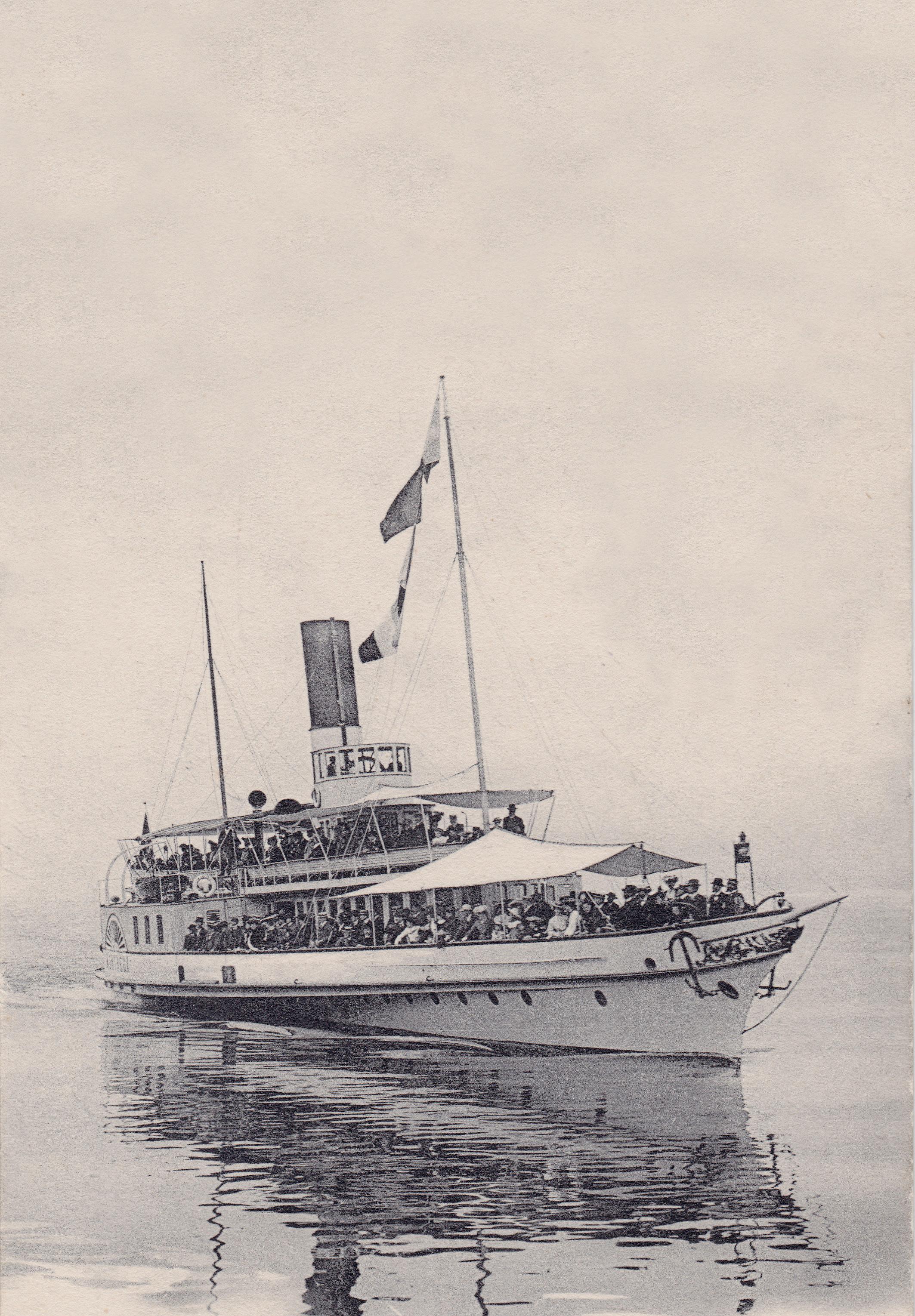
CE MAGAZINE VOUS EST OFFERT PAR THIS MAGAZINE IS BROUGHT TO YOU BY
°
13-2023
STEAM AHEAD MIT VOLLDAMPF VORAUS
spéciale 150 ans de la CGN FULL
Vif et souple, le célèbre vin du lézard se faufile sur un vignoble historique aux murs de roches en terrasses dans le Chablais vaudois. Élégant, fruité, à la minéralité subtile, le vin Murailles franchit les frontières pour séduire le plus grand nombre.
 Maison Henri Badoux Henri-badoux.ch
Maison Henri Badoux Henri-badoux.ch
Un ancrage fort
Chères lectrices, chers lecteurs, Lorsque l’on pense au Léman, toutes sortes d’images apparaissent : son environnement naturel d’exception, ses paysages romantiques ou ses couleurs spectaculaires qui changent au gré de l’humeur du ciel et qui n’en finissent pas d’envoûter riverains et touristes de passage.
Le Léman se caractérise aussi par ses acteurs incontournables : villages, villes, faune, pêcheurs, artisans, vignerons et marins. Eux tous ont fait de la CGN ce qu’elle est aujourd’hui et son ancrage au Léman est célébré par le biais d’événements et d’offres spéciales tout au long de l’année pour ses 150 ans.
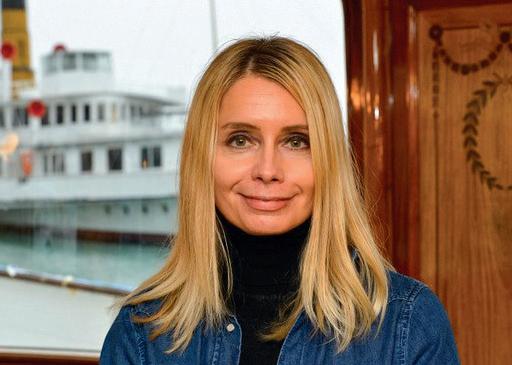
Dans cette édition, vous pourrez découvrir les détails du projet « Ici le lac ressemble à la mer » mené par le chanteur Marc Aymon et le Musée du Léman et voyager dans le temps avec la rétrospective historique de la Compagnie, depuis sa création en 1873 jusqu’à ce qu’elle est aujourd’hui, une entreprise dynamique, orientée vers l’avenir, avec une forte identité et qui écrit son présent et son futur en ayant à cœur ses missions de transport public, de développement touristique et de sauvegarde du patrimoine. ✵
A strong attachment
Dear readers,
When we think of Lake Geneva, all kinds of images spring to mind: its outstanding natural surroundings, its romantic landscapes or its spectacular colours that change with the moods of the sky and never cease to bewitch residents and passing tourists alike.

Lake Geneva is also characterised by its essential players: villages, towns, wildlife, fishermen, craftsmen, winemakers and sailors. They have all made the CGN what it is today, and its attachment to Lake Geneva is celebrated through events and special offers organised throughout the year to mark its 150th anniversary.
In this edition, you will learn about the “Ici le lac ressemble à la mer” project, led by the singer Marc Aymon and the Musée du Léman, and travel through time with the historical retrospective of the Company from its creation in 1873 until the present day, a dynamic, forward-looking company with a strong identity which writes its present and future while focussing on its tasks of public transport, tourist development and heritage conservation. ✵
Eine starke Verwurzelung
Liebe Leserinnen und Leser
Wer an den Genfersee denkt, sieht viele Bilder vor sich – die aussergewöhnliche naturbelassene Umwelt, die verträumten Landschaften oder die spektakulären Farben, die sich je nach Laune des Himmels ändern und Anwohner und Besucher seit eh und je in ihren Bann ziehen.
Aber auch Dörfer und Städte, die Tierwelt sowie die Fischer, Handwerker, Winzer und Binnenschiffer sind aus diesem Mikrokosmos nicht wegzudenken. Sie alle haben die CGN zu dem gemacht, was sie heute ist. Und so wird ihre Verwurzelung mit dem Genfersee im Jahr ihres 150-jährigen Bestehens mit zahlreichen Ereignissen und Sonderangeboten gefeiert.
Diese Ausgabe enthält ein Porträt des Projekts «Ici le lac ressemble à la mer» des Liedermachers Marc Aymon und des Musée du Léman. Ebenso gehen Sie auf eine Zeitreise mit dieser Gesellschaft von ihrer Gründung 1873 bis heute. Freuen Sie sich auf ein dynamisches und zukunftsorientiertes Unternehmen mit ausgeprägter Identität, das seinem Auftrag als öffentlicher Verkehrsbetrieb und seinem Beitrag zur Entwicklung des Tourismus und zur Erhaltung dieses Kulturerbes aktuell und künftig höchste Bedeutung beimisst. ✵
Vous avez une remarque, une question ou une proposition à nous faire concernant le magazine ou un autre sujet?
N’hésitez pas à nous contacter par e-mail à info@cgn.ch ou par courrier à CGN, avenue de Rhodanie 17, case postale 390, 1001 Lausanne. Nous nous réjouissons de votre prise de contact!
Do you have a comment, a question or a proposal for us concerning the magazine or any other topic?
Please do not hesitate to contact us by e-mail at info@cgn.ch or by letter at CGN, Avenue de Rhodanie 17, Case postale 390, 1001 Lausanne. We are looking forward to hearing from you!

Haben Sie Bemerkungen oder Vorschläge über unser Magazin oder auch über andere Themen, lassen Sie es uns bitte wissen. Untenstehend finden Sie die Kontakte.
E-mail: info@cgn.ch oder per Post an CGN, Avenue de Rhodanie 17, Case postale 390, 1001 Lausanne. Ihre Meinung interessiert uns sehr!
À TOUTE VAPEUR / / / FULL STEAM AHEAD / / / MIT VOLLDAMPF VORAUS 3 Éditorial
ÉVELYNE CHEVALLAZ BELOTTI RÉDACTRICE EN CHEF, RESPONSABLE COMMUNICATION & ADMINISTRATION DE L’ABVL EDITOR-IN-CHIEF, HEAD OF COMMUNICATION & ADMINISTRATION FOR THE ABVL CHEFREDAKTORIN, LEITERIN KOMMUNIKATION UND ADMINISTRATION DER ABVL
Français English Deutsch
© Stéphane Mischler



BALADE EN TRAIN À VAPEUR TOUS LES WEEK-ENDS DE MAI À OCTOBRE blonay-chamby.ch FESTIVAL SUISSE DE LA VAPEUR 27 AU 29 MAI Avec l’aimable soutien des communes du district Riviera-Pays-d’Enhaut ÉVÉNEMENTS 2023 LE CHABLAIS EN FÊTE 9-10 & 16-17 SEPTEMBRE
: Gilles Durgniat
photo
150 ans d’histoire au cœur du Léman
Chères passagères, chers passagers, C’est sur le Léman que s’élançait, il y a deux siècles, le Guillaume Tell, premier bateau à vapeur de Suisse. Il ouvrait un siècle de dynamisme industriel sans précédent : une partie importante de l’histoire économique et technologique du pays s’est écrite sur ses lacs.


Au premier vapeur ont succédé de très nombreux et magnifiques bâtiments. La navigation sur le Léman avait alors avant tout pour but le transport de personnes et de marchandises. En 1873, face à la concurrence croissante du chemin de fer, les principales compagnies propriétaires de bateaux fusionnent pour former la Compagnie Générale de Navigation sur le lac Léman, la CGN.

150 ans plus tard, la CGN entretient une flotte unique au monde, comprenant désormais sept bateaux historiques en état de naviguer. Par ses croisières touristiques, elle met à la portée de tous le Léman, les paysages qui l’entourent et le patrimoine de la Belle Époque. Et, enfin, la CGN assure des services essentiels de transport public entre les deux rives, indispensables à la prospérité économique régionale.
En plus de passagers fidèles et de plus en plus nombreux, la CGN peut compter sur des soutiens financiers constants des collectivités publiques suisses et françaises et sur celui, indéfectible, des 20 000 adhérents de l’Association des amis des bateaux à vapeur du Léman. Sans eux, sans vous, le Léman ne verrait pas circuler la flotte Belle Époque qui fait sa renommée loin à la ronde.

L’an passé, cette flotte était complétée par le Rhône : le dernier bateau à roues à aubes entièrement construit en Suisse a été remis en service après une restauration complète. Et, en cette année de jubilé, c’est un bateau hybride à la pointe de la technologie qui sera mis en service, pour renforcer les lignes de transport public et répondre au défi climatique. Les années à venir ne manquent pas de défis : la CGN prévoit l’ouverture d’une liaison entre les deux rives genevoises et démarrera l’étude de variantes de restauration pour l’Helvétie, dernier bateau de notre flotte Belle Époque aujourd’hui encore hors service. Soigner le patrimoine, développer le transport public et la navigation de plaisance sur le Léman, tout en adoptant les technologies modernes : en faisant tout cela, la CGN s’inscrit aujourd’hui pleinement dans son siècle et demi d’histoire. Nous nous réjouissons de fêter, tout au long de 2023, nos 150 ans avec vous ! ✵
150 years of history at the heart of the Lake Geneva area
Dear passengers,
It was two centuries ago that the Guillaume Tell, Switzerland’s first steamboat, graced the waters of Lake Geneva, heralding in a century of unprecedented industrial momentum: a large part of the economic and technological history of the country was written on its lakes. The first steamboat was followed by a number of magnificent vessels. Shipping on Lake Geneva was primarily geared towards transporting passengers and cargo. In 1873, in light of the growing competition from the railway, the main shipping companies merged to form the Compagnie Générale de Navigation sur le lac Léman. 150 years later, the CGN maintains a unique fleet, which once again includes seven historic boats in seaworthy condition. Through its tourist cruises, it offers everyone the chance to discover Lake Geneva, the surrounding countryside and the heritage of the Belle Époque. Finally, it also provides an essential public transport service between the two shores that is key to the economic prosperity of the region.
In addition to the large number of regular passengers, the Company can count on constant support from the French and Swiss authorities. In particular, however, its long-term activity is guaranteed by the unwavering support of the 20,000 members of the Association des amis des bateaux à vapeur du Léman. Without them and without you, Lake Geneva would not be graced by the Belle Époque fleet which has spread its fame far and wide.
Last year, the fleet was joined by the Rhône : the last paddle steamer built entirely in Switzerland returned to service following a complete renovation. And in this anniversary year, a hybrid vessel boasting cutting-edge technology will be brought into service to further improve the public transport service while addressing the challenge of climate change. And more challenges will be taken up in the years to come: the CGN is planning to open a service between the two shores in Geneva and will also begin studying restoration alternatives for the Helvétie, the last boat in our Belle Époque fleet that is still out of service.
Maintaining local heritage, developing transport and recreational services on Lake Geneva while adopting modern technologies... With a story dating back 150 years, the CGN continues to write history. It is therefore under the banner of this sense of continuity, and most importantly with you, that the Company intends to celebrate its 150th anniversary. We are delighted to celebrate this event with you throughout the year. ✵
150 Jahre Geschichte auf dem Genfersee
Liebe Fahrgäste,
Vor 200 Jahren machte die Guillaume Tell als erstes Dampfschiff auf dem Genfersee seine Leinen los. Damit begann ein einmaliges Industriezeitalter, und so wurde ein wesentlicher Teil der Wirtschafts- und Technologiegeschichte des Landes auf Binnenseen geschrieben.
Auf das erste Dampfschiff folgten zahlreiche grossartige Bauten. Hauptzweck der Schifffahrt auf dem Genfersee war die Beförderung von Personen und Waren. Aufgrund der Konkurrenz durch die Eisenbahn schlossen sich die grössten Schifffahrtsgesellschaften im Jahr 1873 zur Compagnie Générale de Navigation sur le lac Léman zusammen.

150 Jahre später unterhält die CGN eine einzigartige Flotte mit nunmehr sieben fahrtüchtigen historischen Schiffen. Dank ihrer Ausflugsfahrten sind die umliegenden Landschaften und das Erbe der Belle Époque inzwischen von jedermann zu bewundern. Ausserdem sorgt die CGN für den wichtigen öffentlichen Verkehr zwischen beiden Seeseiten, der für die regionale Wirtschaft unentbehrlich ist.
Neben zahlreichen Fahrgästen kann die Gesellschaft auf die konstante Unterstützung der öffentlichen Körperschaften in der Schweiz und Frankreich zählen. Dass sie ihren Betrieb fortwährend aufrechterhalten kann, ist aber auch der unablässigen Unterstützung der 20’000 Gönner der Association des amis des bateaux à vapeur du Léman zu verdanken. Ohne diese Unterstützer und ohne Sie, verehrte Fahrgäste, gäbe es heute auf dem Genfersee keine weit und breit bekannte Belle Époque-Flotte.
Letztes Jahr gesellte sich die Rhône dazu, d.h. der letzte vollständig in der Schweiz gebaute Schaufelraddampfer, der nach einer umfassenden Instandsetzung wieder in Betrieb genommen wurde. In diesem Jubiläumsjahr wird ein hochmodernes Hybridschiff vom Stapel laufen und den öffentlichen Liniendienst verstärken und einen Beitrag zur Bekämpfung des Klimawandels leisten. Auch die nächsten Jahre sind gespickt von Herausforderungen. So plant die CGN die Eröffnung einer Verbindung zwischen beiden Genfer Seeseiten und wird im Rahmen einer Studie ausloten, wie die Helvétie und damit das letzte noch stillgelegte Schiff unserer Belle Époque-Flotte, restauriert werden kann. Durch die Pflege dieses Erbes und die Entwicklung des öffentlichen Verkehrs und der Vergnügungsschifffahrt auf dem Genfersee mit hochmoderner Technologie hat sich die CGN im Laufe ihrer 150-jährigen Geschichte selbst ein Denkmal gesetzt. Gestärkt durch diese Konstanz, aber auch durch Ihre Gegenwart möchte die Gesellschaft ihr 150-jähriges Bestehen begehen. Wir freuen uns darauf, dieses Jubiläum das ganze Jahr über mit Ihnen zu feiern! ✵
À TOUTE VAPEUR / / / FULL STEAM AHEAD / / / MIT VOLLDAMPF VORAUS 5
MAURICE DECOPPET PRÉSIDENT, ABVL PRESIDENT, ABVL PRÄSIDENT, ABVL Éditorial
BENOÎT GAILLARD PRÉSIDENT DU CONSEIL D’ADMINISTRATION, GROUPE CGN SA
CHAIRMAN OF THE BOARD OF DIRECTORS, CGN GROUP LTD VERWALTUNGSRATSPRÄSIDENT, CGN GRUPPE AG
(Re)découvrez le site culturel millénaire…
AQUATIS invite les visiteurs à se plonger dans un voyage sur les cinq continents à la découverte des principaux écosystèmes d’eau douce. Europe, Afrique, Asie, Océanie et Amérique… un parcours exceptionnel !


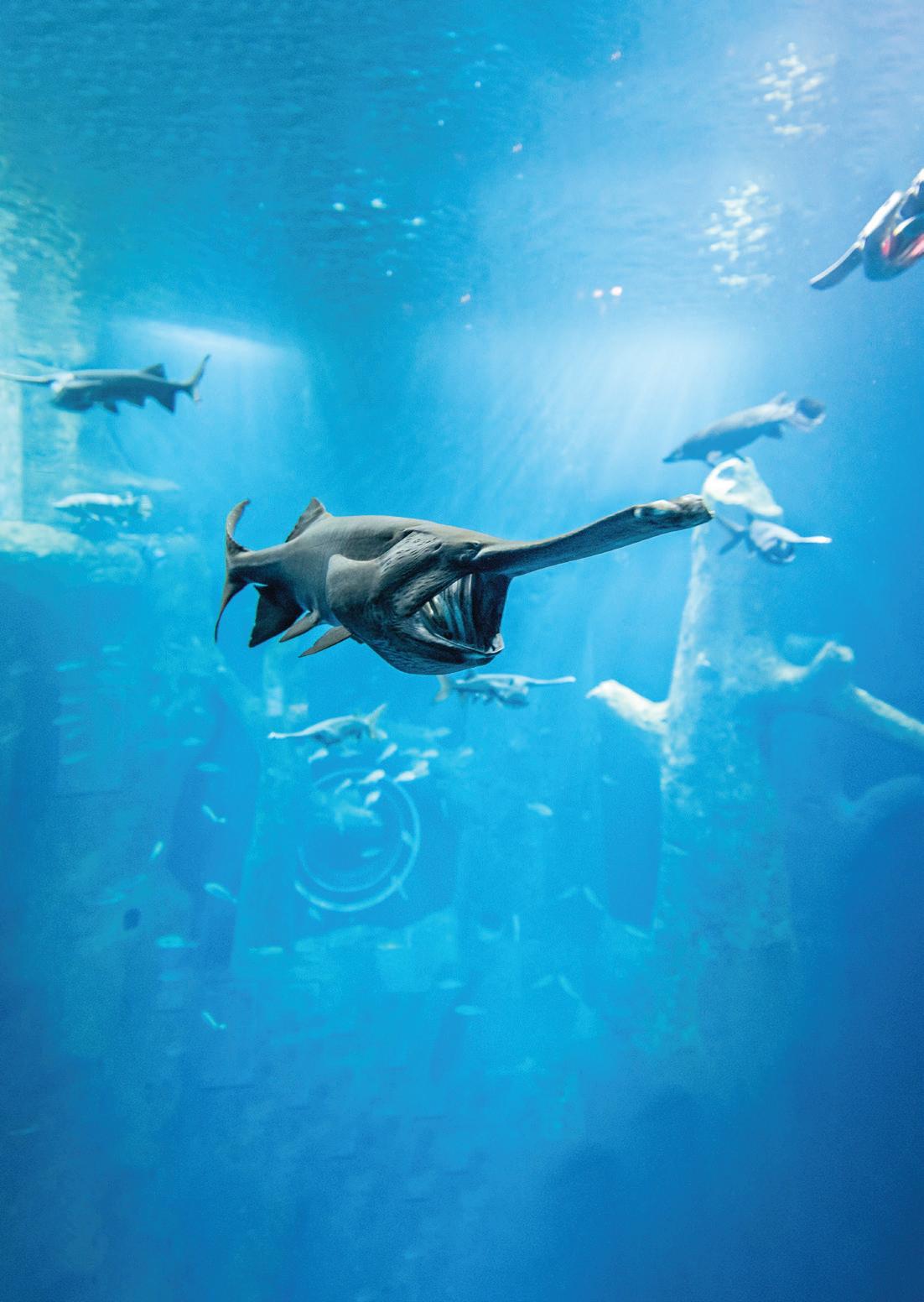
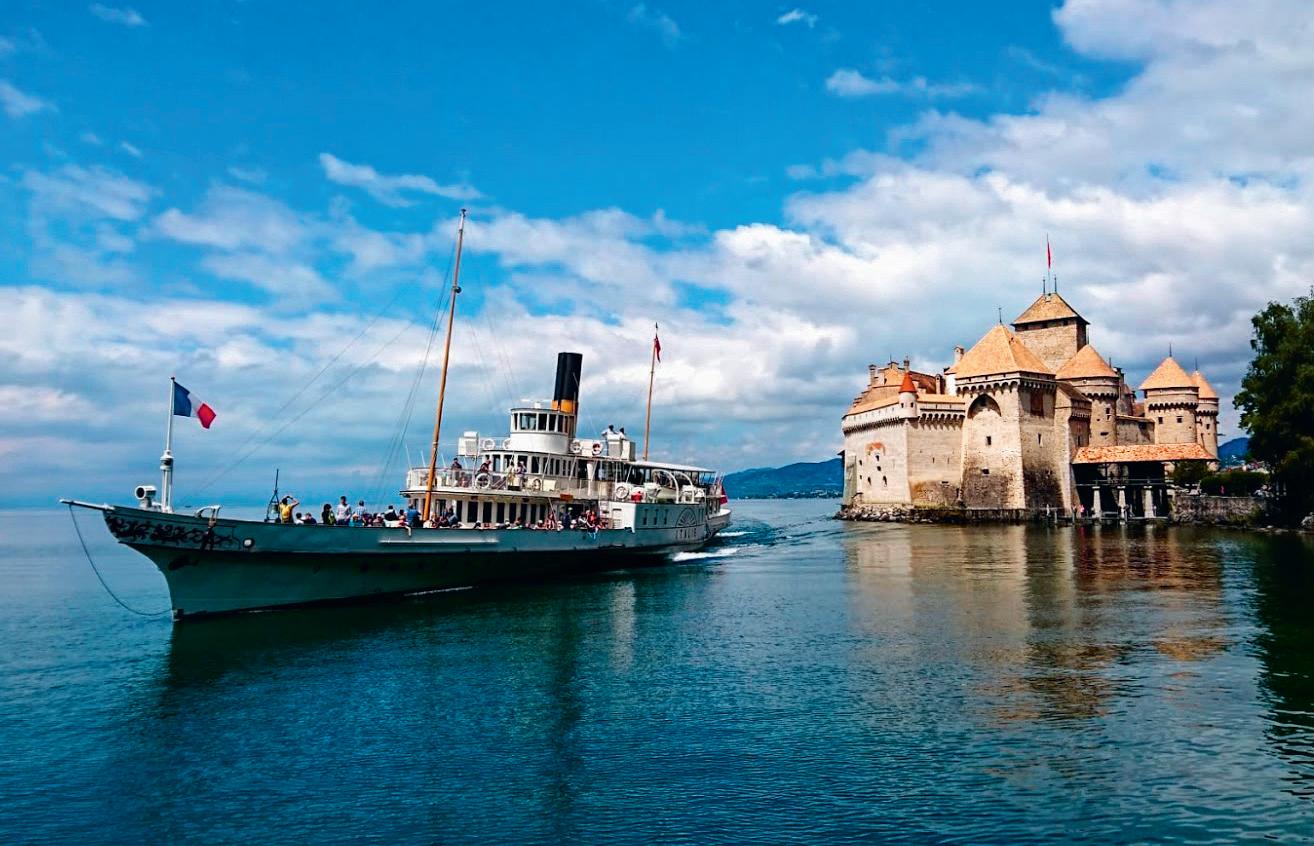
RESTAURANTS – BOUTIQUE – BAR
HOTEL – PARKING – METRO
OUVERT
#chillon #chateauchillon
info@aquatis.ch
www.chillon.ch AQUATIS Aquarium-Vivarium – Route de Berne 144 – 1010 Lausanne / Vennes
– +41 (0)21 654 23 23 – aquatis.ch
Préparez votre visite : scannez le QRCode.
TOUS
LES JOURS, TOUTE L’ANNÉE !
AQUATIS s’engage en faveur de la conservation des espèces et de leurs écosystèmes.
N° 13
À TOUTE VAPEUR FULL STEAM AHEAD MIT VOLLDAMPF VORAUS Le magazine de la CGN et de l’ABVL
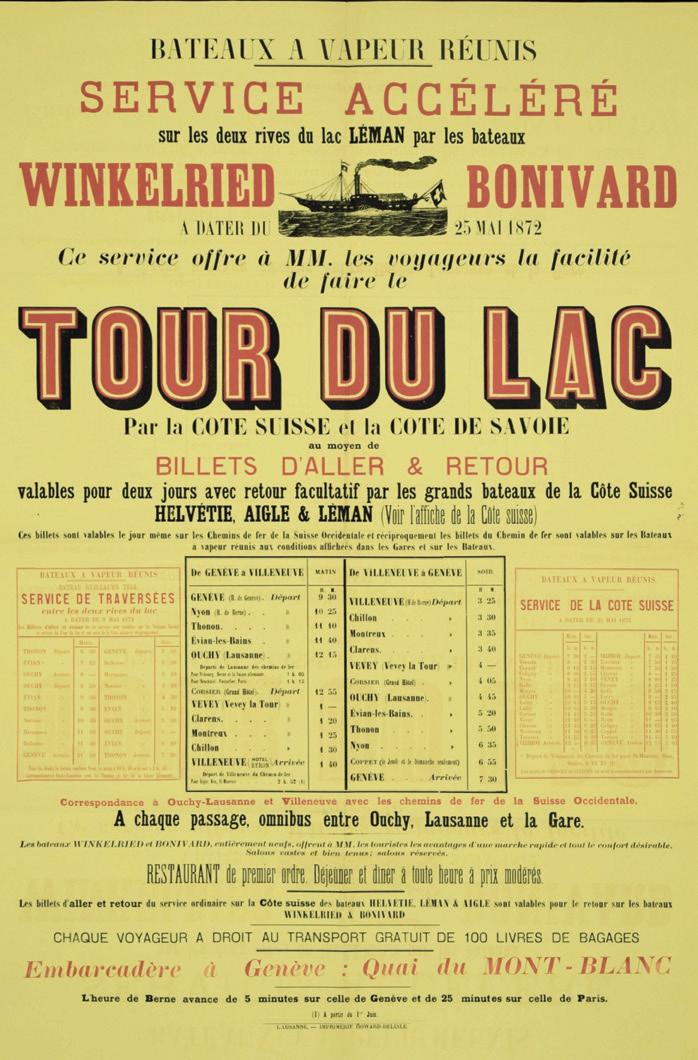

RÉDACTRICE EN CHEF/ EDITOR-IN-CHIEF
Evelyne Chevallaz Belotti
COORDINATION/ COORDINATION
Clément Grandjean, Fanny Mayor
Terre&Nature Publications SA
MISE EN PAGES/ LAYOUT Charlotte Panchaud-Vesin
Terre&Nature Publications SA
RÉDACTEURS/ EDITORS CGN
Evelyne Chevallaz Belotti
Maurice Decoppet
Mireille Jaccard
Camille Saladin
TRADUCTIONS/ TRANSLATIONS
Apostroph Group
CORRECTIONS/ PROOFREADING
Adeline Vanoverbeke (français)
PUBLICITÉ/ ADVERTORIAL Elodie Amianti Terre&Nature Publications SA
Chemin des Tuilières 3 1028 Prévengres Tél. 021 695 95 95
TIRAGE/ NUMBER OF COPIES 25 000 exemplaires IMPRIMERIE/ PRINTER PCL Presses Centrales SA Avenue de Longemalle 9 1020 Renens Tél. 021 317 51 51
PHOTO DE COUVERTURE/ COVER PHOTO Ancienne carte postale Auteur inconnu Bateau-Salon «Montreux» - 1904
©ABVL
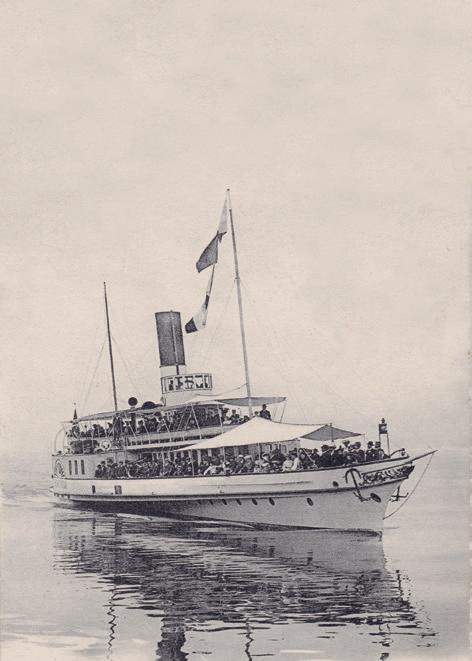
À TOUTE VAPEUR / / / FULL STEAM AHEAD / / / MIT VOLLDAMPF VORAUS 7 ÉDITORIAUX / EDITORIALS Un ancrage fort A strong attachment 1 150 ans d’histoire au cœur du Léman 150 years of history at the heart of the Lake Geneva area 3 LA CGN La CGN en chiffres The CGN in figures 8 La flotte CGN en 2023 The CGN fleet in 2023 10 L’ABVL Présentation Présentation 16 L’ABVL a besoin de vous The ABVL needs your help 18 Rejoignez l’ABVL! Join the ABVL! 19 UNE SAGA LACUSTRE DE 200 ANS A 200 YEARS SAGA ON THE LAKE Introduction Introduction 20 Frise chronologique Timeline 22
à toute vapeur N° 13 CE MAGAZINE VOUS EST OFFERT PAR N° 13-2023 PUB Edition spéciale 150 ans de la CGN FULL STEAM AHEAD MIT VOLLDAMPF VORAUS N° 13 I 2023 Sommaire © Collection du Musée du Léman / Bertrand Francey


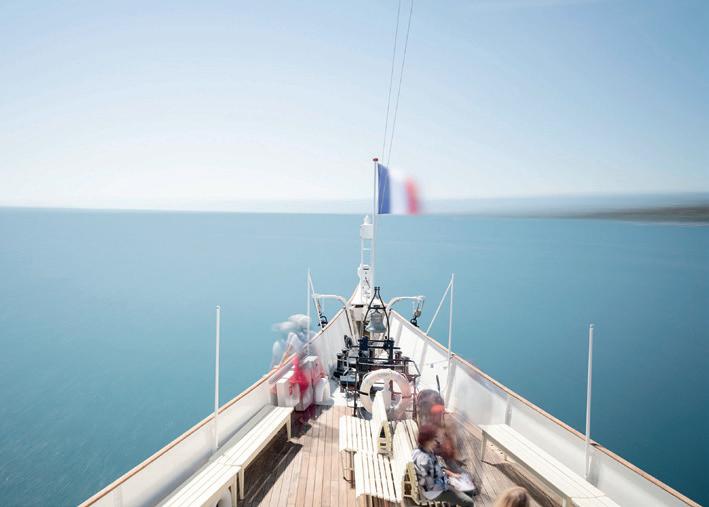
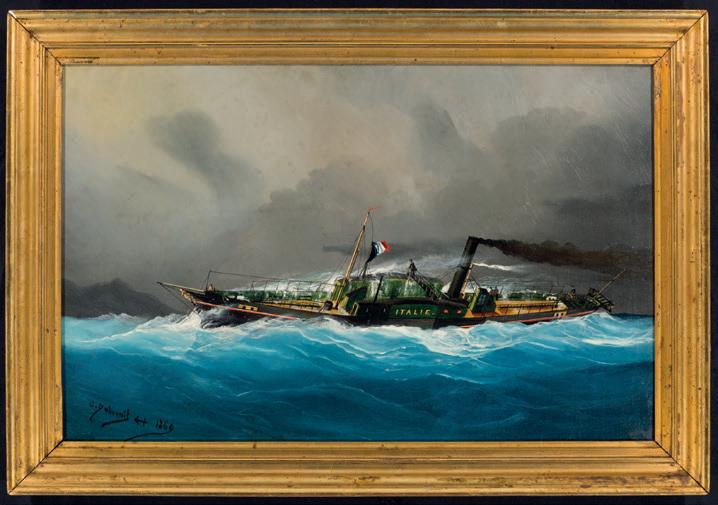
8 À TOUTE VAPEUR / / / FULL STEAM AHEAD / / / MIT VOLLDAMPF VORAUS
1823-1870 24 1870-1880 26 1880-1930 28 1930-1950 30 1950-1965 32 1965-1990 34 1990-2002 36 2002-2011 38 2011-2018 40 2018-2023 42 Culture 44 150 ANS DE LA CGN 150TH ANNIVERSARY OF CGN Introduction Introduction 46 Marc Aymon, l’étendue sentimentale Marc Aymon, the full sentimental range 49
150TH
Janvier - Festivités January 52 Février - Romantisme February 54 Mars - Villes March 56 Avril - Ports April 58 Mai - Belle Époque May 60 Juin - Faune June 62 Juillet - Patrimoine naturel July 64 Août - Jardins August 66 Septembre - Innovation September 68 Octobre - Vins October 70 Novembre - Navigants November 72 Décembre - Solidarité December 74 TEXTES EN ALLEMAND DEUTSCHER TEXT 78 ©
Sommaire
150
ANS DE LA CGN
ANNIVERSARY OF CGN
Matthieu Gafsou / Clément Grandjean / Collection du Musée du Léman
L’histoire en direct
Situation
Visite
Découvrez l’un des secrets les mieux gardés de Suisse. De l’aventure du soldat au réduit national Suisse. Des ambiances visuelles et sonores émouvantes et ludiques.

Forteresse de 2125 m2 plus de 20 pièces immersives. Se visite comme un parc d’attractions.
Interactivité
Pénétrez dans l’intimité de la stratégie militaire au travers de jeux, de quizz, de réalité virtuelle et 3D.

Des transports
En savoir plus: www.shiptec.ch/transport-public

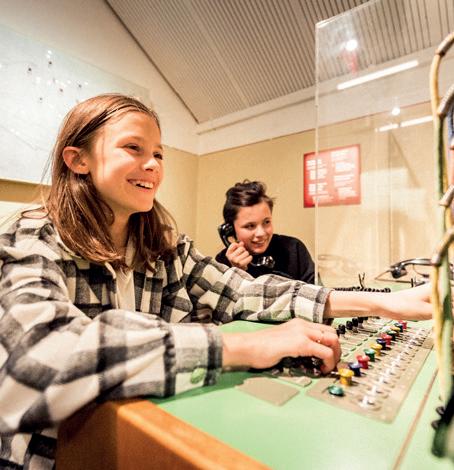
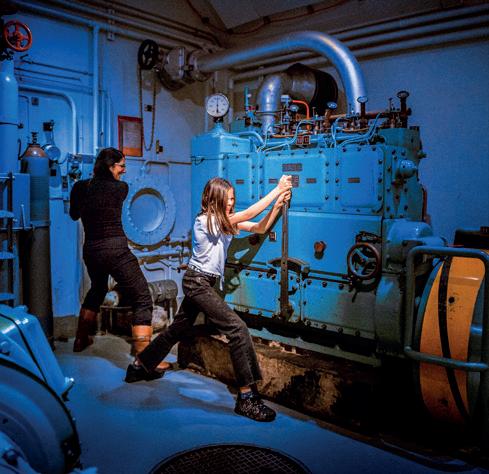
d‘avenir






À TOUTE VAPEUR / / / FULL STEAM AHEAD / / / MIT VOLLDAMPF VORAUS 9
Château
Fort de Chillon
+41 21 552 44 55 info@fortdechillon.ch fortdechillon.ch
Débarcadère
publics
Shiptec construit les produits pour le raccourci par l’eau.
LA CGN EN CHIFFRES
THE CGN IN FIGURES
2,5 millions
de passagers transportés en 2022 // passengers transported in 2022
3 missions : transport public aide au développement touristique conservation du patrimoine tasks : public transport tourism development assistance heritage conservation
256 employés // employees
20 métiers différents // different professions
43 ports desservis // ports served
100 traversées sur l’ensemble des 3 lignes (N1 Lausanne-Evian, N2 Lausanne-Thonon, N3 Nyon-Yvoire)
crossings on all 3 lines (N1 Lausanne-Evian, N2 Lausanne-Thonon, N3 Nyon-Yvoire)
513’000 km parcourus en 2022 // traveled in 2022
10 À TOUTE VAPEUR / / / FULL STEAM AHEAD / / / MIT VOLLDAMPF VORAUS
18 bateaux // boats
8 bateaux Belle Époque Belle Époque boats
1
4 vedettes speedboats bateau à haute technologie hybride ( 2 en 2024 ) hybrid vessel boasting cutting-edge technology ( 2 in 2024 )
5 bateaux contemporains contemporary boats
1 chantier naval shipyard
7 ateliers techniques dédiés à la maintenance de la flotte technical workshops dedicated to fleet maintenance
1560 m2
de panneaux photovoltaïques dernière génération sur les toitures du chantier naval, ils couvrent 40% de la consommation électrique du site of latest generation photovoltaic panels on the roofs of the shipyard, they cover 40% of the the site’s electricity consumption
À TOUTE VAPEUR / / / FULL STEAM AHEAD / / / MIT VOLLDAMPF VORAUS 11
LA FLOTTE CGN EN 2023
THE CGN FLEET IN 2023
Constituée de 18 unités (19 en 2024), la flotte de la CGN permet jour après jour d’assurer les missions de la Compagnie. Les bateaux contemporains sont dédiés au transport public et les bateaux Belle Époque assurent une desserte attractive des destinations touristiques.

CGN's fleet of 18 vessels (19 by 2024) is used to carry out the company's missions on a daily basis. The contemporary boats are dedicated to public transport and the Belle Époque boats provide an attractive touristic service.
LA FLOTTE BELLE ÉPOQUE
Témoin du passé et ambassadrice du patrimoine lémanique, la plus grande flotte Belle Époque du monde encore en activité fascine et inspire touristes et locaux. La flotte est constituée de huit bateaux homogènes, tous issus du même constructeur naval mais dont chacun a sa particularité et une atmosphère qui le rend unique.

Awitness to the past and an ambassador for the heritage of Lake Geneva, the largest Belle Époque fleet in the world still in operation inspires tourists and locals. The fleet is made up of eight homogeneous boats, all from the same shipbuilder, but each with its own particularity and atmosphere.

12 À TOUTE VAPEUR / / / FULL STEAM AHEAD / / / MIT VOLLDAMPF VORAUS 66 m 14 m 363 t 560 540 kW MONTREUX — 1904 — VEVEY — 1907 — ITALIE — 1908 — 66 m 14 m 350 t 560 540 kW VAPEUR / STEAMER 68,3 m 14,3 m 375 t 560 650 kW (885 CV/HP) DIESEL-ÉLECTRIQUE / DIESEL-ELECTRIC DIESEL-ÉLECTRIQUE / DIESEL-ELECTRIC
Bateau amiral de la flotte CGN Flagship of the CGN fleet




DÉSARMÉ DEPUIS 2002, EN ATTENTE D’UNE RÉNOVATION GÉNÉRALE

À TOUTE VAPEUR / / / FULL STEAM AHEAD / / / MIT VOLLDAMPF VORAUS 13 68 m 14,3 m 367 t 700 625 kW (850 CV/HP) 78,5 m 15,9 m 468 t 850 78,5 m 15,9 m 553 t 850 1030 kW (1400 CV/HP) 68 m 14,3 m 367 t 600 660 kW (900 CV/HP) 78,5 m 15,9 m 608 t 850 1030 kW (1400 CV/HP)
SUISSE —
— SIMPLON — 1915-1920 —
SAVOIE
— ©CGN VAPEUR / STEAMER VAPEUR / STEAMER VAPEUR / STEAMER VAPEUR / STEAMER
LA
1910
HELVÉTIE — 1926 — RHÔNE — 1927 —
— 1914
LA FLOTTE CONTEMPORAINE
















14 À TOUTE VAPEUR / / / FULL STEAM AHEAD / / / MIT VOLLDAMPF VORAUS
BATEAU À HAUTE TECHNOLOGIE HYBRIDE BATEAUX CONTEMPORAINS À MOTEUR EVIAN-LES-BAINS NAVIEXPRESS — 2023 — HENRY-DUNANT — 1963 — GÉNÉRAL-GUISAN — 1964 — VILLE-DE-GENÈVE — 1978 — 61,3 m 2x920 kW avec
: 4x150 kW 700 50,2 m 2x440 kW 550 50,2 m 2x440 kW 550 47,2 m 2x550 kW 560
système de propulsion hybride parallèle/diesel-électrique - Batteries
















À TOUTE VAPEUR / / / FULL STEAM AHEAD / / / MIT VOLLDAMPF VORAUS 15 PETITS BATEAUX/VEDETTES LAUSANNE — 1991 — LÉMAN — 1990 — COL-VERT — 1960 — MORGES, LAVAUX, VALAIS — 2005, 2006, 2008 — 49,6 m 2x550 kW 780 78,8 m 2x870 kW 1200 28,3 m 294 kW 130 30,8 m 2x530 kW 200 ©ABVL
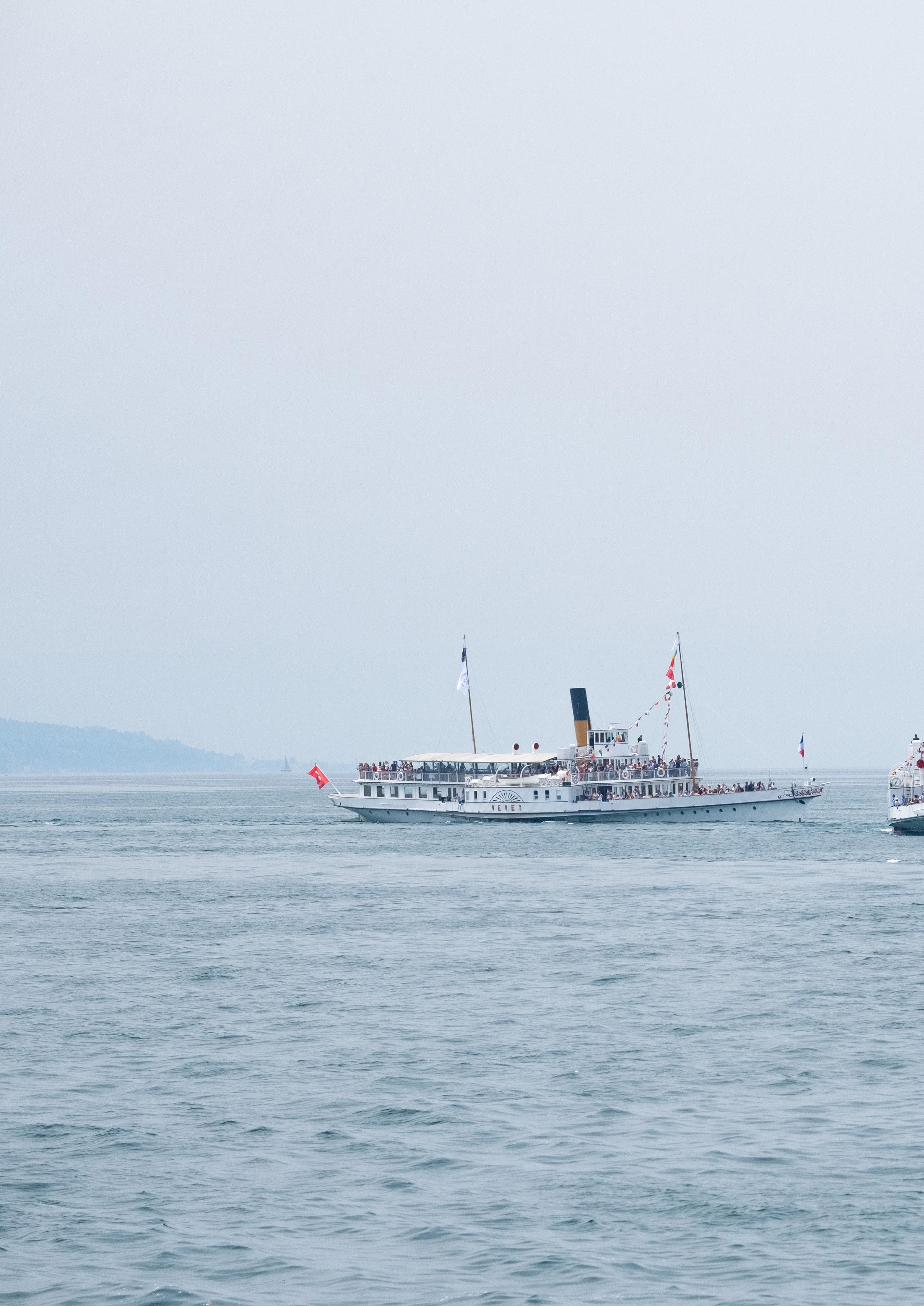
© Stéphane Mischler

L’ASSOCIATION DES AMIS DES BATEAUX À VAPEUR DU LÉMAN (ABVL)
LE PARTENAIRE PRINCIPAL DE LA CGN
POUR LA SAUVEGARDE DE LA FLOTTE BELLE ÉPOQUE DEPUIS PLUS DE 20 ANS
Fondée en juin 2002 par des passionnés soucieux de la survie de cette flotte qui se trouvait subitement en danger pour des raisons financières, l’Association des amis des bateaux à vapeur du Léman (ABVL) compte à ce jour près de 20 000 donateurs et quelque 4000 membres actifs.
Sa mission a pour but de rechercher des fonds pour la conservation et le maintien en service horaire des huit bateaux Belle Époque de la CGN. Grâce aux dons reçus par l’ABVL depuis vingt ans, les huit bateaux ont pu être partiellement ou totalement rénovés. À ce jour, près de 40 millions de francs au total ont été récoltés par l’ABVL. La part apportée par l’association représente environ le tiers du montant global investi pour les rénovations de cette flotte.
RÉNOVATIONS ET TRAVAUX FINANCÉS PAR L’ABVL
S/S Simplon (1920)
Deux rénovations partielles entre 2003 et 2005 et entre 2010 et 2011 : sablage de la coque, révision générale de la machine à vapeur d’origine, réhabilitation des salons de 1re et de 2e classe du pont principal et installation de propulseurs d’étrave. Durant l’hiver 2016-2017, retubage des deux chaudières datant de 1966. En 2021, l’ABVL a fourni à la CGN une garantie financière qui lui a permis de réaliser, hors budget, le sablage de la coque ainsi que le remplacement des arbres de roues à aubes d’origine, qui se sont révélés nécessaires en cours d’exercice.
En 2021, l’ABVL finance le remplacement des luminaires (plafonniers) de l’ensemble du bateau. En hiver 2022-2023, l’ABVL finance
la modernisation des cuisines et des offices.
S/S La Suisse (1910)
Financement de plus de 80% de la rénovation complète, pour un budget de 15 millions de francs, entre 2007 et 2009. Financement des chaises en rotin du pont supérieur et des nouveaux plafonniers en 2021, ainsi que du remplacement des arbres de roues à aubes d’origine en 2022.
S/S Montreux (1904)
Mise au point de la nouvelle machine à vapeur prototype et rénovation partielle du salon de 1re classe pendant l’hiver 2014-2015. En 2016, remplacement du surchauffeur de la chaudière. En hiver 2022-2023, l’ABVL finance, pour le pont supérieur, le remplacement des luminaires et un nouveau mobilier.
S/S Rhône (1927)
En 2011, mise en valeur du salon de 1re classe. Pour la machine à vapeur, financement du remplacement des capots métalliques faisant partie du système de graissage automatique et qui en obstruaient la vision, par des capots transparents en plexiglas. En 20192021, l’ABVL participe, avec 3 millions de francs, à la rénovation générale du bateau sur un budget de 15 843 000 francs, financé essentiellement pas les trois cantons riverains lémaniques.
Helvétie (1926)
Première rénovation partielle en 20112012, avec un carénage de conservation, le sablage de la coque et des roues à aubes, ainsi qu’une rénovation limitée des superstructures.
S/S Savoie (1914)
En 2011-2012, financement de la révision de la machine à vapeur d’origine et remplacement des chaises en rotin du pont supérieur en 2021.
M/S Vevey (1907)

Dans le cadre de la rénovation générale en 2012-2013, financement de luminaires de type Belle Époque dans le salon de 1re classe.
M/S Italie (1908)
L’ABVL a mis à disposition 9,6 millions de francs sur les 13,8 millions nécessaires à la rénovation complète, effectuée entre mai 2015 et octobre 2016.
LA FONDATION PRO VAPORE
L’ABVL a également créé une fondation en 2006, dont le siège est à Genève et dont le but statutaire est identique au sien, et à laquelle elle confie l’essentiel des fonds récoltés. Pro Vapore, contrôlée en tant que fondation par un organe de surveillance, est en effet la garante de la bonne gestion des sommes qui lui sont remises par l’association. Les deux sont inscrites au registre du commerce.
S/S = Steam Ship (bateau à vapeur)
M/S = Motor Ship (bateau à moteur, de type diesel-électrique sur ces bateaux à roues)
Scannez le code QR pour en savoir encore plus sur l’ABVL !
18 À TOUTE VAPEUR / / / FULL STEAM AHEAD / / / MIT VOLLDAMPF VORAUS
Founded in June 2002 by true enthusiasts keen to ensure the survival of this fleet which had suddenly found itself in danger for financial reasons, the Association des amis des bateaux à vapeur du Léman (ABVL) now boasts some 20,000 sponsors and 4,000 active members.
Its mission is to secure funding for the conservation and continued regular service of the eight Belle Époque vessels of the CGN. Thanks to the donations collected by the ABVL over twenty years, all eight boats have been partially or fully renovated. To date, the ABVL has collected donations totalling almost 40 million Swiss francs. The proportion provided by the association represents approximately one-third of the total amount invested in renovating the fleet
RENOVATIONS AND WORK FUNDED BY THE ABVL
S/S Simplon (1920)
Two partial renovations between 2003 and 2005 and between 2010 and 2011: sanding of the hull, general overhaul of the original steam engine, rehabilitation of the 1st and 2nd class saloons on the main deck and installation of bow thrusters. During winter 2016-2017, retubing of the two boilers dating back to 1966. In 2021, the ABVL provided the CGN a financial guarantee enabling it, off budget, to sand the hull and replace the wheel shafts of the original paddle wheels, work which had become necessary during the year.
In 2021, the ABVL funded the replacement of the ceiling lights throughout the boat.
THE ASSOCIATION DES AMIS DES BATEAUX À VAPEUR DU LÉMAN (ABVL)
THE MAIN PARTNER OF THE CGN FOR THE SAFEGUARD OF THE BELLE ÉPOQUE FLEET FOR OVER 20 YEARS
In winter 2022-2023, the ABVL also funded the modernisation of the galleys and pantries.
S/S La Suisse (1910)
Funding of over 80% of the complete renovation for a budget of 15 million Swiss francs between 2007 and 2009. Funding of rattan chairs on the upper deck and new ceiling lights in 2021, as well as the replacement of the wheel shafts of the original paddles wheels in 2022.
S/S Montreux (1904)
Creation of a new prototype steam engine and partial renovation of the 1st class saloon during winter 2014-2015. In 2016, replacement of the superheater of the boiler.
In winter 2022-2023, the ABVL funded the replacement of the lights and new furniture on the upper deck.
S/S
Rhône (1927)
In 2011, enhancement of the 1st class lounge. For the steam engine, funding of the replacement of the metal covers in the automatic lubrication system, which blocked the passengers’ view, with transparent Plexiglas covers. In 2019-2021, the ABVL contributed with 3 million francs to the general renovation of the boat, costing a total of 15,843,000 francs, primarily funded by the three cantons of Lake Geneva.
Helvétie
(1926)
First partial renovation in 2011-2012 with a protective fairing, the sanding of the hull and the paddle wheels and a limited renovation of the superstructures.
S/S
Savoie (1914)
In 2011-2012, funding of the overhaul of the original steam engine and replacement of the rattan chairs on the upper deck in 2021.
M/S
Vevey (1907)
As part of the general renovation of 2012-2013, funding of the Belle Époque lights in the 1st class saloon.
M/S Italie (1908)
The ABVL provided 9.6 million francs of the 13.8 million necessary for the complete renovation, carried out between May 2015 and October 2016.
LA FONDATION PRO VAPORE
In 2006, the ABVL also created a foundation based in Geneva with the same statutory purpose as its own, to which it entrusts the funds collected. Operating as a foundation under the auspices of a supervisory body, Pro Vapore ensures the correct management of the funds entrusted to it by the association. Both organisations are registered on the trade register.
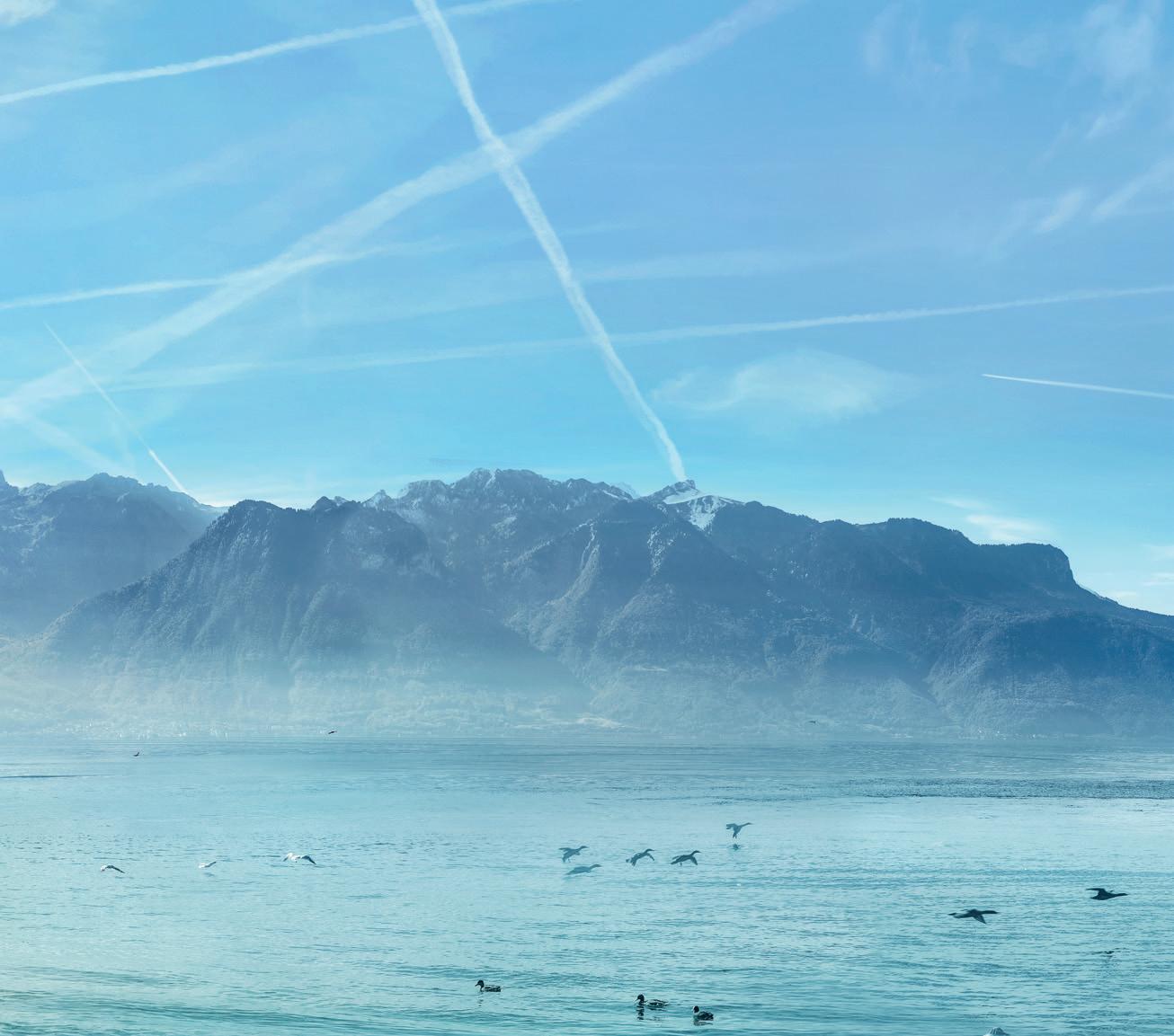
S/S = Steam Ship
M/S = Motor Ship (diesel-electric motor on these paddle steamers)
Scan the QR code to find out even more about the ABVL!
À TOUTE VAPEUR / / / FULL STEAM AHEAD / / / MIT VOLLDAMPF VORAUS 19
DEUTSCHER TEXT Seiten 78 - 88 © Adobe Stock
Participez à la sauvegarde d’une flotte unique au monde !
Depuis plus de 20 ans, l’Association des amis des bateaux à vapeur du Léman (ABVL) s’engage pour que les huit bateaux Belle Époque de la CGN puissent un jour à nouveau fendre les flots du Léman au complet
Si cette flotte est classée « monument historique d’importance nationale » depuis 2011, ce qui la met à l’abri de la destruction, son entretien dans le meilleur état de conservation possible demande un investissement financier conséquent, dont une partie importante doit provenir de fonds privés. Parmi les huit bateaux de la flotte historique de la CGN, sept sont actuellement en état de naviguer : La Suisse, le Rhône, le Montreux, le Savoie, le Vevey et l’Italie ont été entièrement rénovés. Le Simplon a quant à lui bénéficié de trois restaurations partielles, mais reste en attente d’une dernière rénovation lourde. Aujourd’hui, seul l’Helvétie est arrêté. Retiré de la navigation en 2002, il nécessite une restauration complète. Notre association s’est engagée à financer les avant-projets de rénovation tant de l’Helvétie que du Simplon, et nous sommes confiants que les travaux vont démarrer d’ici à quelques années, probablement à partir de 2025-2026. Nous nous sommes fixés comme objectif de contribuer au retour en navigation, à l’horizon 2030, des huit bateaux Belle Époque de la CGN entièrement restaurés. Pour atteindre cet objectif ambitieux, nous avons besoin de vous.
Chaque don compte! Sans l’engagement indéfectible de l’ABVL depuis plus de vingt ans en faveur de la flotte Belle Époque de la CGN, ne seraient restés vraisemblablement aujourd’hui plus qu’un ou deux bateaux à roues à aubes en navigation, comme La Suisse et le Savoie.
Rejoignez-nous comme donatrice ou donateur par un versement
EN SUISSE
La Poste Suisse – CCP 17-197675-0
IBAN: CH61 0900 0000 1719 7675 0
EN SUISSE OU DEPUIS L’ÉTRANGER PAR VIREMENT BANCAIRE
• En francs suisses: UBS Compte «ABVL»
IBAN: CH62 0024 3243 4589 5701 H
• En euros: UBS Compte «ABVL»
IBAN: CH 68 0024 3243 4589 5761 K
EN FRANCE
La Lyonnaise de Banque (compte en euros)
Compte: 00032572501
IBAN: FR76 1009 6182 2900 0325 7250 178
BIC CMCIFRPP
Participate in conserving a fleet that is unique worldwide!
For over 20 years, the Association des amis des bateaux à vapeur du Léman (ABVL) has played a major role in ensuring that the eight Belle Époque vessels of the CGN can once again ply the waters of Lake Geneva all together
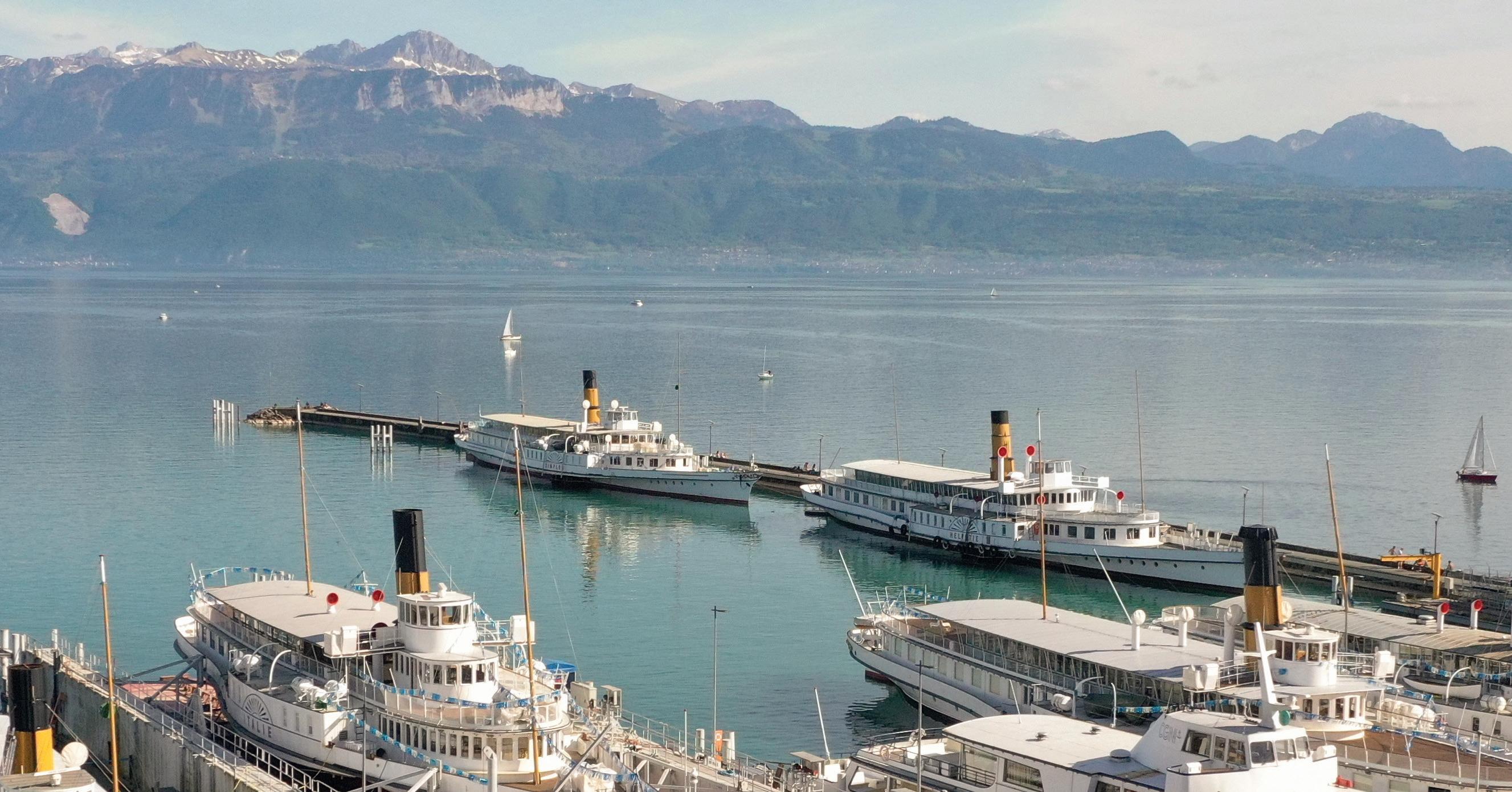
While this fleet has been classified a “historical monument of national importance” since 2011, meaning that it cannot be destroyed, maintaining it in the best possible state of conservation requires a major financial investment, part of which must be provided through private funds.
Of the eight boats in the historic CGN fleet, seven are currently seaworthy: La Suisse, the Rhône, the Montreux, the Savoie, the Vevey and the Italie have been fully renovated. The Simplon has enjoyed three partial renovations but still requires a final major overhaul. Today, only the Helvétie is laid up. Withdrawn from service in 2002, it is in need of a complete rehabilitation. Our association has undertaken to fund the pre-renovation projects on both the Helvétie and the Simplon , and we are confident that the work will begin within a few years, probably from 2025-2026.
We have set ourselves the goal of contributing to the return to service of all eight fully restored Belle Époque boats of the CGN by 2030. To achieve this ambitious goal, we need your help.
Every donation counts! Without the unwavering commitment of the ABVL to the Belle Époque fleet of the CGN for more than twenty years, there would probably only be one or two paddle steamers in service today, such as La Suisse and the
as a donor through a contribution
IN SWITZERLAND La Poste Suisse – CCP 17-197675-0
IBAN: CH61 0900 0000 1719 7675 0
IN SWITZERLAND OR FROM ABROAD THROUGH A BANK TRANSFER
• In Swiss francs: UBS “ABVL” Account
IBAN: CH62 0024 3243 4589 5701 H
• In Euros: UBS “ABVL” Account
IBAN: CH 68 0024 3243 4589 5761 K
IN FRANCE La Lyonnaise de Banque (Account in Euros)
Account: 00032572501
IBAN: FR76 1009 6182 2900 0325 7250 178
BIC CMCIFRPP
20 À TOUTE VAPEUR / / / FULL STEAM AHEAD / / / MIT VOLLDAMPF VORAUS
Join us
Savoie
For all information concerning a possible legacy, you can contact us on +41 21 614 62 88 or through info@abvl.ch. Pour
au 021 614 62 88
l’adresse
DONS EN LIGNE ONLINE DONATION
Le Simplon (1920) et l’ Helvétie (1926), les deux derniers bateaux nécessitant des rénovations importantes ou générales pour que la totalité de la flotte des huit bateaux Belle Époque de la CGN soit enfin réunie. The Simplon (1920) and the Helvétie (1926), the last two boats requiring major or general renovation work so that the entire fleet of eight Belle Époque vessels of the CGN is finally complete.
toute information concernant les legs, vous pouvez nous contacter
ou à
info@abvl.ch
DEUTSCHER TEXT Seiten 78 - 88 © Quentin Schwarz
REJOIGNEZ L’ABVL!
En adhérant à l’ABVL, vous devenez un acteur important de la conservation d’une flotte de bateaux unique au monde!
Avantages membres
• Cadeau de bienvenue
• Participation à l’assemblée générale annuelle
• Evénements exclusifs
• Newsletter
• Actions spéciales
Cotisations annuelles
Individuel: Fr. 30.– / 25 euros
Couple: Fr. 50.– / 40 euros
Junior (6-18 ans): Fr. 20.– / 15 euros
Collectif: Fr. 100.– / 80 euros
Inscriptions en ligne: www.abvl.ch ou via la brochure ABVL disponible sur tous les bateaux de la CGN.
JOIN THE ABVL !
In coming on board as a member of the ABVL, you will become a key player in the preservation of a fleet of boats unique in the world!

Member advantages
• Welcome gift
• Special offers
• Exclusive events
• Participation in the annual general meeting
• Newsletter
Annual fees
Individual: CHF 30.– / 25 Euros
Couple: CHF 50.– / 40 Euros
Junior (age 6-18): CHF 20.– / 15 Euros
Institutions or organizations: CHF 100.– / 80 Euros
Online registration: www.abvl.ch or by means of the ABVL folder to be found on all CGN boats.
TRETEN SIE DER ABVL BEI !
Mit Ihrem Beitritt können Sie den Erhalt einer einzigartigen Flotte aktiv mitgestalten!
Als Mitglied haben Sie folgende Vorteile
• Willkommensgeschenk
• Einladung an die jährliche Generalversammlung
• Einladung an exklusive Events
• Newsletter
• Spezialangebote
Mitgliederbeitrag
Einzelmitglied: SFr. 30.– / 25 Euros
Ehepaar: SFr. 50.– / 40 Euros
Junior (6-18 Jahre): SFr. 20.– / 15 Euros
Kollektivmitglied: SFr. 100.– / 80 Euros
Internet-Anmeldung durch www.abvl.ch oder mit dem Coupon in unserem ABVL-Prospekt, den Sie auf allen Schiffen der CGN finden.
À TOUTE VAPEUR / / / FULL STEAM AHEAD / / / MIT VOLLDAMPF VORAUS 21 Avenue de Rhodanie 17 • Case postale 60 • CH-1001 Lausanne Tél. +41 21 614 62 88 • Fax +41 21 614 62 89 • info@abvl.ch www.abvl.ch
vapeurleman
ABVLLeman
© Jacques Straesslé
Une saga lacustre de deux siècles
A two-century saga on the lake
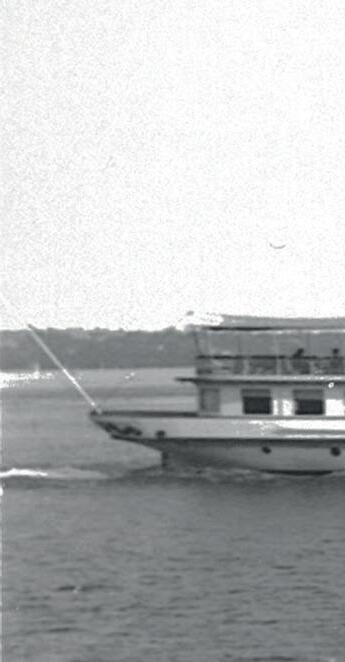
Du Guillaume Tell , qui fut le premier vapeur à sillonner le Léman dès 1823, au NAVIEXPRESS, dont la motorisation hybride préfigure l’avenir de la navigation lacustre, plongez avec nous dans deux siècles d’histoire.
From the Guillaume Tell, which was the first steamboat to sail on Lake Geneva as early as 1823, to the NAVIEXPRESS, whose hybrid motorisation prefigures the future of navigation, discover with us two centuries of history.
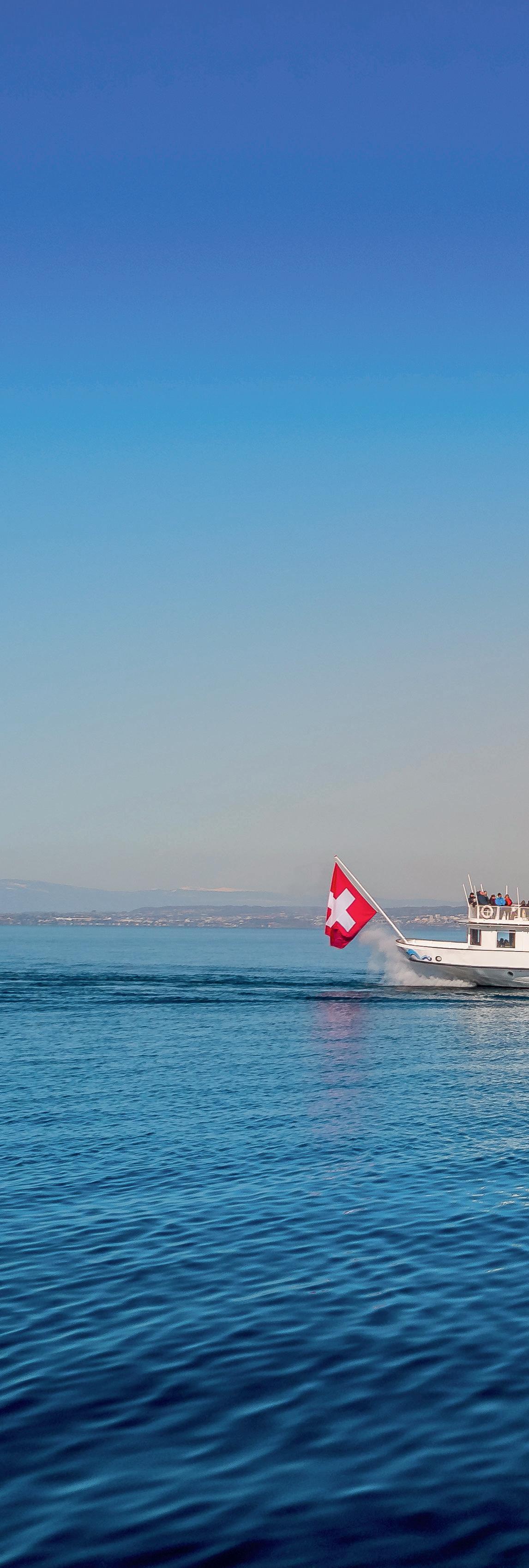
22 À TOUTE VAPEUR / / / FULL STEAM AHEAD / / / MIT VOLLDAMPF VORAUS
Textes de Camille Saladin et Clément Grandjean
© Jacques Stresslé / ABVL
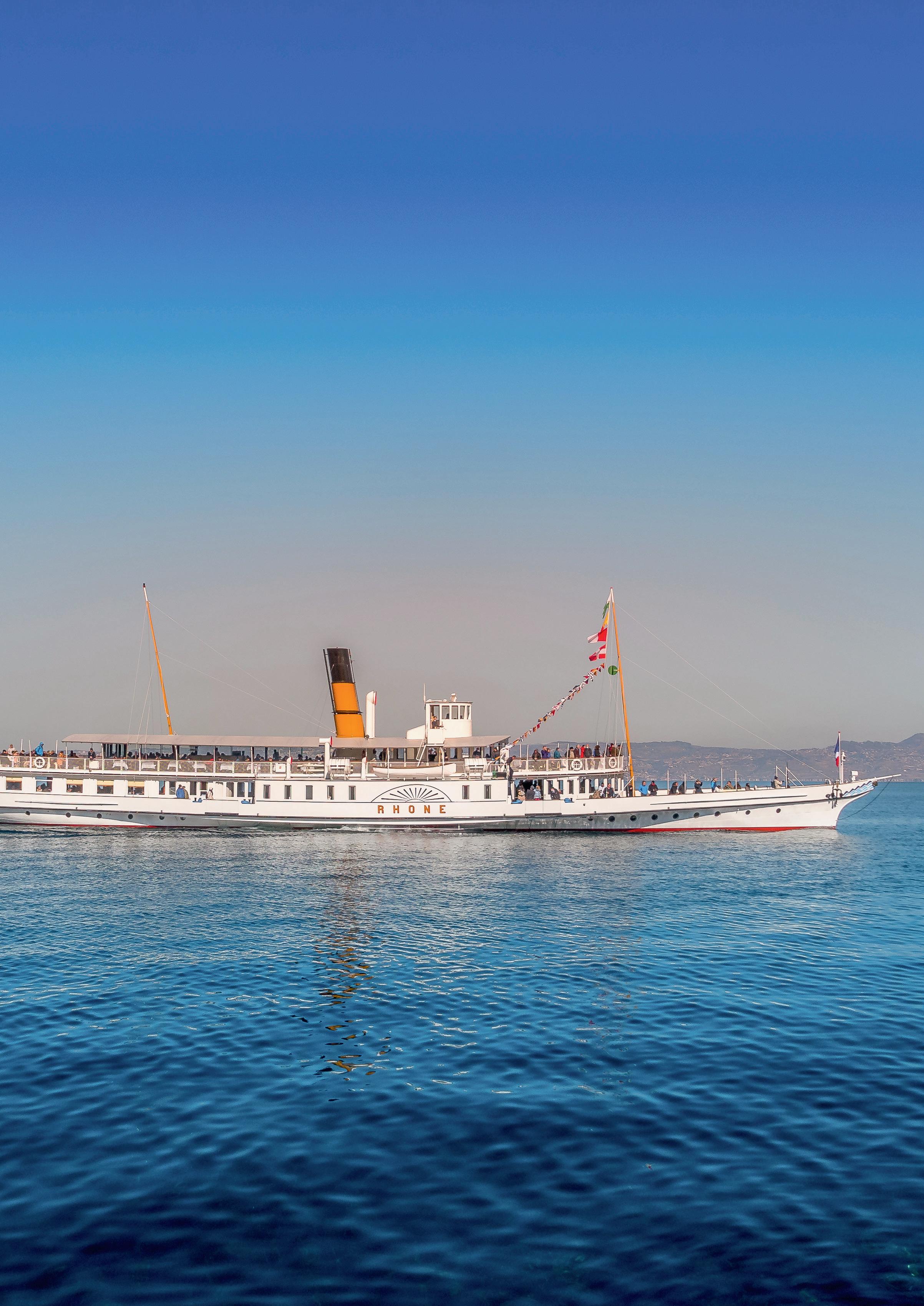
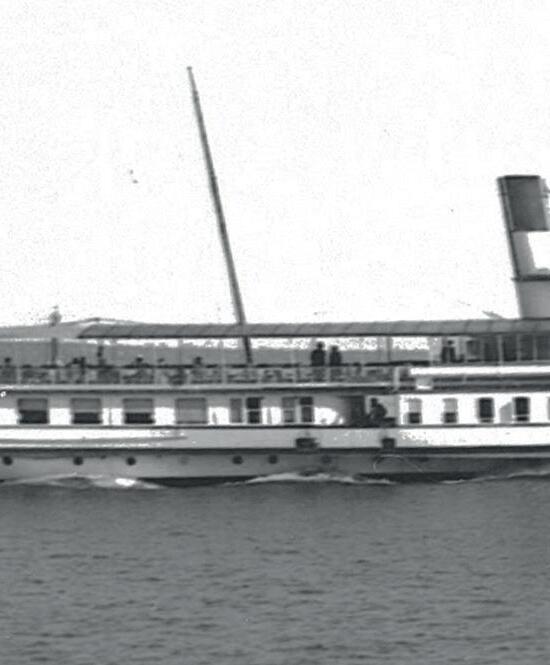
ans de navigation sur le Léman
1896-1914
Le tourisme se développe rapidement: c’est ce qu’on appelle la “Belle Époque” Tourism develops rapidly: this is the so-called "Belle Époque"
1873
Création de la Compagnie Générale de Navigation (CGN) Creation of the Compagnie Générale de Navigation (CGN)
1920-1929
Mise en service de trois grands vapeurs (Simplon, Helvétie et Rhône)
Launching of three large steamers (Simplon, Helvétie and Rhône)
1933
La machine à vapeur du Genève est remplacée par un moteur diesel-électrique: une première mondiale The steam engine of the Genève is replaced by a diesel-electric engine: a world first
1823
Le premier bateau à vapeur navigue sur le lac Léman
The first steamship sail on Lake Geneva
1914
La Première Guerre mondiale entraîne une réduction des activités The First World War results in a reduction of the activity
1874-1885
Apparition des premiers bateauxsalons à deux ponts
Launching of the first double-decker lounge boats
1929
Crise et péjoration de la situation financière Crisis and deteriorating financial situation
24 À TOUTE VAPEUR / / / FULL STEAM AHEAD / / / MIT VOLLDAMPF VORAUS
200
years of navigation on Lake Geneva
2005
1946-1962
La propulsion diesel-électrique est introduite sur plusieurs unités Belle Époque de moyenne dimensione Diesel-electric propulsion spreads
1939-1945
Seconde Guerre
mondiale: malgré des aides fédérales, la CGN envisage
l’arrêt de son activité
Second World War: despite federal aid, CGN plans to close down
Trois vedettes et deux navettes rapides entrent progressivement en service pour diminuer les coûts d’exploitation de la flotte
Three speedboats and two shuttles are being phased in to reduce the fleet's operating costs
1965-1989
Modernisation progressive de la flotte Belle Époque
Progressive modernisation of the Belle Époque fleet
1964 Exposition nationale suisse et création d’un nouveau chantier naval Swiss National Exhibition and creation of a new shipyard
1990
Le trafic frontalier entre Evian et Ouchy augmente, la CGN s’équipe pour répondre à la demande Border traffic between Evian and Ouchy increases, CGN equips invests to meet demand
2023
Mise en service du NAVIEXPRESS et 150e
anniversaire
Launching of the NAVIEXPRESS and 150th anniversary
2011
La flotte Belle Époque est classée parmi les monuments historiques du Canton de Vaud
The Belle Époque fleet is listed as a historical monument in the Canton of Vaud
À TOUTE VAPEUR / / / FULL STEAM AHEAD / / / MIT VOLLDAMPF VORAUS 25
200
1823 – 1870
Les
1870 - 1880
1880 - 1930
1930 - 1950
1950 - 1965
1965 - 1990
1990 - 2002
L’année 1823 marque le début de l’ère de la navigation à vapeur sur le lac Léman. Vingt ans après la mise à l’eau des premiers bateaux dotés de cette nouvelle technologie, l’Europe en compte déjà plus de 300, dont une bonne moitié en Angleterre. Inauguré le 18 juin 1823, le Guillaume Tell, destiné à faire les allers-retours quotidiens entre Genève et Lausanne, peut accueillir 200 passagers. Alors que les déplacements se font encore à cheval ou en diligence sur des chemins accidentés, la voie lacustre offre aux usagers une expérience de transport confortable. Et le succès est fulgurant : dès 1824, les chantiers se succèdent, avec une capacité de transport allant croissant. Après le Winkelried, le Léman en 1826, puis l’Aigle, en 1836, la « Compagnie de l’Helvétie » ouvre en 1841 la voie aux grands bateaux à vapeur du lac, avec une capacité de 1000 places. Les années passant, la concurrence se fait de plus en plus rude, tant sur l’eau, avec la multiplicité des compagnies, qu’à terre, avec le développement du réseau ferroviaire, qui multiplie la rapidité et la commodité des transports autour du lac. Afin d’y faire face, trois compagnies se regroupent en 1857 sous l’appellation « Communauté Helvétie-Aigle-Léman ».✵
2002 - 2011
2011 - 2018
2018 - 2023
1823 marks the beginning of the steam era on Lake Geneva. Twenty years after the first ships equipped with this new technology were launched, more than 300 could be found around Europe, a good half of which were operating in England. Inaugurated on 18 June 1823, the Guillaume Tell – intended for return trips between Geneva and Lausanne, could welcome 200 passengers. While people still travelled on horseback or by coach on uneven tracks, the route via the lake offered passengers a comfortable transport experience. And it was an instant success: as early as 1824, more and more vessels were built with an ever-increasing capacity. After the Winkelried, the Léman in 1826 then the Aigle in 1836, the “Compagnie de l’Helvétie” paved the way for the big steamboats that could be seen on the lake, with a capacity of 1,000. As the years passed, competition became increasingly fierce both on the water, with the large number of companies, and on land, with the development of the rail network, which increased the speed and convenience of the means of transport around the lake. To cope with this, three companies merged in 1857 under the name “Communauté Helvétie-AigleLéman”. ✵
Culture
premiers bateaux à vapeur du Léman
1823 - 1870
The time of the first steamers on Lake Geneva
DEUTSCHER TEXT Seiten 78 - 88
Estampe signée I. Huguenin figurant le vapeur Guillaume Tell I, qui navigue entre 1823 et 1836, dans le port d’Ouchy. Sculptée dans une pièce de mélèze et mesurant 160 cm de haut, la figure de proue de l’Helvétie I a orné le navire de 1841 à 1918. Elle est la seule du genre à avoir survécu jusqu’à nos jours.
Print showing the steamer Guillaume Tell I, which sailed between 1823 and 1836, in the port of Ouchy.
Carved from a piece of larch wood and measuring 160 cm in height, the figurehead of the Helvétie I adorned the ship from 1841 to 1918. It is the only one of its kind to have survived to the present day.
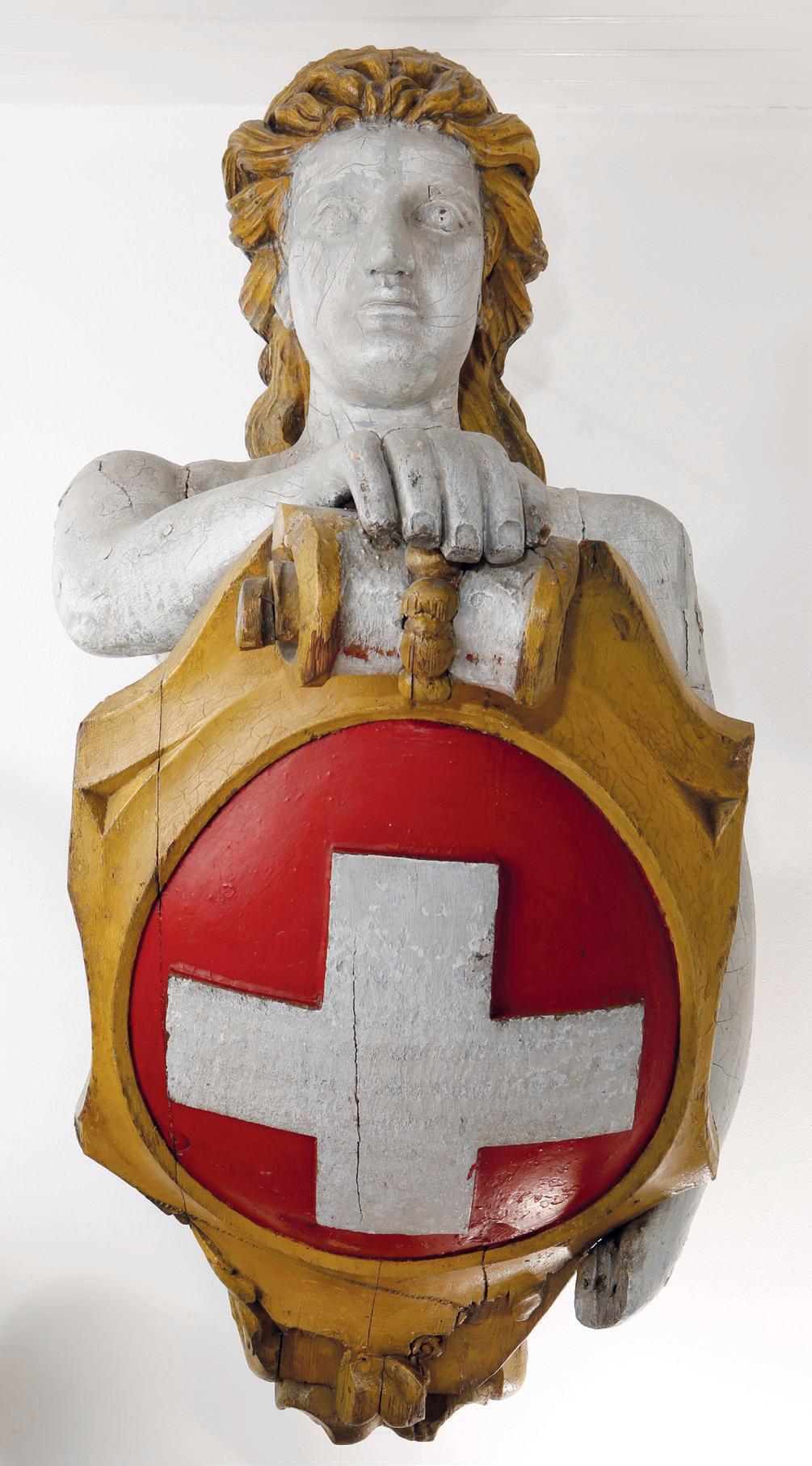
En 1869, Chéri François Dubreuil peint la fête organisée à Genève à l’occasion de l’inauguration du Monument national. Parmi les barques à voiles latines, les canots et les chaloupes, on reconnaît l’Helvétie I.
In 1869, Chéri François Dubreuil painted a celebration organised in Geneva for the inauguration of the National Monument. The Helvétie I can be seen among other small boats.

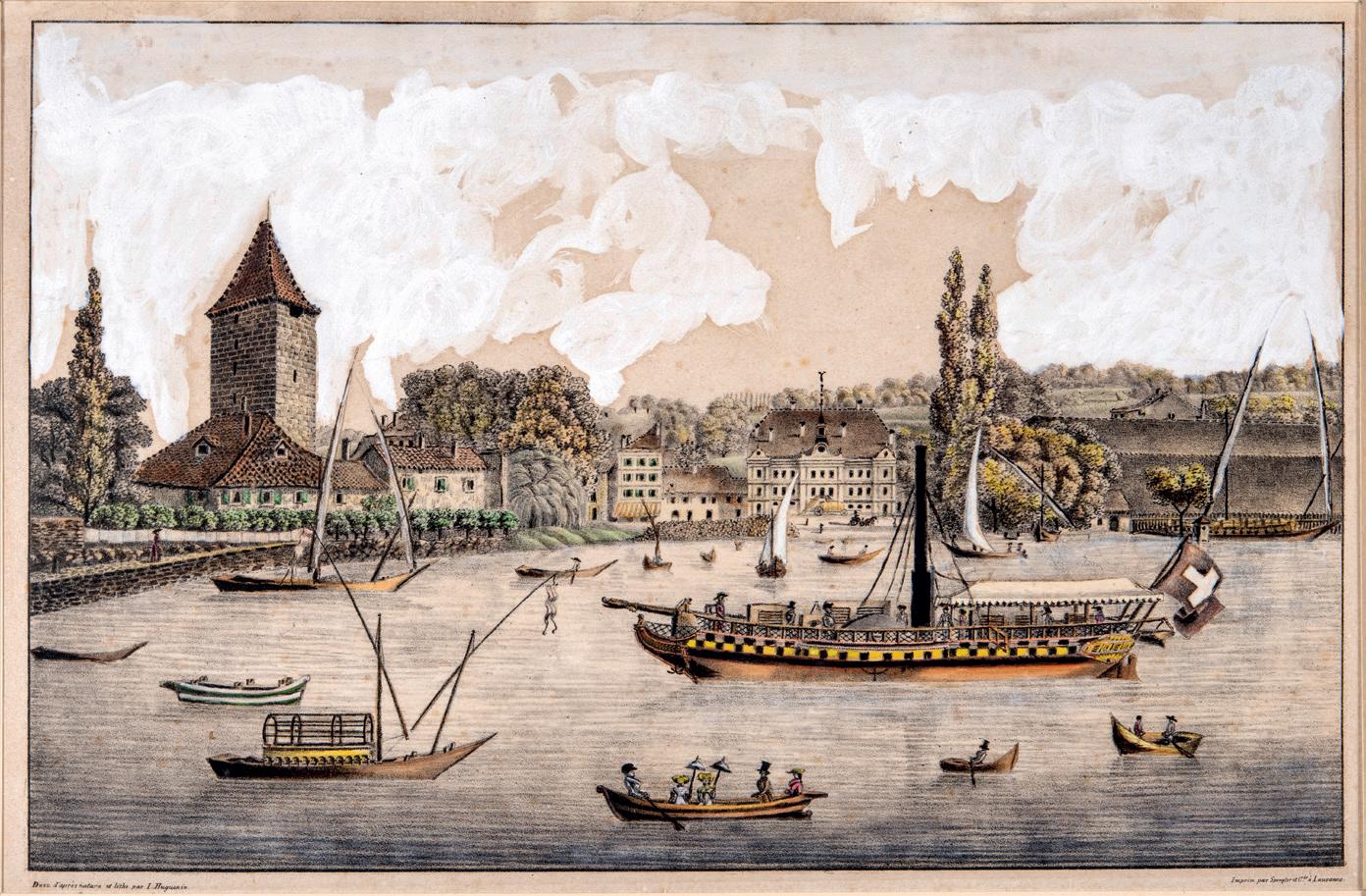
À TOUTE VAPEUR / / / FULL STEAM AHEAD / / / MIT VOLLDAMPF VORAUS 27
©
Collection du Musée du Léman / Nicolas Lieber (photo)
1823 – 1870
1870 - 1880
- 1880
1880 - 1930
1930 - 1950
1950 - 1965
1965 - 1990
1990 - 2002
Créée par la fusion des Compagnies de l’Aigle, de l’Helvétie et du Léman, la nouvelle « Compagnie Générale de Navigation sur le lac Léman », qui sera rapidement plus connue sous son acronyme CGN, voit officiellement le jour en 1873. Au moment de sa fondation, sa flotte est composée de huit unités : le Winkelried, avec ses deux grandes cheminées caractéristiques (1100 passagers), le Bonivard et l’Helvétie (900 passagers), le Léman (800 passagers), l’Aigle (700 passagers), le Chillon (450 passagers), le Guillaume Tell (400 passagers) et le Rhône (300 passagers). Par un habile pari stratégique, la CGN assied sa position dominante sur le Léman en achetant tous les bateaux à vapeur qui y circulent, et en démolissant ou transformant en pontons ceux qui sont à l’abandon. Elle supplante ainsi la vingtaine de petites compagnies qui s’y livraient une concurrence féroce, possédant souvent un unique navire et luttant difficilement contre la faillite. Elle conservera son monopole dans la navigation commerciale jusqu’à aujourd’hui, hormis pour les courtes distances et le fret.✵
2002 - 2011
2011 - 2018
2018 - 2023 Culture
Resulting from the merger of the Aigle, Helvétie and Léman companies, the new “Compagnie Générale de Navigation sur le lac Léman”, which soon became known by its acronym CGN, was officially founded in 1873. When it was founded the fleet comprised eight vessels: the Winkelried, with its two large characteristic smokestacks (1,100 passengers), the Bonivard and the Helvétie (900 passengers), the Léman (800 passengers), the Aigle (700 passengers), the Chillon (450 passengers), the Guillaume Tell (400 passengers) and the Rhône (300 passengers). Through a clever strategic gamble, the CGN cemented its dominant position on Lake Geneva by purchasing all the steamboats on the lake and demolishing or transforming those which had fallen into disuse into pontoons. It therefore ousted the twenty small companies in fierce competition with one another, often owning only a single vessel and facing an uphill struggle to avoid bankruptcy. It has retained its monopoly of commercial shipping to this day, with the exception of short freight runs. ✵
La création de la Compagnie Générale de Navigation sur le lac Léman (CGN)
The creation of the Compagnie Générale de Navigation sur le lac Léman (CGN)
1870
DEUTSCHER TEXT Seiten 78 - 88
Quelques-uns des premiers bateaux à vapeur de la CGN amarrés dans la rade de Genève : Mont-Blanc I, Léman III, Chillon, Helvétie I et Italie I apparaissent sur cette photographie panoramique datée entre 1865 et 1869.
Cygnes, barque à voiles latines, Dents du Midi et La Suisse lancée à l’assaut du lac : cette affiche dessinée par Mario Borgoni en 1910 mise sur les clichés et l’esthétique. Des pirates sur le Léman ? Rassurez-vous, ce canon, qui équipait le Winkelried I, puis le Winkelried II, n’avait pour fonction que de faire du bruit, lors de fêtes ou manifestations.
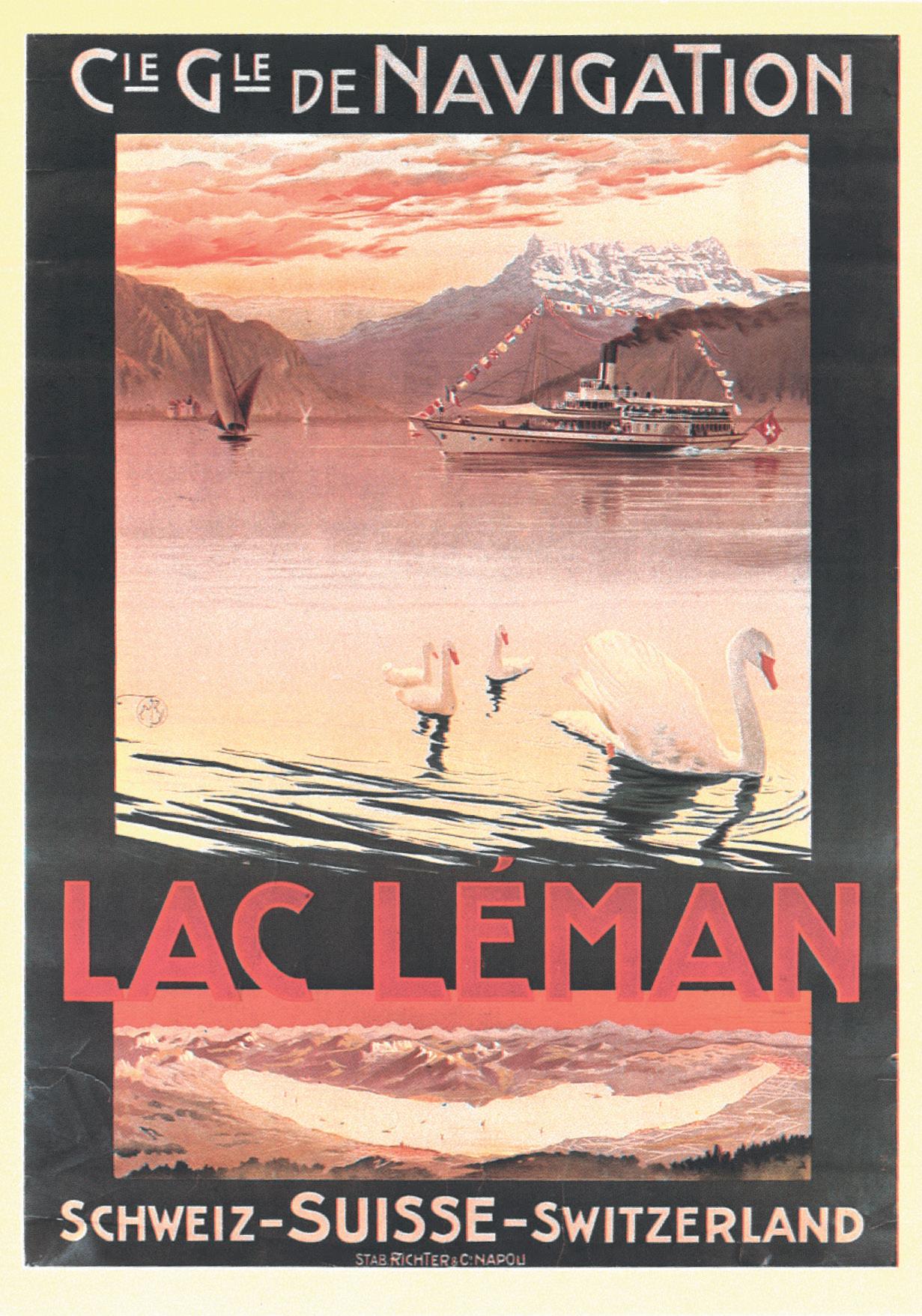
Some of the first CGN steamships in Geneva harbour : Mont-Blanc I, Léman III, Chillon, Helvétie I and Italie I can be seen in this photograph from between 1865 and 1869. Swans, a boat with lateen sails, the Dents du Midi and La Suisse steaming across the lake: this poster drawn in 1910 by Mario Borgoni focuses on clichés and aesthetics.
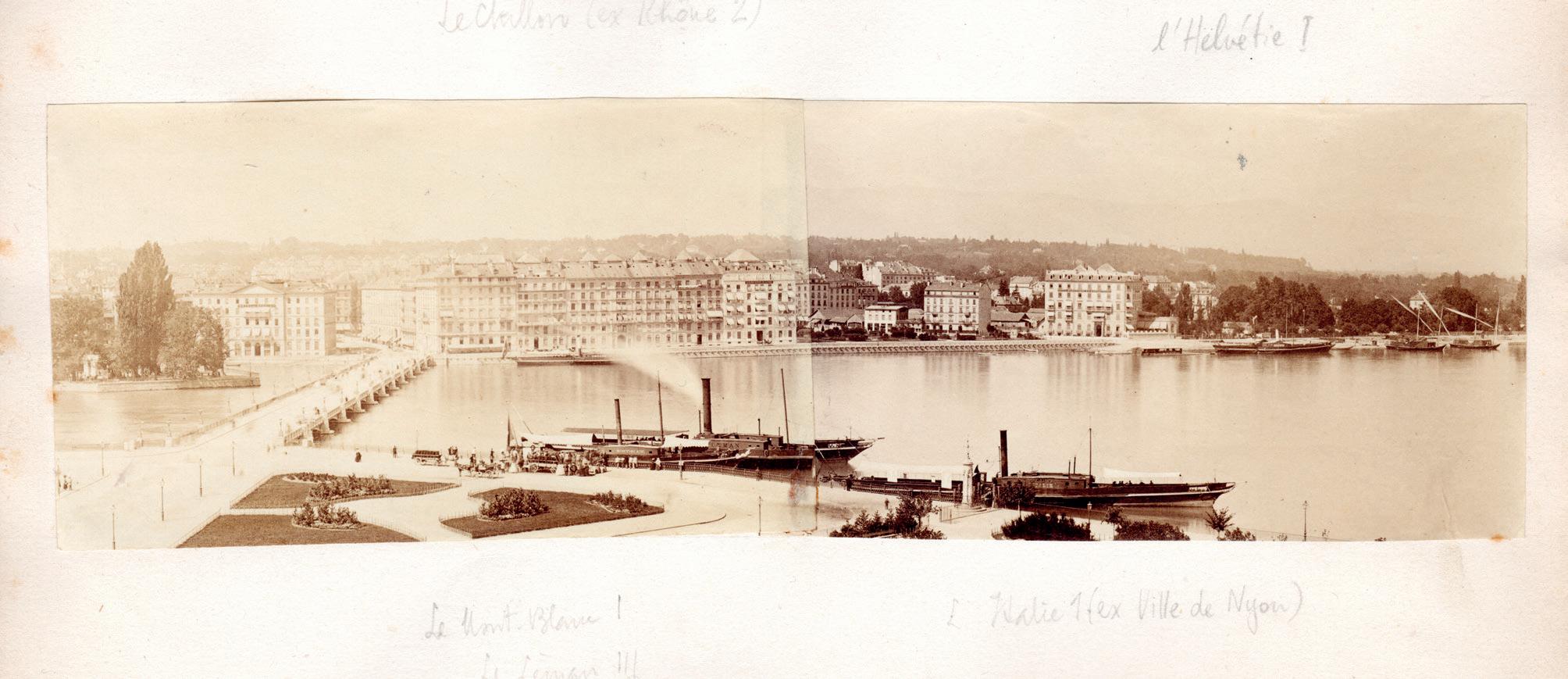
Pirates on Lake Geneva? Don’t worry, this cannon, which equipped the Winkelried I and then the Winkelried II, was only used to make noise during events.
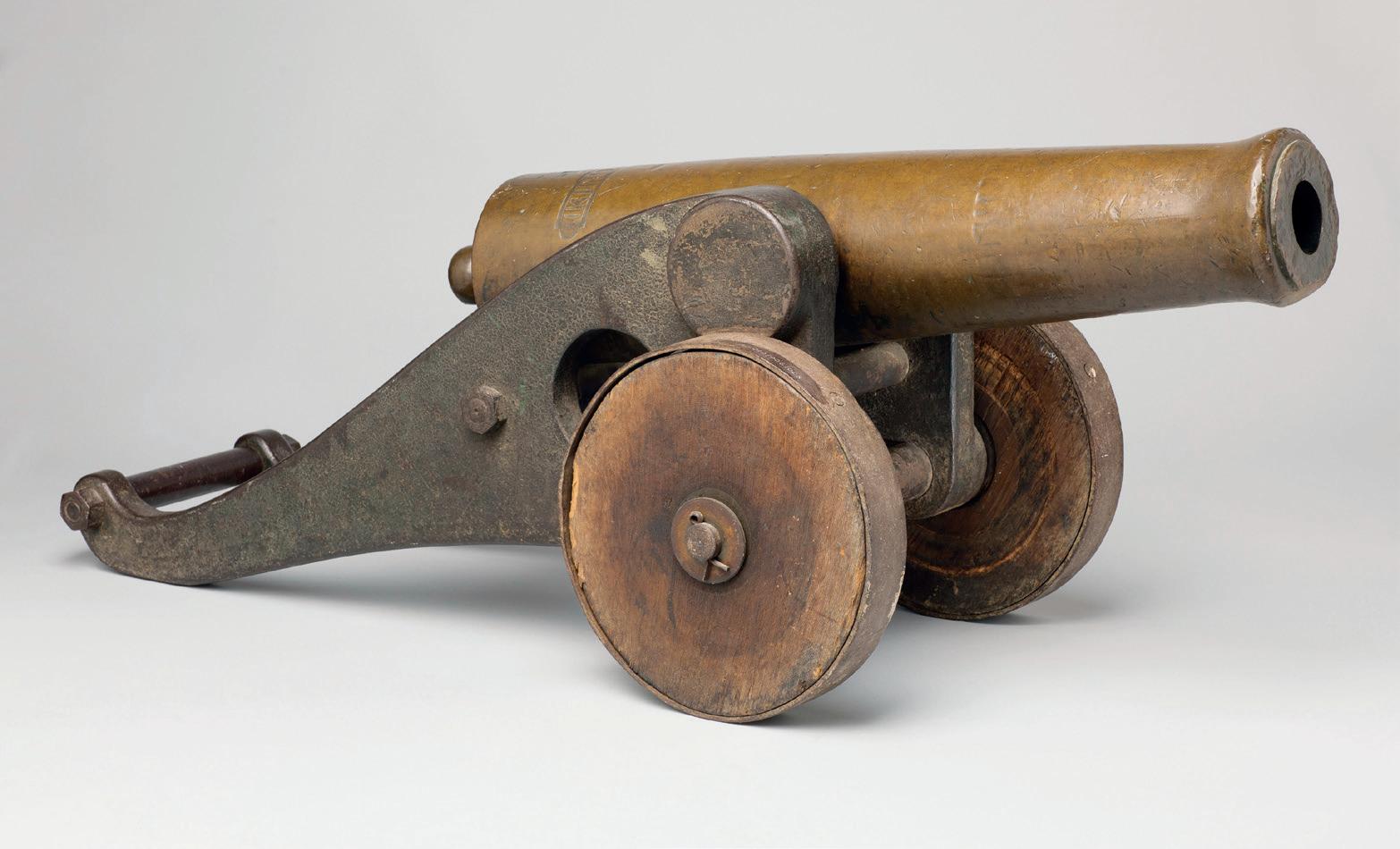 © Collection du Musée du Léman
/ Nicolas Lieber (photo)
© Collection du Musée du Léman
/ Nicolas Lieber (photo)
1823 – 1870
1870 - 1880
1880 - 1930
1880 - 1930
1930 - 1950
1950 - 1965
1965 - 1990
1990 - 2002
L’achèvement du réseau ferroviaire régional et le développement fulgurant du tourisme voient apparaître de nouveaux défis pour la CGN. Afin de rester concurrentielle, la Compagnie décide d’augmenter l’attractivité de son offre en misant sur une amélioration significative du confort, de l’espace, de la fiabilité et de la régularité de ses navires. Entre 1874 et 1885, elle finance avec ses propres deniers les premiers bateaux-salons à deux ponts, précurseurs des unités Belle Époque. De 1896 au début de la Première Guerre mondiale, dix grands bateaux-salons voient le jour, soit en moyenne un vapeur de luxe tous les deux ans. L’une des plus importantes flottes lacustres européennes de bateaux à vapeur à roues à aubes, et certainement la plus homogène, se trouve dorénavant sur le Léman. Quant aux affaires, elles sont florissantes. En 1913, les bateaux de la Compagnie parcourent 625 000 kilomètres et transportent plus de 2 millions de passagers, chiffre qui ne sera à nouveau atteint qu’en 2012, soit près d’un siècle plus tard ! Cette période faste va être brutalement interrompue par le déclenchement de la guerre, qui entame sérieusement les finances de la CGN. ✵
2002 - 2011
water
2011 - 2018
2018 - 2023 Culture
The completion of the regional rail network and the rapid development of tourism saw the arrival of new challenges for the CGN. In order to remain competitive, the company decided to increase the attractiveness of its offer by focussing on a significant increase in the comfort, space, reliability and regularity of its boats. Between 1874 and 1885, it used its own funds to introduce the first two-deck saloon boats, the forerunners of the Belle Époque vessels. From 1896 to the beginning of the First World War, ten saloon boats were built at a rate of one luxury steamer every two years. One of the largest fleets of paddles steamers operating on Europe’s lakes, and certainly the most homogeneous, could now be seen on Lake Geneva. Business was flourishing. In 1913, the company’s boats covered 625,000 kilometres and transported over 2 million passengers, a figure that would only subsequently be matched in 2012, almost a century later! This prosperous period would be brutally interrupted by the outbreak of war, which seriously affected the finances of the CGN. ✵
Les premiers bateaux-salons, le luxe sur l’eau
The first saloon boats, luxury on
DEUTSCHER
TEXT Seiten 78 - 88
Casquettes, moustaches, cravates et tabliers : l’élégance est de rigueur pour l’équipage de l’Aigle III, qui prend la pose sur le pont arrière en 1886. Au tournant du siècle, effectuer le tour du lac à bord d’un bateau de la CGN est le nec plus ultra. En témoigne ce ruban souvenir daté de mai 1901. Pour meubler les salons, la Compagnie embauche les meilleurs artisans de la région. Les Lausannois Ernest et Henry Bobaing ont créé nombre de détails de marqueterie et d’ébénisterie, comme cette chaise en cerisier fabriquée en 1915 pour le Valais

Caps, moustaches, ties and aprons: the crew of the Aigle III poses elegantly on the aft deck in 1886. At the turn of the century, sailing around the lake on a boat in the CGN fleet was the ultimate experience. A souvenir ribbon, dated May 1901, bears witness to this.

To furnish the salons, the Company hired the best craftsmen in the region such as Ernest and Henry Bobaing, who created a number of marquetry details and items of wooden furniture, such as this cherry wood chair built in 1915 for the Valais.
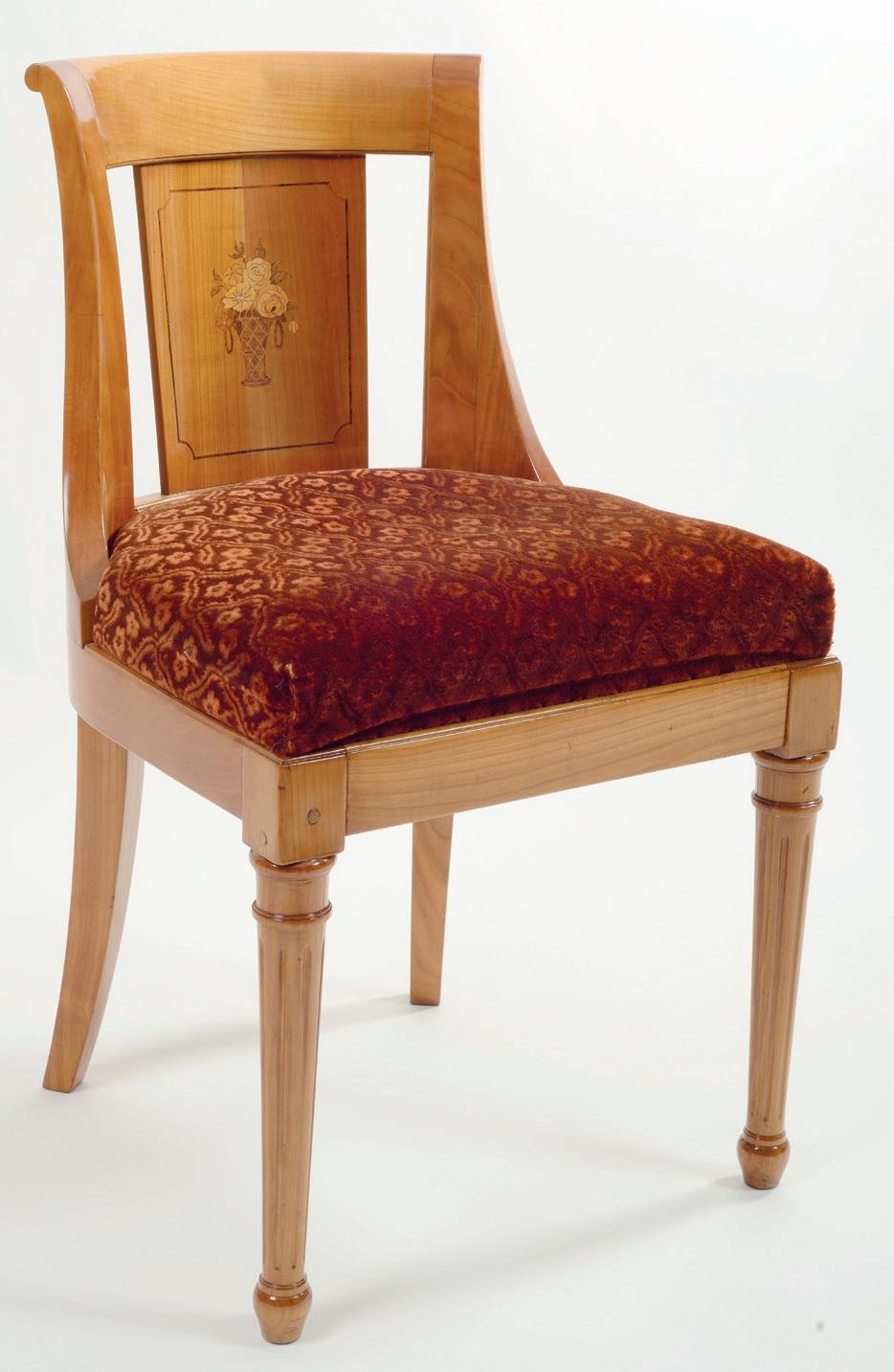
À TOUTE VAPEUR / / / FULL STEAM AHEAD / / / MIT VOLLDAMPF VORAUS 31
© Collection du Musée du Léman
1823 – 1870
Guerres mondiales et krach
1870 - 1880
: c’est la crise !
1880 - 1930
1930 - 1950
- 1950
1950 - 1965
1965 - 1990
1990 - 2002
Après un bref élan de renouveau durant les années 20 qui fait naître l’espoir d’une nouvelle Belle Époque, le tableau s’assombrit progressivement pour la navigation lacustre. Les effets de la crise économique, qui débute en 1929 avec le krach de Wall Street, se font sentir en Suisse dès l’année suivante et perdurent pratiquement jusqu’à la fin de la Seconde Guerre mondiale. À cela s’ajoute une nouvelle concurrence : la circulation automobile. Pour la première fois dans sa longue existence, la CGN se voit dans l’obligation d’appliquer un plan d’économies, car sa flotte se révèle désormais inadaptée au nombre de clients qu’elle peut espérer transporter. Le trafic de marchandises, déficitaire, est supprimé en 1931. Une diminution des coûts de propulsion, de combustible et de main-d’œuvre s’impose : deux bateaux perdent leur propulsion vapeur et se transforment en diesel-électrique à roues à aubes, une première mondiale. Avec l’éclatement de la Seconde Guerre mondiale, la situation empire de façon dramatique. La Compagnie, affaiblie, est touchée de plein fouet. Au printemps 1940, le fleuron boursier d’avant la Grande Guerre est en faillite et doit faire appel à l’aide des pouvoirs publics. ✵
2002 - 2011
World wars and Wall Street crash : crisis!
2011 - 2018
2018 - 2023 Culture
After a brief recovery during the 1920s, bringing hope of a new Belle Époque, the outlook gradually grew darker for shipping on the lake. The effects of the economic crisis, which was triggered by the Wall Street crash in 1929, were felt in Switzerland the following year and lasted almost until the end of the Second World War. This was compounded by a new rival: the car. For the first time in its long existence, the CGN was forced to implement a cost-saving plan as its fleet was no longer suited to the number of customers it could hope to transport. Freight shipping, already in deficit, was abandoned in 1931. A reduction in propulsion, fuel and labour costs was necessary: two boats lost their steam engines and were transformed into diesel-electric paddle boats, a world’s first. With the outbreak of the Second World War, the situation worsened dramatically. The already weakened company was seriously affected. In spring 1940, this jewel of the stock market before the Great War was bankrupt and was forced to call on the aid of the public authorities. ✵
boursier
1930
DEUTSCHER TEXT Seiten 78 - 88
En période de guerre, les navires peuvent aussi servir au transport de matériel ou de troupes, comme cela avait été le cas durant la Première Guerre mondiale (ici, le 13 novembre 1918, photographie de Frank Henri Jullien).
In times of war, ships can also be used to transport equipment or troops, as was the case during the First World War (here, 13 November, 1918, photography by Frank Henri Jullien).
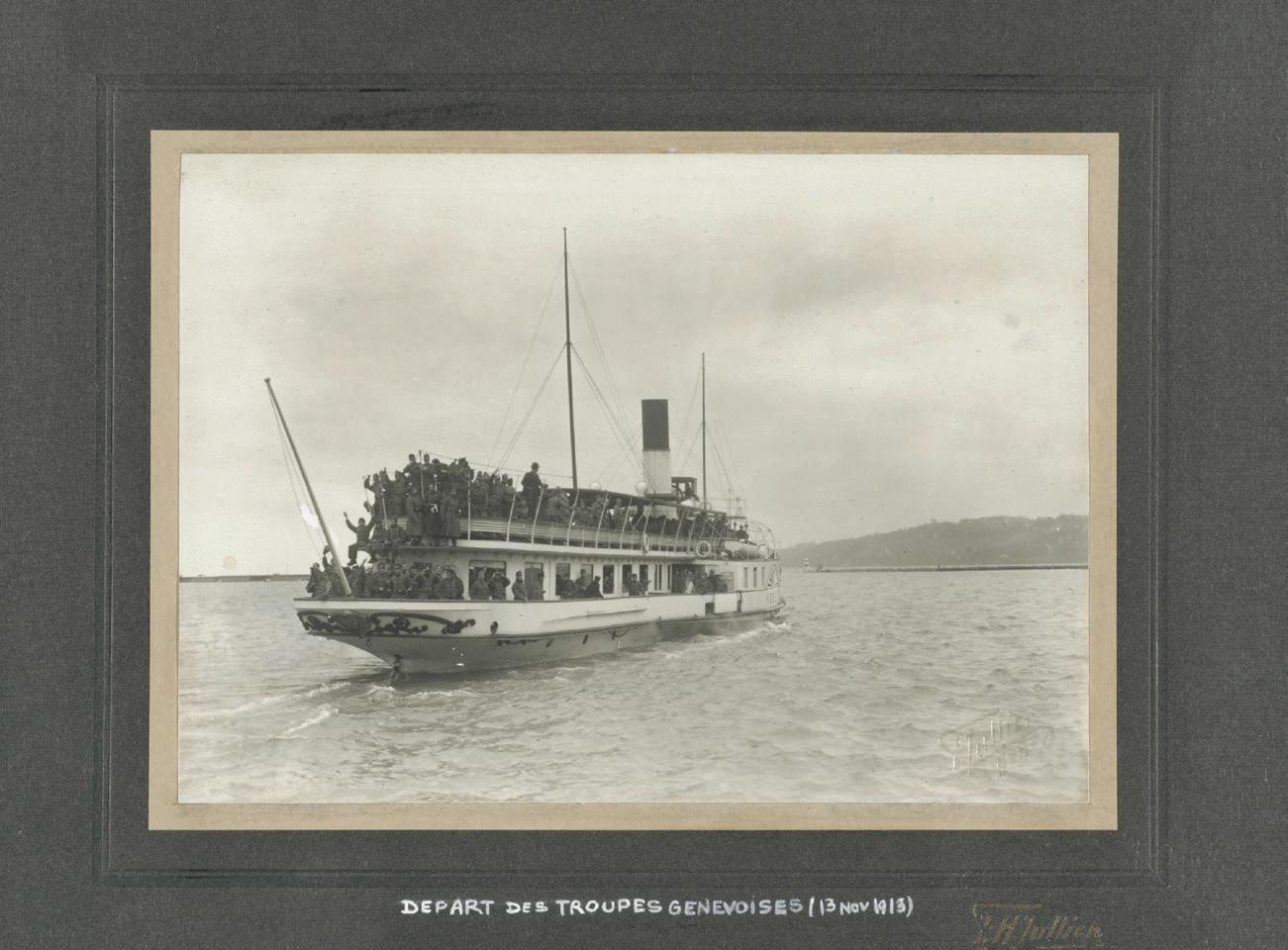
Dans l’entre-deux-guerres, la CGN rivalise de charme pour lutter contre la concurrence de la route. Les dépliants, richement illustrés, vantent la riche offre de la Compagnie et les atouts touristiques du Léman. Cet exemplaire, édité à la fin des années 1920, représente La Suisse devant les Dents du Midi.
Parmi les objets emblématiques de la navigation, le transmetteur d’ordres tient un rôle de premier plan. Celui-ci était sans doute utilisé à bord de l’Helvétie II
During the inter-war period, the CGN offered a more charming alternative to road traffic. The richly illustrated leaflets highlighted the company’s rich offer and the attractions of Lake Geneva. This example, from the late 1920s shows La Suisse in front of the Dents du Midi.
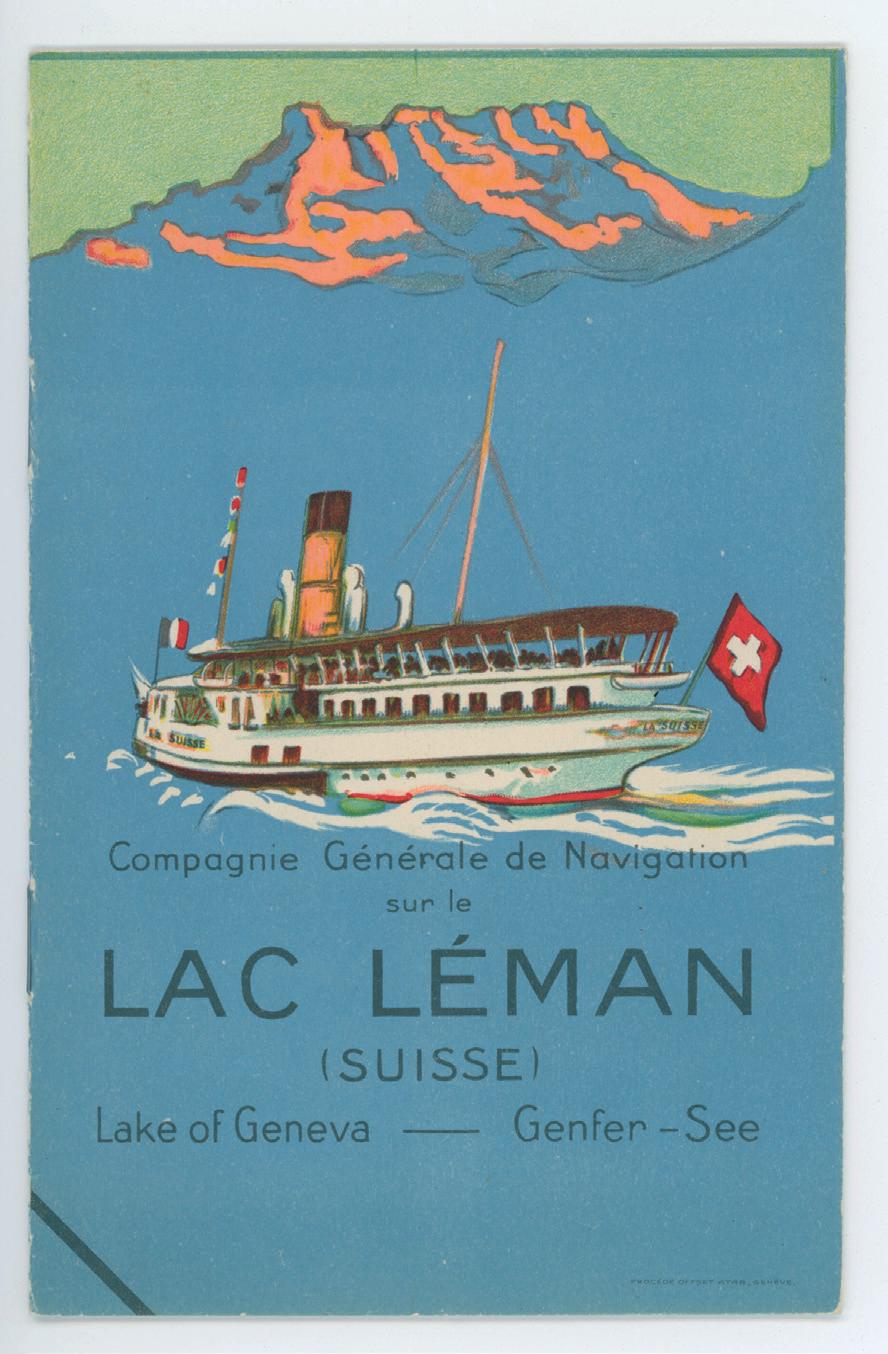
The order transmitter is an emblematic object. This one was probably used on board the Helvétie II.
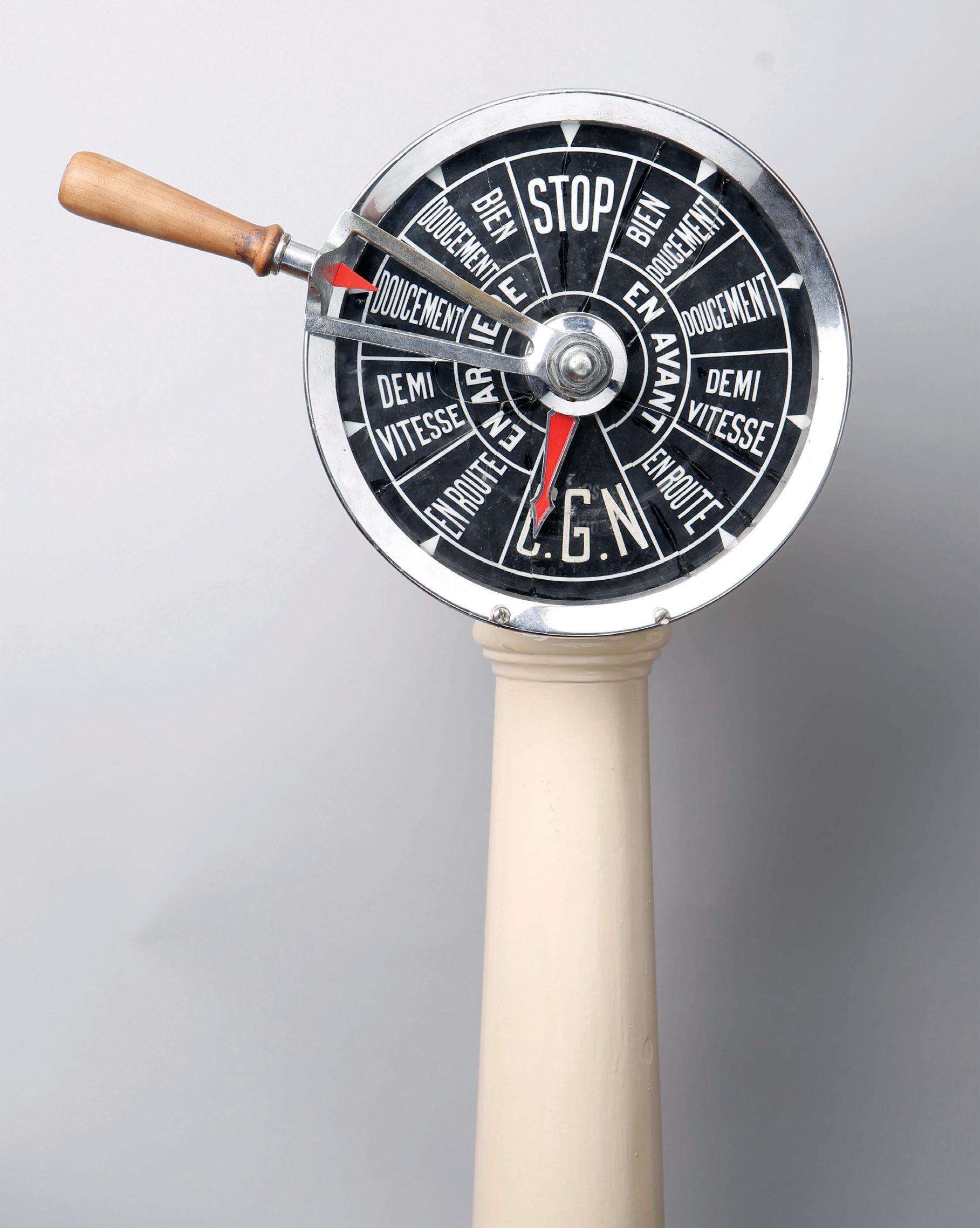 © Collection du Musée du Léman/Nicolas Lieber (photo)
© Collection du Musée du Léman/Nicolas Lieber (photo)
1870 - 1880
1880 - 1930
1950 - 1965
1965 - 1990 1990 - 2002
Dans les années 1950, l’ensemble des navires Belle Époque sont remis en service. Soutenue par les pouvoirs publics, la CGN acquiert en 1963 et 1964 deux bateaux à moteur et à hélices jumeaux : le Henry-Dunant et le Général-Guisan. Fait aussi son apparition un étonnant hydroglisseur, l’Albatros, transportant 80 passagers à la vitesse « vertigineuse » de plus de 60 km/h. Dans le cadre des aménagements prévus pour l’Exposition nationale qui aura lieu la même année, la Compagnie construit un nouveau chantier naval à Ouchy-Bellerive. Pour la première fois depuis 1913, elle affiche à nouveau un bénéfice et est en mesure de verser un dividende à ses actionnaires. Ainsi, au moment où l’économie entre dans une période de haute conjoncture, la CGN a réussi à moderniser en partie ses navires, avec désormais sept bateaux à vapeur (La Suisse, Simplon, Helvétie, Général Dufour, Savoie, Rhône et Major Davel), cinq bateaux à motorisation diesel-électrique (Vevey, Italie, Montreux, Genève, Lausanne), six bateaux à moteur à hélices (les deux nouveaux Henry-Dunant et Général-Guisan, le vétéran Léman, les trois vedettes Col-Vert, Grèbe et Bécassine) et l’hydroglisseur Albatros. Une flotte plus que respectable. ✵
The national exhibition: Switzerland on display
In the 1950s, all the Belle Époque boats returned to service. Support by the public authorities, the CGN acquired two twin-propeller boats in 1963 and 1964 : the Henry-Dunant and the Général-Guisan. A surprising hovercraft, the Albatros carrying 80 passengers at the “dizzying” speed of over 60 km/h also came on the scene. As part of the redevelopments scheduled for the national exhibition to be held the same year, the company built a new shipyard in Ouchy-Bellerive. For the first time since 1913, it recorded a profit and was in a position to pay its shareholders a dividend. Thus, with the economy entering a period of high growth, the CGN succeeded in modernising a part of its fleet, which now included seven steamers (La Suisse, Simplon, Helvétie, Général Dufour, Savoie, Rhône and Major Davel), five diesel-electric paddle boats (Vevey, Italie, Montreux, Genève, Lausanne), six propeller-driven boats (the two new boats Henry-Dunant and Général-Guisan, thee veteran Léman, the three small excursion boats Col-Vert, Grèbe and Bécassine) and the hovercraft Albatros. A more than respectable fleet. ✵
1823 – 1870
1930 - 1950 1950 - 1965
2002 - 2011 2011 - 2018 2018 - 2023 Culture
La Suisse se met en scène pour l’Exposition nationale
DEUTSCHER TEXT Seiten 78 - 88
En 1964, l’Exposition nationale suisse, qui se déroule à Lausanne, sur les bords du Léman, met le lac sous les projecteurs. Elle est l’occasion de construire un nouveau chantier naval pour la CGN. La Compagnie présente également, lors de l’événement, l’étonnant Albatros, un hydroptère qui s’élève au-dessus de la surface lorsqu’il prend de la vitesse. L’engin ne sera toutefois en service que quelques années. Photographie Éditions Jaeger Genève, vers 1964.
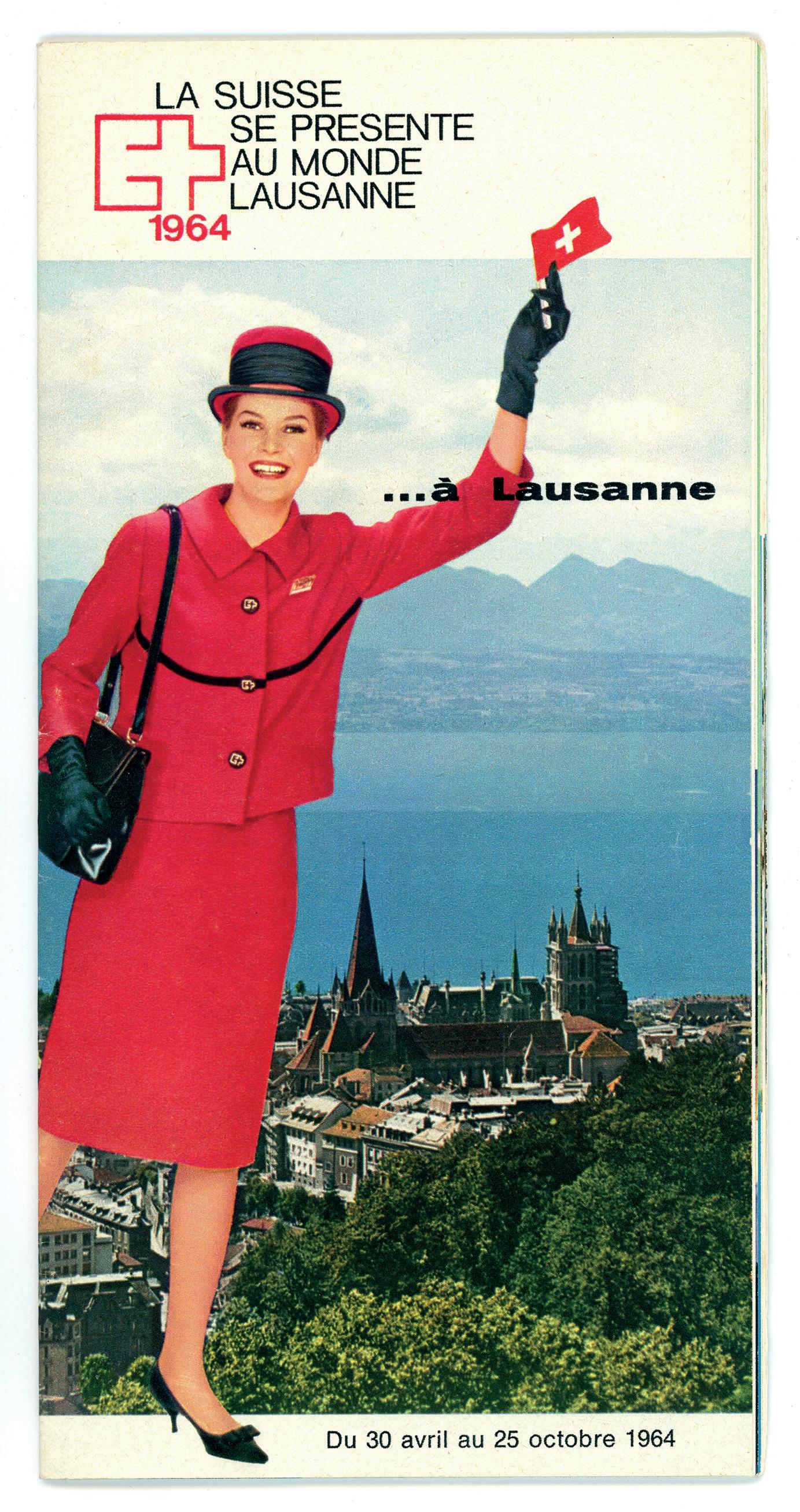
In 1964, the National Exhibition in Lausanne put Lake Geneva centre stage. It was the perfect opportunity to build a new shipyard for the CGN.
During the event, the company also presented the Albatros, a hydrofoil that rose out of the water when it gained speed. However, it would only be in service for a few years. Photography Éditions Jaeger Genève, around 1964.

À TOUTE VAPEUR / / / FULL STEAM AHEAD / / / MIT VOLLDAMPF VORAUS 35
© Collection du
du
/ Bibliothèque
Musée
Léman
de Genève
1823 – 1870
1870 - 1880
1880 - 1930
1930 - 1950
1950 - 1965
1965 - 1990
1965 - 1990
1990 - 2002
Les années 1960 sonnent le glas du chauffage au charbon; certains navires, comme le Général Dufour et le Major Davel, encore en état de marche, sont désarmés au profit de nouvelles unités plus innovantes. Le manque de moyens financiers et le bas coût du mazout lourd conduisent cependant la CGN à renoncer à motoriser ses plus grandes unités à roues à aubes. À la fin des années 1970, la Compagnie se procure deux nouveaux bateaux à moteur à hélices: le Chablais III en 1974 et le Villede-Genève en 1978. La période est au beau fixe: les années 1980 sont marquées par des conditions météorologiques clémentes et une économie prospère. Le trafic frontalier entre Ouchy et Évian augmente de manière régulière et nécessite l’engagement de deux bateaux aux heures de pointe. La Compagnie parvient ainsi, une nouvelle fois dans son histoire, à équilibrer ses comptes. Afin de transporter un nombre de passagers toujours croissant, elle acquiert un bateau-navette spacieux, le Léman V, qui offre un maximum de places assises à l’intérieur, à l’abri des intempéries, puis un véritable géant, le Lausanne II, d’une capacité d’accueil de 1500 places. ✵
2002 - 2011
2011 - 2018
2018 - 2023 Culture
The 1960s saw the end of coal power; some boats, like the Général Dufour and the Major Davel which were will in working condition, were decommissioned in favour of new, more innovative vessels. The lack of financial resources and the low cost of heavy fuel oil nevertheless led the CGN to abandon its idea of motorising its largest paddle steamers. At the end of the 1970s, the company acquired two new propeller-driven boats: the Chablais III in 1974 and the Ville-de-Genève in 1978. The situation was looking good and the 1980s were marked by favourable weather conditions and a booming economy. The border traffic between Ouchy and Évian was steadily increasing and required the implementation of two boats at rush hour. Once again, the company succeeded in balancing its books. In order to transport an ever-increasing number of passengers, it acquired a spacious shuttle boat, the Léman V, which offered a maximum number of seats inside, sheltered from bad weather, followed by a true giant, the Lausanne II, with a capacity of 1,500 seats. ✵
Le temps des premiers voyageurs pendulaires
It’s time for the first commuters on the lake
DEUTSCHER TEXT Seiten 78 - 88
Quel enfant de Suisse romande n’a pas emprunté un bateau Belle Époque lors d’une course d’école ? Un incontournable depuis des décennies, comme en témoigne cette affiche de l’illustrateur morgien Pierre Bataillard.
Les publicités pour la CGN regorgent de trésors visuels, comme cette autre affiche, signée André Paul. Imprimerie Säuberlin & Pfeiffer, 1959.
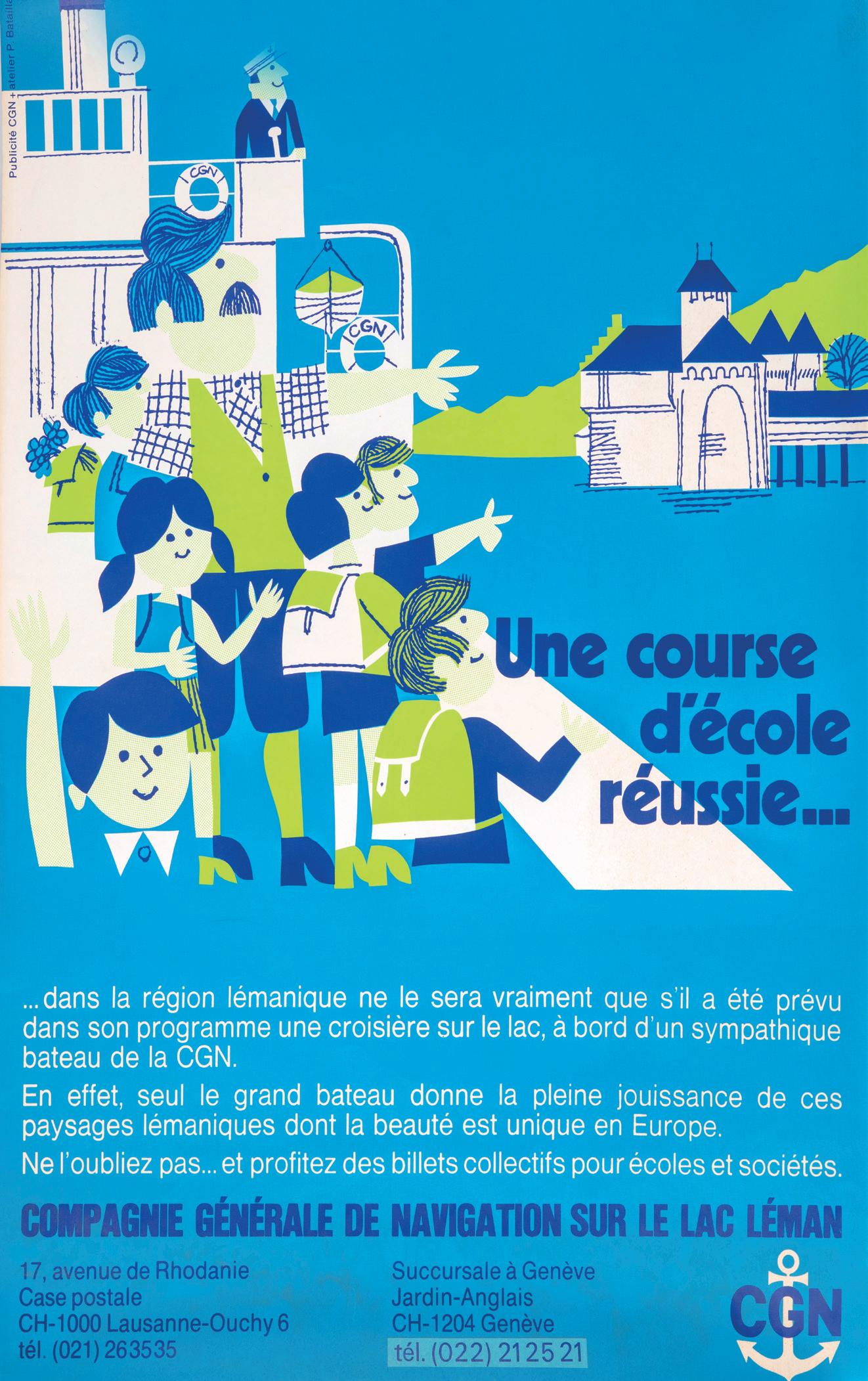
Which child in western Switzerland has not climbed aboard a Belle Époque boat during a school trip? It has been a must for decades, as this poster by local illustrator Pierre Bataillard shows. CGN advertisements are full of visual treasures, like this other poster by André Paul. Imprimerie Säuberlin & Pfeiffer, 1959.

À TOUTE VAPEUR / / / FULL STEAM AHEAD / / / MIT VOLLDAMPF VORAUS 37
©
Collection du Musée du Léman
1823 – 1870
1870 - 1880
1880 - 1930
1930 - 1950
1950 - 1965
1965 - 1990
1990 - 2002
1990 - 2002
Malgré de fréquentes rénovations et transformations, ainsi qu’une navigation presque ininterrompue depuis leur mise à l’eau, les huit bateaux de la flotte Belle Époque, bientôt centenaires, montrent de sérieux signes d’usure. Par chance, le public prend peu à peu conscience de leur valeur inestimable. Des démarches politiques sont lancées pour demander leur classement comme monuments historiques. La CGN, qui reconnaît l’attrait unique de la propulsion vapeur, annonce la « revaporisation » de ses quatre bateaux à roues à aubes à propulsion diesel-électrique. Elle prévoit des transformations qui permettront d’éviter la nécessité d’une permanence d’un mécanicien dans la salle des machines, et l’augmentation du rendement des machines grâce à un cycle thermodynamique à haute pression et haute température ; c’est une première mondiale. Malheureusement, elle ne sera en mesure de réaliser cette audacieuse rénovation que pour le Montreux, faute de moyens. Quelques passionnés de la flotte historique se réunissent alors en vue de créer l’Association des amis des bateaux à vapeur du Léman (ABVL) en 2002. Les dons de ses membres apportent un soutien précieux à une compagnie qui traverse des difficultés financières et assurent la sauvegarde des navires Belle Époque restants. ✵
2002 - 2011
Wonderful and precious historic boats
2011 - 2018
2018 - 2023 Culture
Despite frequent renovations and transformations as well as almost uninterrupted service since they were first launched, the eight boats of the Belle Époque fleet would soon be a hundred years old and were showing serious signs of wear. Fortunately, the public gradually became aware of their inestimable value. Political procedures were launched to request that they be classified as historical monuments. The CGN, which recognised the unique attraction of steam power, announced a “return to steam” for its four diesel-electric boats. It planned a series of transformations making it possible to avoid the standing presence of a mechanic in the engine room, as well as the increased output of the engines thanks to a high-pressure and high-temperature thermodynamic cycle : a world’s first. Unfortunately, it was only able to undertake this bold renovation for the Montreux, for want of resources. A group of enthusiasts of the historic fleet got together to create the Association des amis des bateaux à vapeur du Léman (ABVL) in 2002. The donations of its members provided precious support for the company, which was facing financial difficulties, and ensured that the remaining vessels would be saved. ✵
Des bateaux plus précieux que l’or
DEUTSCHER TEXT Seiten 78 - 88
Les navires centenaires de la flotte Belle Époque ont un charme inégalable, mais ils nécessitent un entretien important. De la révision des machines aux travaux de peinture de la coque en passant par la rénovation des exquis détails des boiseries intérieures (ici, le détail d’une pièce de marqueterie du salon du Rhône), le travail est permanent.

The century-old ships of the Belle Époque fleet have an incomparable charm, but they require a great deal of maintenance. From overhauling the machinery to painting the hull or renovating the exquisite details of the interior woodwork (here, the detail of a piece of marquetry in the salon of the Rhône), there is always something to do.
 © Jacques Straesslé / Clément Grandjean
© Jacques Straesslé / Clément Grandjean
1823 – 1870
Recherches de fonds et grands chantiers
1870 - 1880
1880 - 1930
1930 - 1950
1950 - 1965
1965 - 1990
Les chantiers se poursuivent et la recherche de fonds est incessante. En 2003, l’ABVL lance sa première campagne « Ensemble, redonnons à La Suisse sa silhouette d’origine », qui sera suivie de l’action « Sauvons le Simplon », nécessaire pour remettre le navire en état suite à l’explosion de gaz de mazout dans les tubes de fumée d’une de ses chaudières. Avec un résultat dépassant toutes les espérances, le bateau est sauvé dans un élan collectif. Grâce à d’innombrables dons de privés, l’association met 12 millions de francs à disposition de la Compagnie pour la rénovation de La Suisse, dont le coût total de remise à neuf s’élèvera à 15 millions de francs. La CGN annonce ses ambitions pour 2010 : en parallèle du développement de ses prestations de transport public et de l’ajout de haute technologie, elle s’engage à œuvrer à la conservation de son patrimoine Belle Époque, grâce à un extraordinaire savoir-faire artisanal. Les besoins de financement ne faiblissent pas. Le succès des campagnes menées par l’ABVL non plus : après quelques années d’immobilisation, l’Italie et le Vevey sont entièrement rénovés. ✵
1990 - 2002
Fundraising and major work sites
2002 - 2011
2002
2011 - 2018
2018 - 2023 Culture
The work sites continued, with a constant need for new resources. In 2003, the ABVL launched its first campaign, “Ensemble, redonnons à La Suisse sa silhouette d’origine”, followed by the action “Sauvons le Simplon”, which was necessary to renovate the boat after an explosion of fuel oil gas in the smoke tubes of one of its boilers. With a result exceeding all expectations, the boat was saved thanks to a collective effort. Thanks to countless private donations, the association provided the company with 12 million francs for the renovation of La Suisse, at a total cost of 15 million francs. The CGN announced its ambitions for 2010 : in parallel to the development of public transport services and the addition of high-tech elements, it undertook to ensure the conservation of its Belle Époque heritage thanks to extraordinary specialist know-how. The funding needs continued to rise. As did the success of the campaigns led by the ABVL : after a few years of being immobilised, the Italie and the Vevey were entirely renovated ✵
- 2011 DEUTSCHER TEXT Seiten 78 - 88
Le vapeur La Suisse est rénové grâce à la première grande campagne de financement menée par l’ABVL. Le chantier coûtera 15 millions de francs au total et permet au bateau de reprendre le large pour le plus grand plaisir des voyageurs (en dessous, sa remise en service, en mai 2009).

Sur les bateaux Belle Époque, chaque détail compte, à l’instar de la cloche du Montreux, le vétéran de la flotte. Elle a été remise à bord en 2017 grâce à un prêt à long terme du Musée du Léman.
The steamer La Suisse was renovated thanks to the first major fundraising campaign conducted by the ABVL. The work would cost a total of 15 million francs, allowing the boat to set sail again much to the pleasure of passengers (below, its return to the lake in May 2009).

On Belle Époque boats, every detail counts, like the bell of the Montreux, the veteran of the fleet. It was brought back on board in 2017 thanks to a loan from the Musée du Léman.

À TOUTE VAPEUR / / / FULL STEAM AHEAD / / / MIT VOLLDAMPF VORAUS 41
© CGN
1823 – 1870
1870 - 1880
Restructuration et classement de la flotte Belle Époque
1880 - 1930
1930 - 1950
1950 - 1965
1965 - 1990
1990 - 2002
2002 - 2011
Les soutiens financiers à la CGN et à la flotte Belle Époque se multiplient. Après le canton de Vaud, fin 2010, c’est au tour des Conseils d’État des cantons de Genève et du Valais de soumettre à leurs Grands Conseils respectifs des crédits d’investissement pour soutenir la CGN. Le total atteint 24,8 millions de francs, dont, en fonction de la longueur de côte dont chacun dispose, 67% à charge du canton de Vaud, 26% à charge du canton de Genève et 7% à charge du Valais. Ces crédits sont subordonnés à la restructuration de la CGN en une holding, le Groupe CGN SA, avec deux filiales dont elle détient 100% des actions : CGN SA est propriétaire des bateaux contemporains et du parc immobilier de la société et sera chargée de la gestion opérationnelle de la Compagnie, ressources humaines comprises, tandis que CGN Belle Époque SA est propriétaire des huit bateaux de la flotte du même nom. L’acceptation de ces mesures, déterminante pour l’avenir de la CGN, est entre les mains de la majorité privée de ses actionnaires, dont l’ABVL, qui l’accorde lors de l’assemblée générale du 16 mai 2012. En 2011 déjà, les huit bateaux de la flotte Belle Époque sont classés en tant que monuments historiques à l’issue d’une procédure de classement particulièrement rapide. Une consécration qui couronne les efforts de l’ABVL. ✵
Restructuring and classification of the Belle Époque fleet
2011 - 2018
2011 - 2018
2018 - 2023 Culture
The financial support for the CGN and the Belle Époque fleet continued to flood in. After the canton of Vaud, at the end of 2010, the State Councils of the cantons of Geneva and Valais submitted investment loans to their Grand Council to support the CGN. The total reached 24.8 million francs, including 67% from the canton of Vaud, 26% from the canton of Geneva and 7% from the canton of Valais, reflecting the proportion of the lake located in each canton. These loans required the restructuring of the CGN into a holding company, the Groupe CGN SA, with two wholly-owned subsidiaries : CGN SA owned the contemporary boats and the company’s real estate, and would be responsible for the operational management of the company, including human resources, while CGN Belle Époque SA owned the eight boats of the eponymous fleet. Acceptance of these decisive measures for the future of the CGN was in the hands of the private majority of its shareholders, including the ABVL. This happened in May 2012. Already in 2011, the eight boats of the Belle Époque fleet were classified as historic monuments at the end of a particularly quick classification procedure. This was a crowning moment reflecting the efforts of the ABVL.
✵
DEUTSCHER TEXT Seiten 78 - 88
L’ABVL se profile rapidement comme l’acteur central de la sauvegarde des bateaux Belle Époque. En 2003, l’association remet à la CGN son tout premier chèque. S’élevant à 100 000 francs, il permettra de financer des travaux sur le Simplon, endommagé par une explosion de gaz de mazout dans l’une de ses chaudières. En 2014, l’ABVL et la CGN reçoivent de la part de l’Union européenne le Prix Europa Nostra pour leur engagement en faveur de la préservation de cette flotte historique unique.
Grâce aux efforts conjoints des deux sociétés, les fleurons de la flotte Belle Époque voguent toujours sur le Léman, à l’instar du Vevey
The ABVL quickly emerged as the central player in the preservation of Belle Époque boats. In 2003, the association presented the CGN with a first cheque for 100,000 Swiss francs for work on the Simplon, which had been damaged by an oil gas explosion in one of its boilers.

In 2014, the ABVL and the CGN received the Europa Nostra award for their commitment to the preservation of this unique historic fleet.

Thanks to the joint efforts of the two companies, the jewels of the Belle Époque fleet are still sailing on Lake Geneva. Shown here is the Vevey.
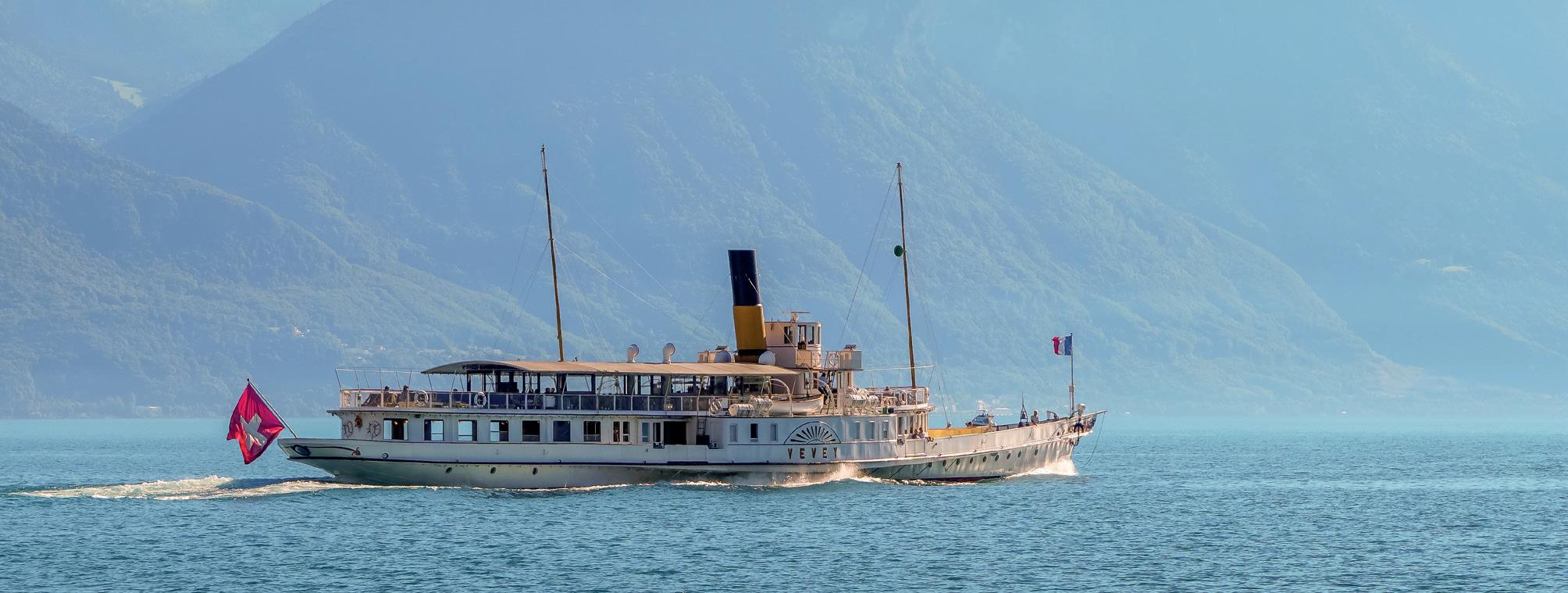
À TOUTE VAPEUR / / / FULL STEAM AHEAD / / / MIT VOLLDAMPF VORAUS 43
© Filigrane SA/Jacques Straesslé
1823 – 1870
1870 - 1880
Mobilité lacustre et accords franco-suisses
1880 - 1930
1930 - 1950
1950 - 1965
1965 - 1990
1990 - 2002
En août 2018, les autorités vaudoises et françaises signent une convention de coopération entre les deux rives, tandis que le trafic pendulaire sur le Léman se développe de manière significative. À une époque où l’écologie est désormais une priorité, le transport par voie lacustre devient une alternative publique indispensable au trafic automobile individuel, qui engorge toujours plus fréquemment la région transfrontalière. Suite à un appel d’offres public international, un premier exemplaire de NAVIEXPRESS, répondant à un besoin croissant de mobilité compatible avec les enjeux de durabilité, est commandé pour l’été 2023. Pensé pour améliorer le confort des passagers, en s’inspirant notamment du système ferroviaire suisse, et pour réduire l’impact environnemental du transport lacustre, ce premier navire hybride lémanique est doté de 150 m2 de panneaux solaires et d’une coque en aluminium optimisée pour réduire l’utilisation de carburant. À terme, la CGN, toujours prête à relever les défis de son temps, envisage de construire des bateaux zéro émission dès que la technologie le permettra. ✵
2002 - 2011
Mobility on the lake and Franco-Swiss agreements
2011 - 2018
2018 - 2023
2018 - 2023
Culture
In August 2018, with commuter traffic on the lake increasing, the authorities of Vaud and France signed a cooperation agreement between the two shores. At a time when ecology is a priority, transport on the lake is becoming an essential public alternative to personal cars, which increasingly clog the cross-border region. Following an international public call for tender, a first NAVIEXPRESS, meeting the growing need for mobility compatible with the issues of sustainability, was ordered for summer 2023. Designed to improve the comfort of the passengers, drawing inspiration from the Swiss railway system, and to reduce the environmental impact of lake transport, this first hybrid boat on the lake was fitted with 150 m 2 of solar panels and an optimised hull to reduce fuel consumption. In the long term, the CGN – always ready to take up the challenges of its age – plans to build zero-emission boats as soon as the technology allows. ✵
DEUTSCHER TEXT Seiten 78 - 88
La navigation, c’est le mouvement, ainsi que l’illustre ce cliché plein de poésie de la photographe suisse Sarah Carp. Baptisé «La femme au foulard», il est issu de son projet «Lac sensible», présenté au Musée du Léman en 2015.
Fleuron de la technologie hybride, le premier exemplaire du NAVIEXPRESS s’apprête à transporter ses premiers passagers sur les eaux du Léman. L’offre de navettes transfrontalières change le lac en un axe direct entre la France et la Suisse.
A reminder that navigation is movement, as illustrated by this poetic picture by Swiss photographer Sarah Carp. Called «La femme au foulard», it is part of her «Lac sensible» project, exhibited at the Musée du Léman in 2015.
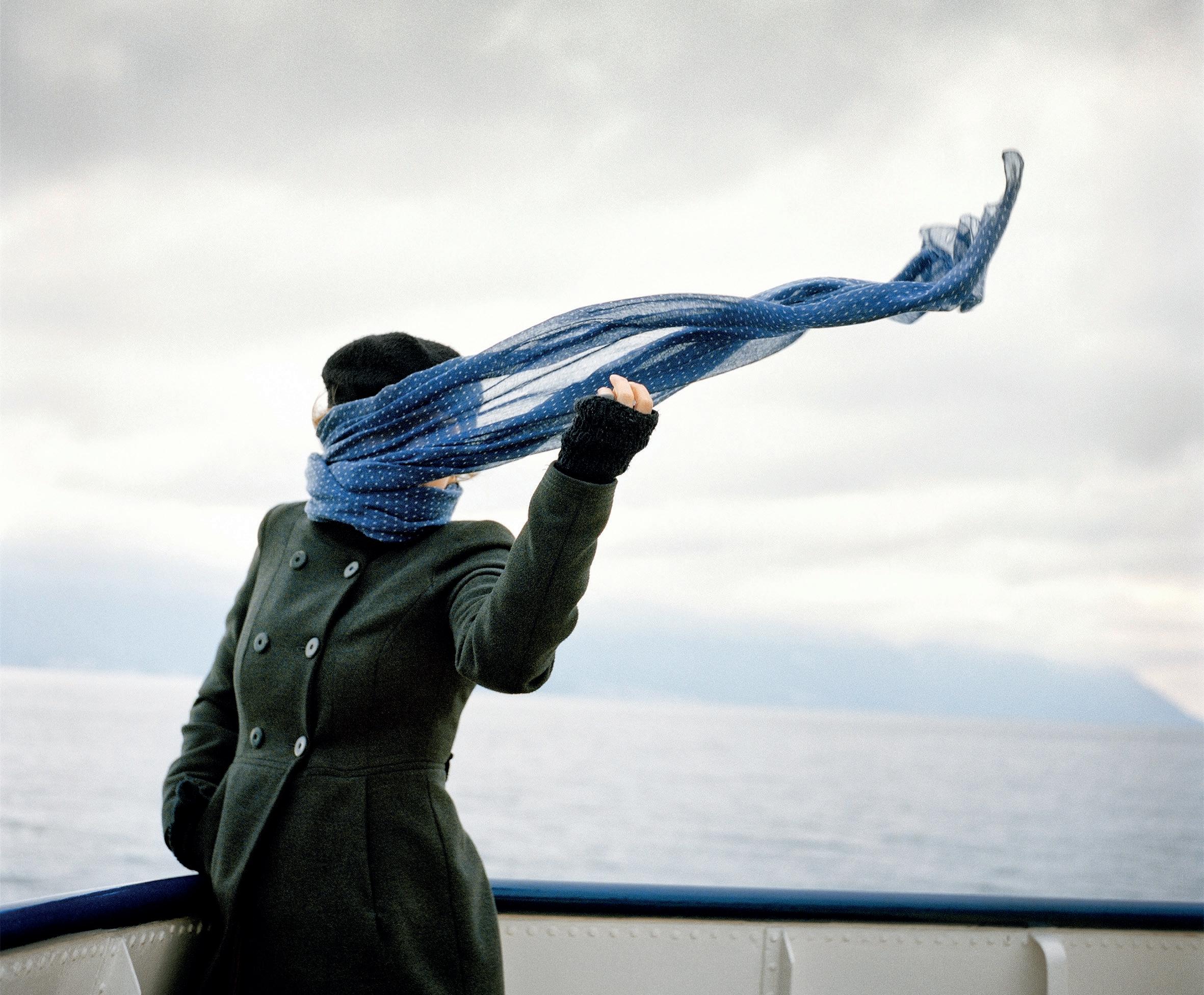
The flagship of hybrid technology, the very first NAVIEXPRESS is about to carry its first passengers on Lake Geneva. The cross-border shuttle service turns the lake into a direct route between France and Switzerland.
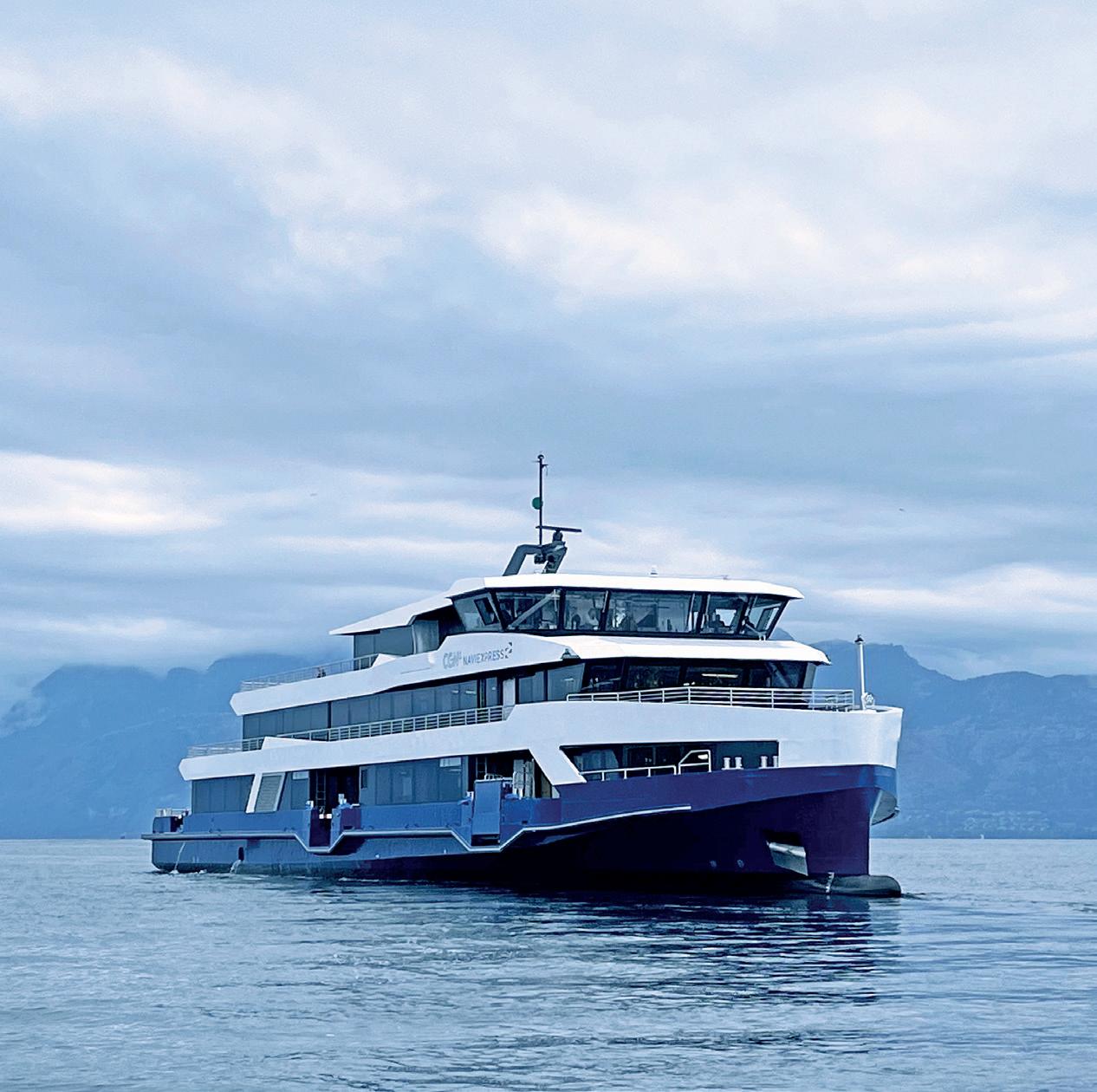
À TOUTE VAPEUR / / / FULL STEAM AHEAD / / / MIT VOLLDAMPF VORAUS 45
© Sarah Carp / CGN
1823 – 1870
1870 - 1880
1880 - 1930
1930 - 1950
1950 - 1965
1965 - 1990
1990 - 2002
2002 - 2011
Contribuer à faire naviguer toute l’année et par tous les temps une flotte historique, ce n’est pas seulement une prouesse technique, c’est aussi inscrire ces navires dans l’imaginaire collectif. Aujourd’hui, la silhouette blanche élancée des bateaux Belle Époque fait partie intégrante du panorama du bassin lémanique. Devenus des éléments de décor au même titre que les sommets alpins, que les monuments locaux ou que le jet d’eau de Genève, ces navires apparaissent dans des tableaux et des illustrations, se glissent dans l’arrière-plan des cartes postales, des affiches et des photos-souvenirs, et jouent même parfois un rôle au cinéma : en octobre 2012, l’embarcadère du Bouveret voit se jouer un drame sentimental aux portes de la révolution bolchevique, pour le film russe Coup de soleil. L’action se déroule en bonne partie à bord du Rhône, transformé en éphémère vapeur fluvial, de La Suisse et du Montreux Une décennie après la fondation de l’ABVL, l’Association et la Compagnie sont honorées du Prix du patrimoine culturel de l’Union européenne à Vienne, le Concours Europa Nostra, pour la sauvegarde exemplaire de la flotte Belle Époque. Véritables emblèmes du lac, les fiers bateaux d’antan n’ont pas fini de faire rêver. ✵
The
2011 - 2018
2018 - 2023 Culture
Contributing to ensuring that a historic fleet can operate throughout the year and in all weather is not merely a technical feat. It also ensures that these boats are a part of the collective imagination. Today, the slender white outline of the Belle Époque vessels are an integral part of the vista over Lake Geneva. An essential part of the landscape like the Alpine peaks, the local monuments and the Jet d’eau in Geneva, these boats appear in paintings and illustrations, slip into the background of postcards, posters and souvenir photos, and can sometimes even be seen on the big screen : in October 2012, the jetty in Le Bouveret was the setting for a sentimental drama set at the time of the Bolshevik revolution, for the Russian film Coup de soleil. A good part of the action takes place on the Rhône, transformed into a temporary river steamer, La Suisse and the Montreux.
A decade after the ABVL was founded, both the association and the company were awarded the European Union cultural heritage aware, Europa Nostra, in Vienna for the exemplary conservation of the Belle Époque fleet. True emblems of the lake, the proud vessels of yesteryear are still making people dream today. ✵
Culture
Les bateaux Belle Époque, véritables emblèmes du Léman
Belle Époque boats, true emblems of the lake
DEUTSCHER TEXT Seiten 78 - 88
Assiette décorative de la fin du XIXe siècle ornée d’une scène du France à quai à Genève.
Jacques de Loustal intégrait la silhouette bien connue d’un bateau à vapeur du Léman sur l’affiche réalisée pour le festival BD-FIL en 2011. La prochaine édition aura lieu du 1er au 14 mai 2023.
Decorative plate from the late 19th century depicting the France at quay in Geneva.

Jacques de Loustal integrated the wellknown silhouette of a steamboat on the poster created for the BD-FIL festival in 2011. The next edition will take place from 1 to 14 May 2023.
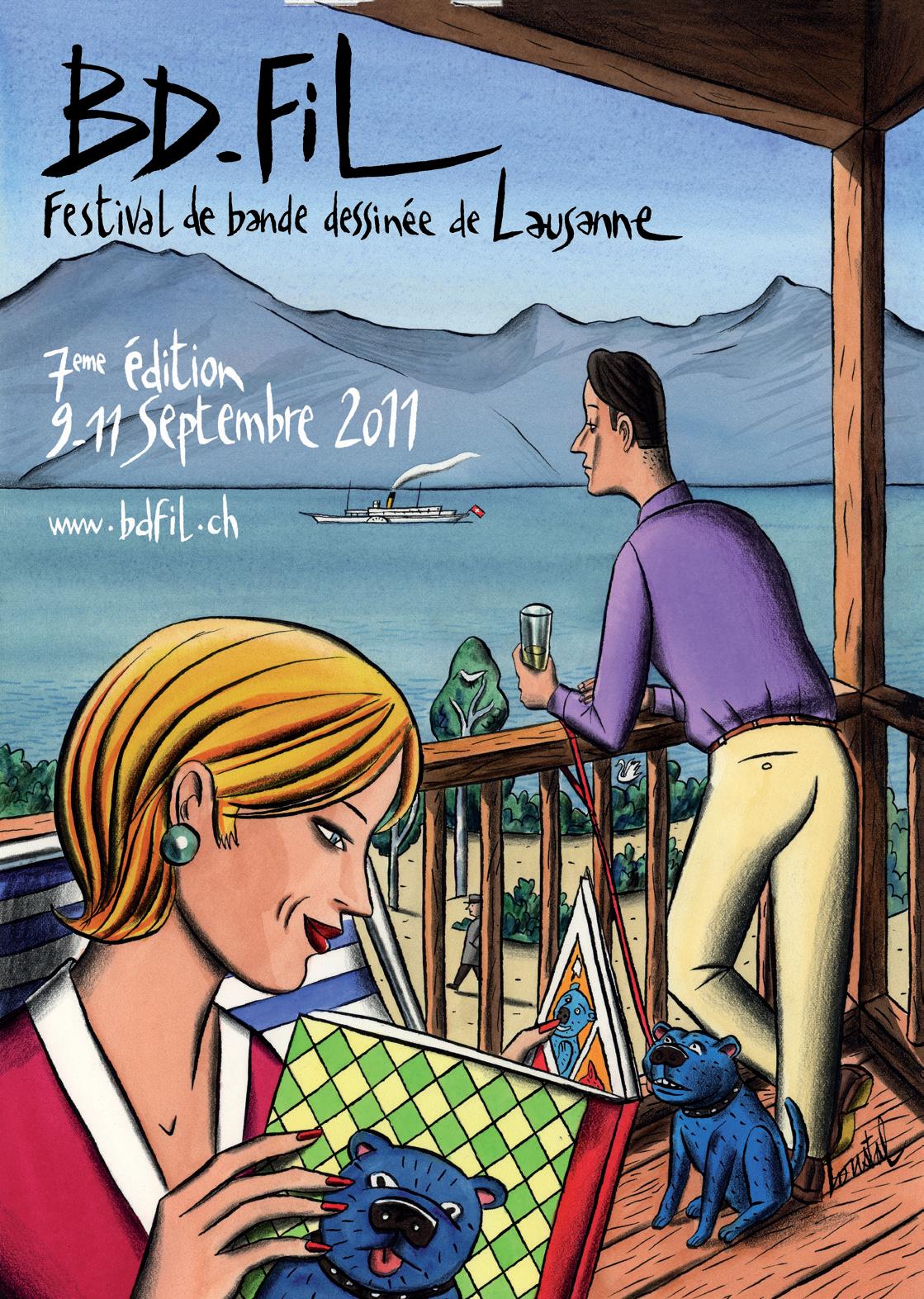
Les bateaux à vapeur du Léman sont parfois mis en scène dans des tableaux d’inspiration romantique, comme cette huile signée du peintre de marine français Chéri François Dubreuil représentant l’Italie I en pleine tempête, datée de 1869.
The steamboats of Lake Geneva are sometimes featured in romantically inspired paintings, such as this oil painting by the French artist Chéri François Dubreuil depicting the Italie I in a storm, dated 1869.
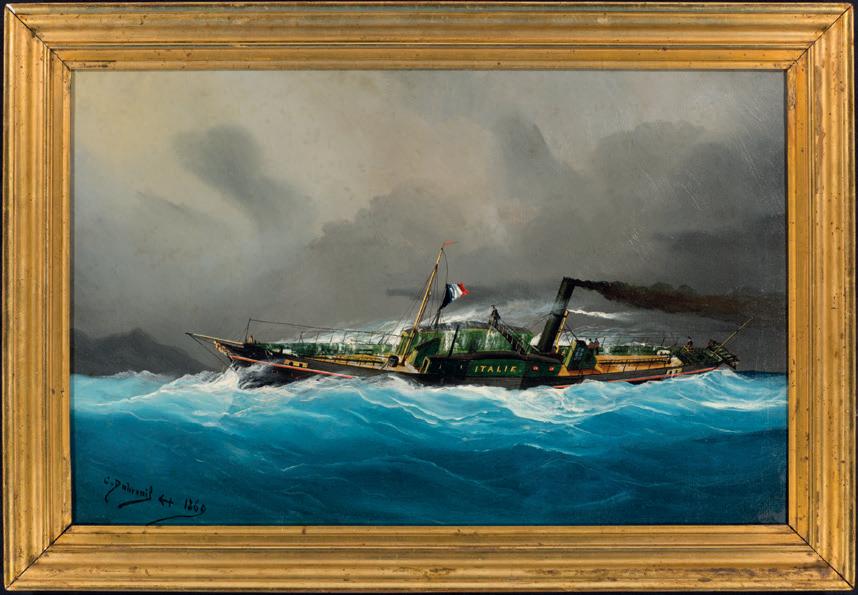
En 2012, l’embarcadère du Bouveret ainsi que trois navires servent de décor lors du tournage d’un film historique russe.
In 2012, the Bouveret pier and three ships were used as a set for a Russian historical film.
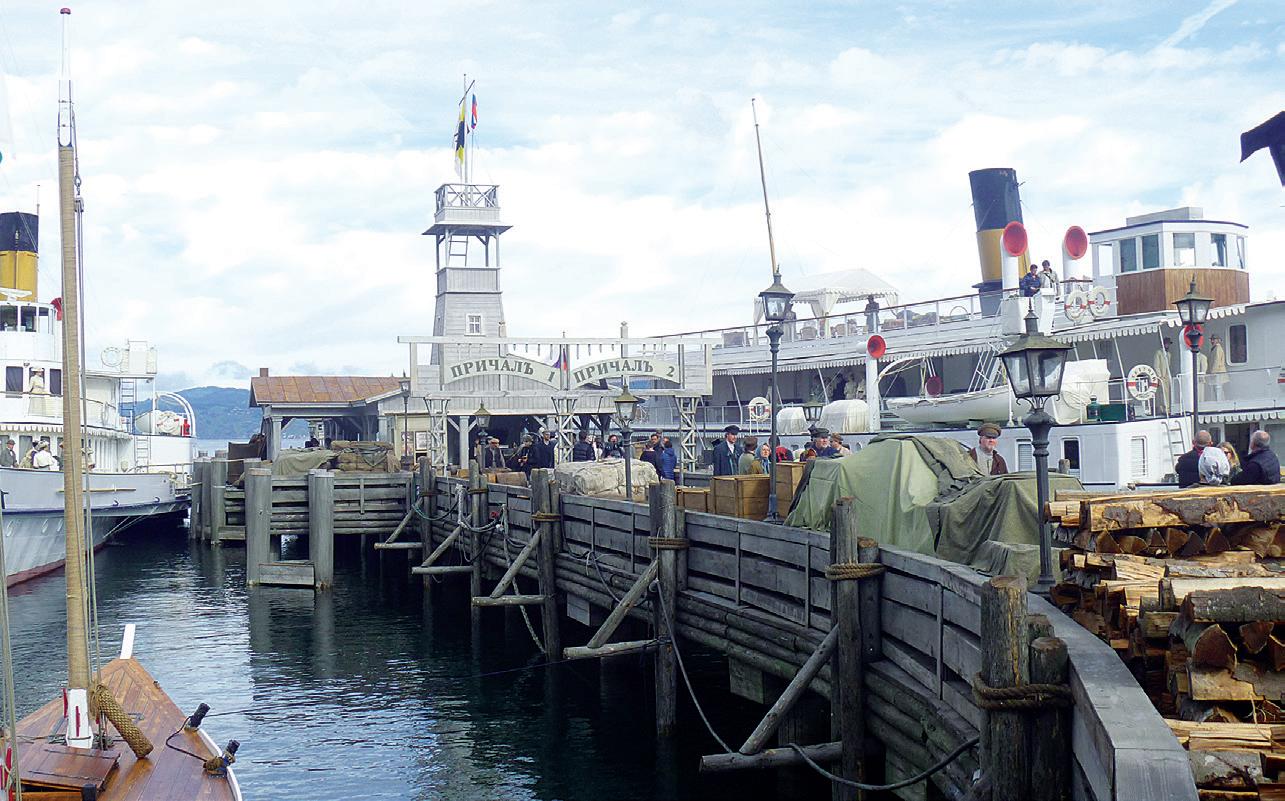
À TOUTE VAPEUR / / / FULL STEAM AHEAD / / / MIT VOLLDAMPF VORAUS 47
© Collection du Musée du Léman / Roland Blaettler (photo) / Festival BD-FIL / CGN
De 1873 à 2023, 150 ans de traversées du lac Léman
À l’occasion de son cent-cinquantenaire, la Compagnie Générale de Navigation (CGN) célébrera l’ensemble des acteurs qui ont été partie prenante de son développement depuis 1873 ainsi que ceux qui œuvrent quotidiennement sur les eaux bleues du Léman. Les festivités, qui ont débuté en janvier 2023, se poursuivront toute l’année selon un programme riche en surprises.
De janvier à décembre 2023, douze thématiques seront mises à l’honneur, s’égrenant au fil des mois sous forme d’événements, de concours et d’offres attractives sur certaines croisières touristiques, notamment les croisières Lavaux Tour, les cartes journalières et les croisières découvertes du NAVIEXPRESS. Lors des portes ouvertes au chantier naval d’Ouchy, prévues les 15 et 16 avril 2023, la CGN créera un « village du lac » dans lequel plusieurs acteurs du Léman tels que l’Association des amis des bateaux à vapeur du Léman (ABVL) ou la Société internationale de sauvetage du Léman seront présents afin d’accueillir le public. À l’arrivée des beaux jours, l’immanquable parade navale aura lieu le 14 mai à Morges pour le plaisir des petits et des grands. En parallèle, les prouesses technologiques, les savoir-faire de haut vol, les unités Belle Époque à la nostalgie inégalable et leurs usagers seront mis en lumière sous des angles originaux. Sans oublier, côté gastronomie, des mois d’automne dédiés à la découverte des vins de la région.
Un projet artistique à plusieurs mains
La commémoration des 150 ans se fera également en chansons. En effet, en écho au jubilé, le projet musical intitulé « Ici le lac ressemble à la mer » imaginé par l’auteur-compositeur suisse Marc Aymon apportera une touche musicale aux réjouissances. Pour ce faire, l’artiste originaire d’Icogne, en Valais, s’est entouré de musiciens de talent. La CGN, en collaboration avec le Musée du
Léman, où sont conservées toutes ses archives, s’est enthousiasmée pour ce projet artistique et a produit un coffret d’art musical regroupant douze chansons rendant hommage au lac. Si l’opus comportait initialement onze chansons, à l’occasion des 150 ans, Marc Aymon et Jérémie Kisling ont spécifiquement écrit et enregistré à bord d’une embarcation le morceau « Tanguer » avec le chœur de la CGN formé pour l’occasion. La succession des moments forts de cette création ont été immortalisés à travers l’objectif du renommé photographe lausannois Matthieu Gafsou, dont vous retrouverez le travail dans ce magazine.
Une flotte toujours fringante
Avec pour mission de conserver un patrimoine unique, la CGN fait naviguer la plus prestigieuse flotte à vapeur Belle Époque avec roues à aubes du monde depuis plus de 100 ans. Pour y parvenir, elle s’efforce de rénover, de préserver et sauvegarder ces unités au plus proche de leur aspect d’origine, en étroite collaboration avec l’ABVL. Tous les bateaux Belle Époque de la CGN ont été classés monuments historiques par le canton de Vaud en 2011.
Dans l’air du temps
Pour mieux saisir l’unicité de l’histoire de la CGN, créée grâce à la fusion de trois sociétés de navigation à la fin du 19e siècle, il faut plonger dans son histoire. Si aujourd’hui, elle représente un patrimoine en résonance avec les enjeux actuels, c’est parce que la Compagnie générale de navigation a su s’adapter sans cesse pour traverser les événements qui ont marqué la Suisse: les conflits mondiaux, l’impact des aléas économiques, la crise de 1930 mais aussi l’avènement d’un tourisme de luxe unique cohabitant avec les chemins de fer et le développement des palaces autour du lac Léman. Toujours à l’affut de possibilités d’amélioration, à l’heure actuelle, face à l’urgence climatique ses nouveaux défis sont d’ordre écologiques et partic-
ipent activement à trouver de nouvelles solutions durables dans son domaine d’expertise. Ainsi, c’est par son instinct, son écoute et ses prises de risque avec des développements technologiques qu’elle a pu traverser presque deux siècles sans tapage, mais en préservant une élégance qui fait l’identité de la maison.
Tout au long de l’année, la CGN tiendra à valoriser et rendre hommage à toutes celles et tous ceux qui l’ont épaulée et accompagnée pour devenir ce qu’elle est aujourd’hui. ✵
Pour plus d’informations quant aux festivités de la CGN au cours de l’année :
www.cgn.ch/150ans
Musée du Léman
Exposition « Ici le lac ressemble à la mer », à découvrir jusqu’au
18 janvier 2024.
48 À TOUTE VAPEUR / / / FULL STEAM AHEAD / / / MIT VOLLDAMPF VORAUS
From 1873 to 2023, 150 years of crossing Lake Geneva
On the occasion of its 150th anniversary, the Compagnie Générale de Navigation (CGN) will celebrate the event with everyone who has been involved in its development since 1873, as well as those who work on the blue waters of Lake Geneva every day. The festivities, which began on 16 January 2023, will continue throughout the year with a programme full of surprises.
From January to December 2023, twelve themes will be explored from one month to the next in the form of events, competitions and attractive offers on certain tourist cruises, in particular the Lavaux Tour, the day passes and the NAVIEXPRESS discovery cruises. During the open days at the Ouchy boatyard scheduled for 15 and 16 April 2023, the CGN will create a “lake village” where several organisations from the Lake Geneva area, such as the Association des amis des bateaux à vapeur du Léman (ABVL) or the Société internationale de sauvetage du Léman, will be on hand to welcome the public. When the fine weather arrives, the not-to-bemissed naval parade will be held on 14 May in Morges, much to the pleasure of young and old alike. At the same time, technological feats, ancestral know-how, the Belle Époque boats with their unrivalled nostalgia and their users will be placed in the spotlight from a number of different standpoints. And let’s not forget that the autumn months will be dedicated to discovering the wines of the region.
A multi-party artistic project
The commemoration of the 150th anniversary will also be played out in songs. Echoing the anniversary, the artistic project entitled “Ici le lac ressemble à la mer” – dreamed up by Swiss singer-songwriter Marc Aymon, will add a musical touch to the festivities. Born in Icogne, Valais, the artist called on a number of talented musicians. In collaboration with the Musée du Léman where all its archives are stored, the CGN really got
behind this artistic project and produced a musical box set comprising twelve songs paying tribute to the lake. While the collection initially had eleven songs, Marc Aymon and Jérémie Kisling wrote a piece called Tanguer specially for the 150th anniversary and recorded it on one of the boats together with the CGN choir, formed for the occasion. The highlights of this creation were immortalised through the lens of the famous Lausanne-based photographer, Matthieu Gafsou, whose work is reproduced in this magazine.
A fleet as stylish as ever
With the aim of conserving a unique heritage, the CGN has operated the most prestigious fleet of Belle Époque paddle steamers in the world for over 100 years. To achieve this goal, it works in close collaboration with the ABVL to renovate, preserve and maintain these vessels in a state as close as possible to their original look. All the Belle Époque vessels of the CGN were classified as historic monuments by the canton of Vaud in 2011.
In keeping with the times
To better grasp the unique character of the history of the CGN, founded through the merger of three sailing companies at the end of the 19th century, you really need to plunge into its history. If it represents a heritage that resonates with current issues, it’s because the Compagnie Générale de Navigation has constantly moved with the times to navigate the key events that have marked Switzerland: global conflicts, the impact of economic ups and downs, the crisis of 1930 and the advent of a unique form of luxury tourism that appeared with the building of the railways and the development of the luxury hotels around Lake Geneva. Always looking for opportunities to improve, the new challenges it faces in this time of climate emergency are linked to the environment, playing an active role in identifying new, sustainable
solutions in its field of expertise. So it is thanks to its instinct, its attentiveness and its risk-taking with bold technological developments that the company has calmly navigated its way through almost two centuries while retaining the elegance which forms its quintessential identity.
Throughout the year, the CGN will promote and pay tribute to everyone who has supported and accompanied it over the years so that it could become what it is today. ✵
For more information on the CGN festivities throughout the year: www.cgn.ch/150ans
visitors until 18 January 2024.
À TOUTE VAPEUR / / / FULL STEAM AHEAD / / / MIT VOLLDAMPF VORAUS 49
Musée du Léman Exhibition entitled “Ici le lac ressemble à la mer”, open to
DEUTSCHER TEXT Seiten 78 - 88
Nouveau !
CD "ICI, LE LAC RESSEMBLE À LA MER"
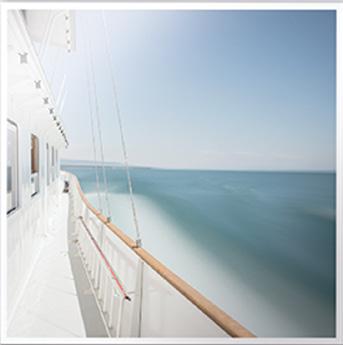
CHF 15.–
LES CHANSONS DU LÉMAN - EDITION LIMITÉE
Nouveau !
TOTE BAG 150 ANS
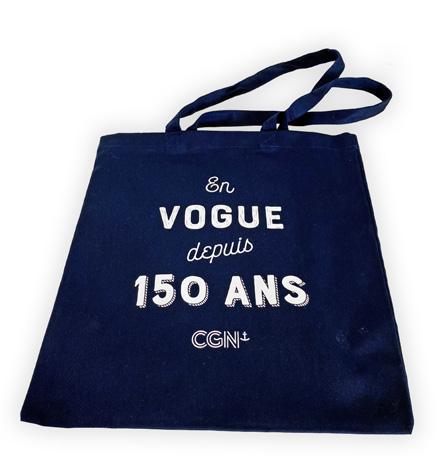
CHF 10.–
LUNETTES DE SOLEIL SUNGLASSES
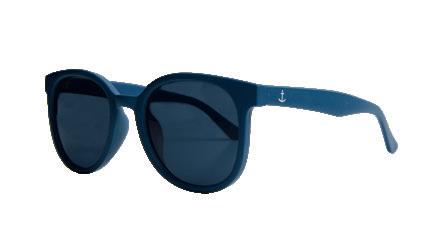
CHF
Nouveau !
VERRE 150 ANS (12.5 CL.)

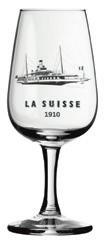
CHF 10.–
CASQUETTE ENFANT CAP KIDS
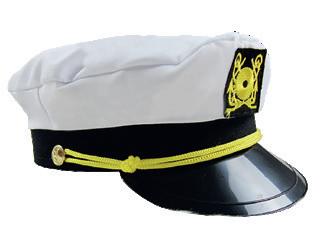
CHF 10.–
JASS BOX
CHF 15.–
Jeu de 36 cartes, ardoise, éponge, crayon et taille-crayon.
Game of 36 cards, slate, sponge, pencil and sharpener.
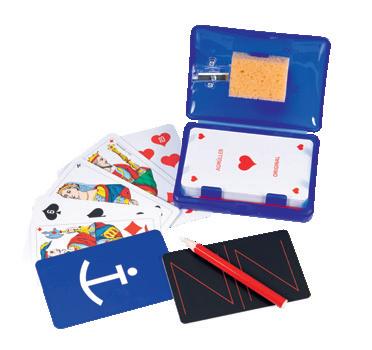
ON SALE AT OUR TICKET OFFICES
TASSE DU CAPITAINE CAPTAIN'S MUG
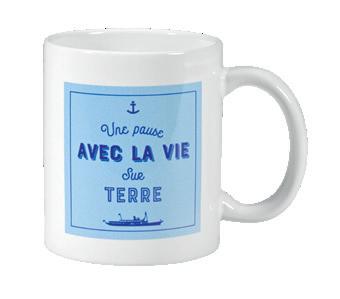
CHF 8.–
VERRES BELLE ÉPOQUE BELLE EPOQUE GLASSES
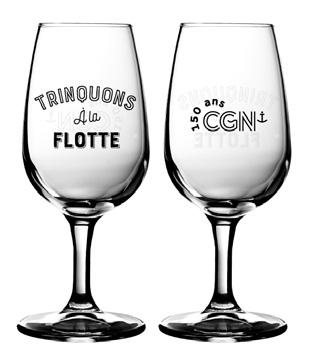
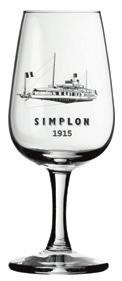

CHF 10.–LE VERRE
PUB
AFFICHE POSTER CHF 5.–
CARTE POSTALE POSTCARD CHF 2.–
MAGNET CHF 5.–
Également en vente sur Also available on CGN.CH
50 À TOUTE VAPEUR / / / FULL STEAM AHEAD / / / MIT VOLLDAMPF VORAUS
LA BOUTIQUE
Marc Aymon, l’étendue sentimentale
Le chanteur suisse a fait escale au bord du lac Léman, dont la beauté intemporelle est une source d’inspiration, et a enregistré un album sous forme de coffret musical intitulé « Ici le lac ressemble à la mer », qui célèbre les 150 ans de la CGN. Pour À toute vapeur, il raconte cette aventure.
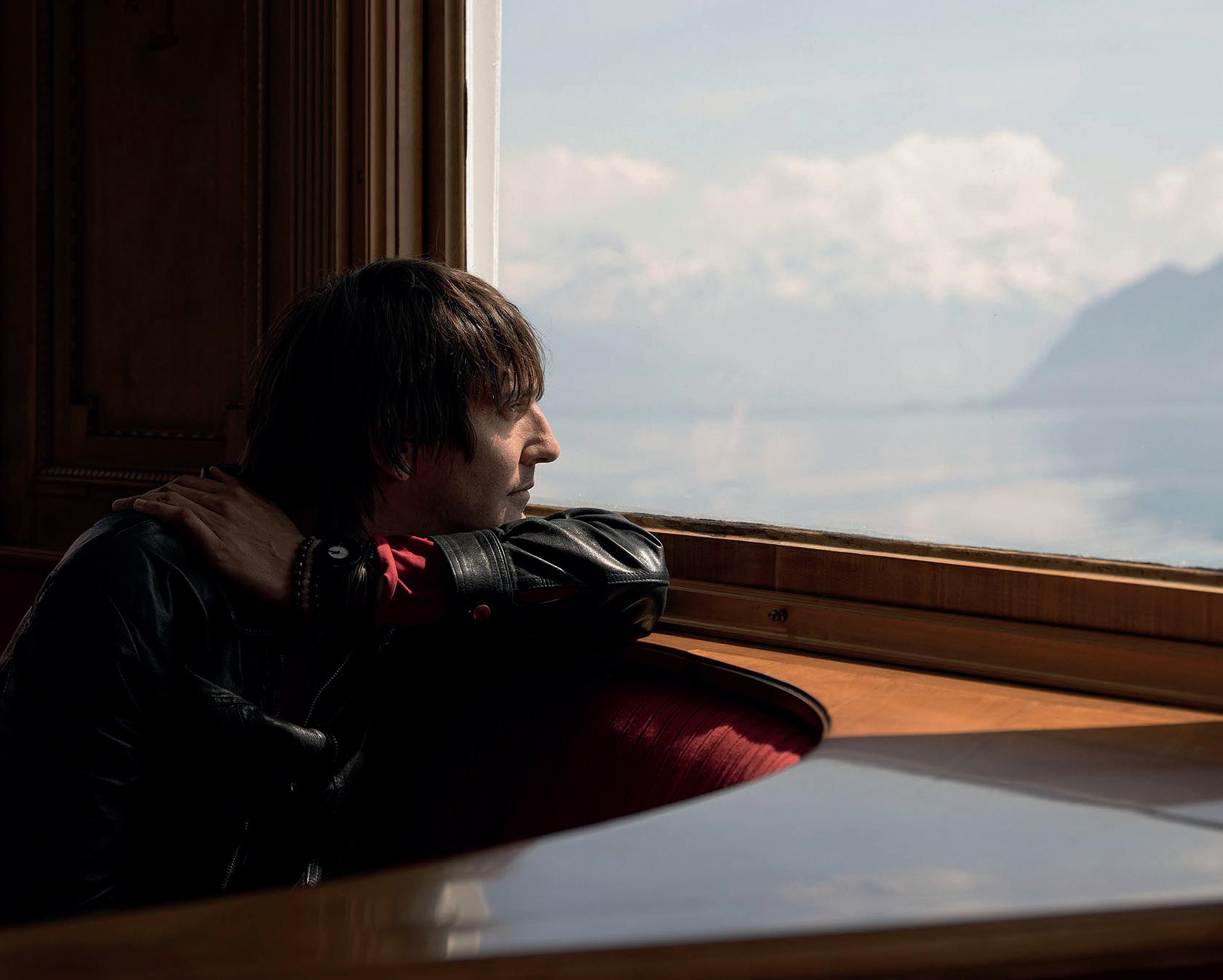
«Dans l’imaginaire collectif helvétique, nous avons tous une kyrielle d’images liées aux bateaux Belle Époque naviguant sur les eaux du Léman. Alors, quand Andreas Bergmann (ancien directeur général de la CGN) m’a proposé une carte blanche artistique, je n’ai pas hésité une seconde. » Nous sommes en 2021, à l’issue d’un concert du chanteur-compositeur valaisan. Pour Marc Aymon, ce projet entre en résonance avec un autre travail dans lequel il est
justement plongé pour le Musée du Léman : la recherche et la réinterprétation de chansons liées au lac, en vue de la création de l’exposition “Ici le lac ressemble à la mer.” « L’approche a été très intuitive, sans secousses, se souvient-il. On m’a donné une entière liberté et l’équipe a fait preuve d’une immense prévenance. Au cœur du processus de création, pouvoir être aussi libre a été absolument inspirant. »
Création collective
Il a fallu une année de travail pour faire aboutir le projet : douze chansons, une par mois, évoquant plusieurs facettes de l’environnement lacustre, qui se savourent comme des bonbons. Si certaines chansons sont des reprises, quatre titres sont des créations originales. Pour ce faire, l’artiste, amoureux
du folk, s’est entouré de chanteurs et de musiciens de talent : Jérémie Kisling, Milla, François Vé, Aliose ou encore le regretté Michel Bühler. Du côté visuel, les photographies accompagnant les compositions sont le fruit du travail de son ami de longue date l’artiste lausannois Matthieu Gafsou, dont il aime le travail sensible et humaniste. « Réunir ces personnalités si diverses autour d’une aventure commune est véritablement l’une des forces de cet opus. Avec le soutien de la CGN, nous avons ainsi pu élaborer un coffret d’art, un véritable écrin regroupant un vinyle, un CD, un livre photographique contenant les textes, ainsi qu’un code de téléchargement. Nous avons poussé le soin du détail jusqu’à créer une typographie sur mesure. La préoccupation, tout au long du processus, a été de créer avec des artisans locaux, des graphistes à l’imprimeur et jusqu’à la reliure au fil. C’est ce que je cherche à faire dans mes projets », explique l’auteur-compositeur. On décèle dans chacun de ses propos les valeurs éthiques qui sont les siennes, et sa volonté de donner du sens.
Lorsque Marc Aymon s’exprime, c’est avec un enthousiasme dans lequel se glisse un doux mélange d’humilité et de gratitude. D’emblée, il évoque l’attitude généreuse et accueillante dont ont fait preuve les membres de la CGN. On sent un esprit qui fourmille d’idées, une créativité sans cesse stimulée. « Les liens, les souvenirs et l’osmose que nous avons su créer au travers de la musique m’émeuvent et apportent un réel sens au projet. » Un fil rouge fondamental pour cet éternel sensible.
À TOUTE VAPEUR / / / FULL STEAM AHEAD / / / MIT VOLLDAMPF VORAUS 51
©
Matthieu Gafsou
Morceau enregistré à bord
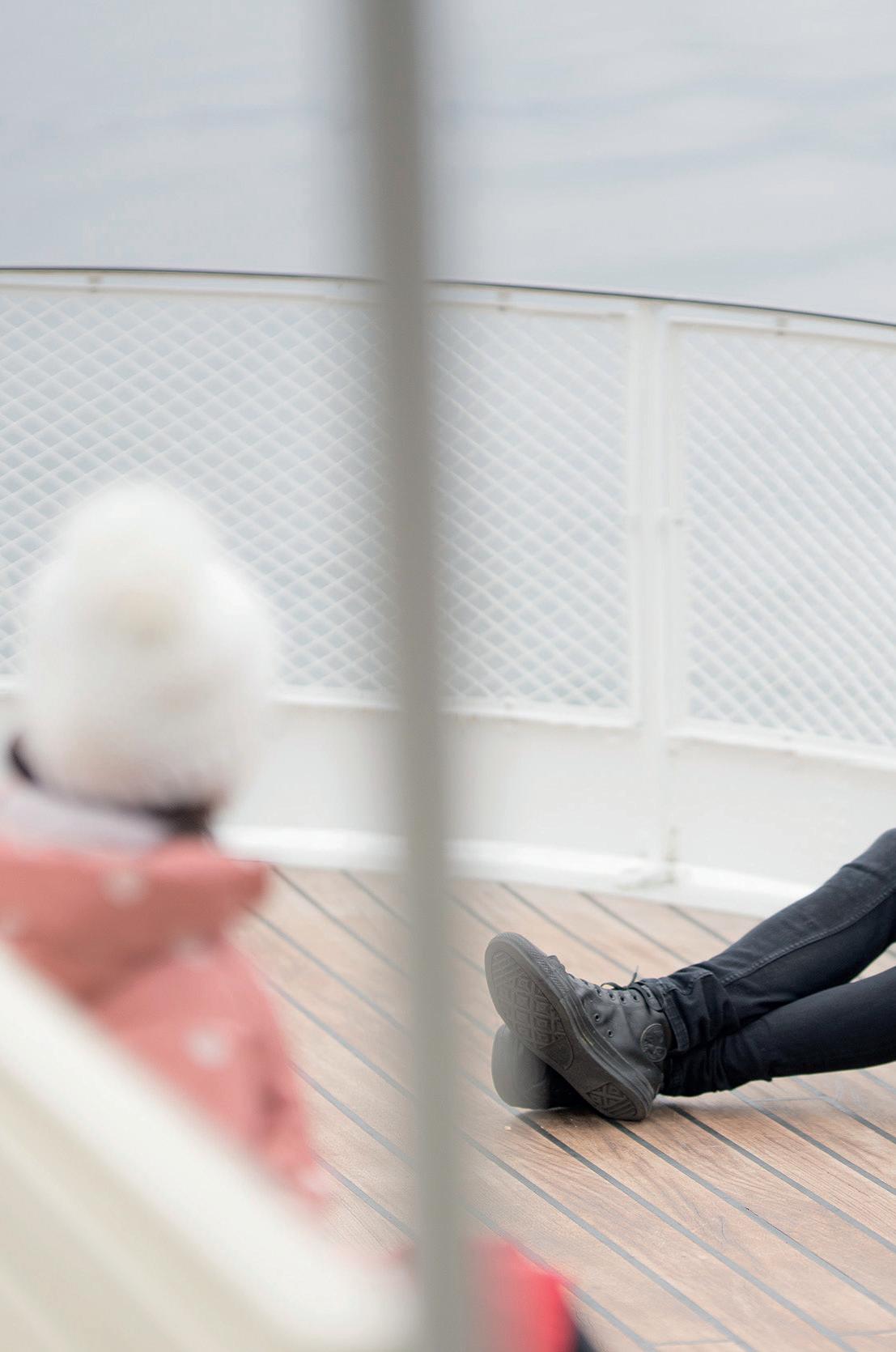
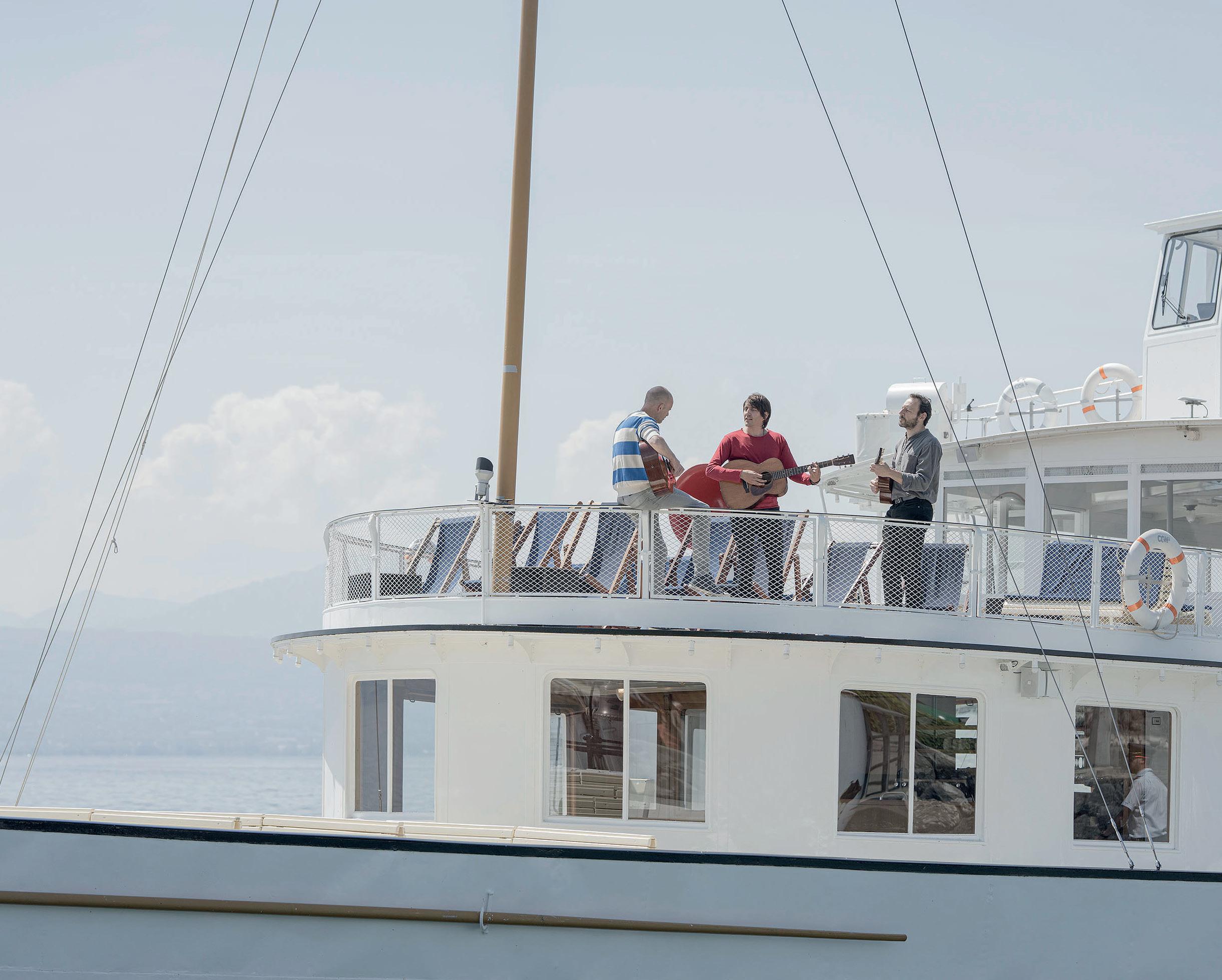
Pour le morceau Tanguer, expressément composé à la CGN, un studio a été installé dans le salon du vapeur Belle Époque Rhône, datant de 1927. « Avec le réalisateur Frédéric Jaillard, Jérémie Kisling à la guitare et le chœur de la CGN formé pour l’occasion, nous avons pu enregistrer dans une salle à la moquette violette, dont les larges fenêtres donnaient sur le lac, raconte le chanteur. L’atmosphère ambiante nous a fait renouer avec le passé. La marqueterie, le bercement des flots, les lieux nous ont fortement imprégnés. »
Dans l’introduction du morceau, Marc Aymon a même convoqué le chuintement des machines situées dans les cales du navire, qui se calque parfaitement sur les premières mesures et nous embarque dans un autre univers. Puis il y a le refrain rassembleur, chanté par le chœur de la CGN, qui rappelle l’idée que l’on se fait du monde de ceux qui naviguent sur l’eau. « Pour moi qui ai
grandi en lisant les aventures d’Arthur Gordon Pym et en rêvant d’être un peu marin, c’était une expérience extraordinaire, comme un rêve d’enfant exaucé », conclut l’artiste.
Du reste, à l’écoute des titres de ce magnifique disque-objet, il suffit d’entendre les premières notes du morceau pour laisser derrière soi le battement agité de la vie citadine. On est vite touché par l’émotion vibrante qui célèbre la vie pleine, la liberté du verbe, la beauté du monde. Un résultat que le public pourra découvrir au fil des mois, avec pour point d’orgue des concerts exclusifs... sur les bateaux, bien sûr. ✵
Mireille Jaccard
52 À TOUTE VAPEUR / / / FULL STEAM AHEAD / / / MIT VOLLDAMPF VORAUS
©
Matthieu
Gafsou / Matthieu
Gafsou
!
to all songs here !
Ecoutez toutes les chansons ici
Listen
Marc Aymon, the full sentimental range
The Swiss singer visited the shores of Lake Geneva, whose timeless beauty is a source of inspiration, to record an album in the form of a musical box set entitled “Ici le lac ressemble à la mer” and celebrating the 150th anniversary of the CGN. He tells À toute vapeur about the adventure.
“In the Swiss collective imagination, we all have a host of images relating to the Belle Époque boats plying the waters of Lake Geneva. So when Andreas Bergman (former General Manager of the CGN), offered me artistic carte blanche, I absolutely jumped at the chance.” It was 2021, at the end of a concert by the singer-songwriter and native of the Valais region. For Marc Aymon, this project resonated with another one he was working on for the Musée du Léman: researching and reinterpreting songs linked to the lake with a view to creating the “Ici le lac ressemble à la mer” exhibi-
tion. “The approach was highly intuitive, a very smooth ride,” he recalls. I was given complete freedom and the entire team was very thoughtful. At the heart of the creative process, enjoying so much freedom was massively inspirational.”
Collective creation
It took a whole year’s work to complete the project: 12 songs, one per month, calling to mind different facets of the lakeside setting and to be savoured like sweets. While certain songs are covers, four are original creations. To reach his goal, the artist – who is a fan of folk music – called on the assistance of talented singers and musicians: Jérémie Kisling, Milla, François Vé, Aliose and the late Michel Bühler. From a visual perspective, the photos accompanying the songs are the fruit of the work of his long-standing friend, the Lausanne-based artist Matthieu Gafsou, whose sensitive and humanist work he greatly appreciates. “Bringing such diverse personalities together around a common adventure is truly one of the strengths of this collection. With the support of the CGN, we developed a genuine artistic box set comprising a record, a CD, a photographic book with texts and a download code. This case makes the music even more original and elegant. We even went so far as to create a tailor-made typography. Throughout the process, the aim was to work with local craftsmen, from the graphic designers to the printer and right up to the wire binding. That’s what I try to achieve in my projects,” explains the singer-songwriter. In every word, we sense his commitment to ethical values and the desire to give meaning.
When Marc Aymon talks, it is with a clear enthusiasm combined with a gentle mix of humility and gratitude. From the very outset, he mentions the generous and welcoming attitude shown by the members of the CGN. We feel a mind teeming with ideas, a creativity that is constantly stimulated. “The links, memo-
ries and osmosis that we created through the music move me and give the project true meaning.” A fundamental common thread for someone who remains an eternally sensitive being.
A song recorded on-board
For the song entitled Tanguer, composed expressly for the CGN, a studio was set up in the saloon of the Belle Époque paddle steamer, Rhône, built in 1927. “With the director, Frédéric Jaillard, Jérémie Kisling on guitar and the CGN choir specially formed for the occasion, we recorded in a room with purple carpet and large windows looking out onto the lake,” recalls the singer. The atmosphere really put us in touch with the past. The marquetry, the light rocking of the waves and the Romanesque locations really gave us a sense of being.”
In the introduction to the piece, Marc Aymon even included the hissing of the engines located in the boat’s hold, which were perfectly in time with the first bars of the song, instantly whisking us away to another world. Then there is the unifying and forceful chorus sung by the CGN choir, recalling the idea we have of the world in which those plying the waters live. “For me, who grew up reading the adventures of Arthur Gordon Pym and dreaming of being something of a sailor, it was an extraordinary experience, like a childhood dream come true,” he concludes.
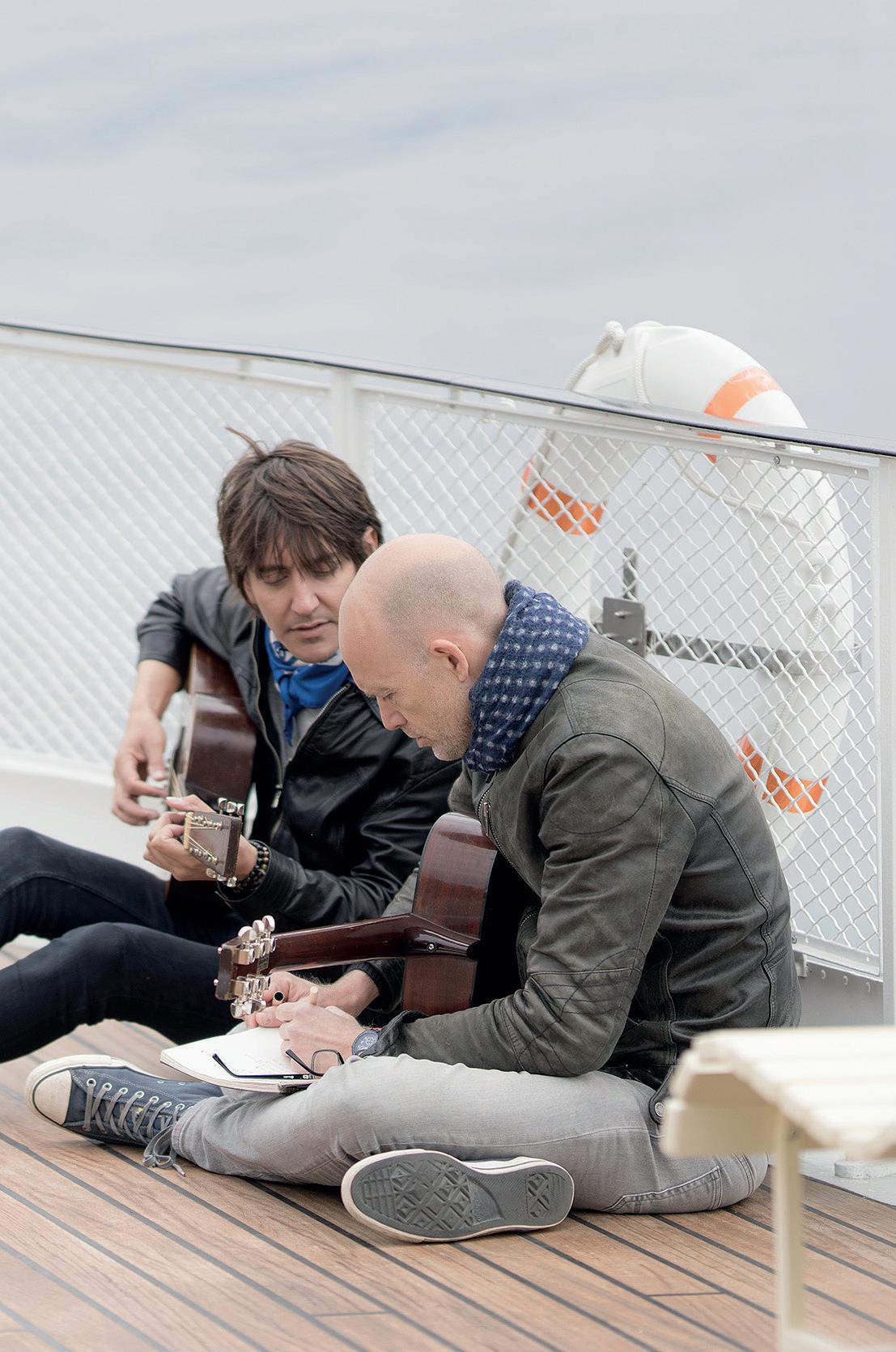
When listening to the songs on this superb disc set, you simply need to hear the first few notes of the song to leave all the stress and the hustle bustle of city life behind. We quickly feel the vibrant emotion that celebrates a full life, the freedom of the verb and the beauty of the world. An end result that the public will be able to discover as the months go by with, as an absolute highlight, a series of concerts... organised on the boats, naturally. ✵
Mireille Jaccard
À TOUTE VAPEUR / / / FULL STEAM AHEAD / / / MIT VOLLDAMPF VORAUS 53
DEUTSCHER TEXT Seiten 78 - 88
Janvier
Àlongueur de journée, les constructeurs de bateaux esquissaient, dessinaient, affinaient le trait et laissaient leur esprit vagabonder. Il y a 150 ans, sur des bureaux que l’on imagine en acajou, recouverts de dessus de cuir brun foncé et tannés par le temps, des centaines de feuilles de papier avaient été griffonnées au crayon dans le mystère des ateliers d’Escher Wyss, puis de Sulzer Frères. Depuis ses premiers temps, la CGN a toujours souhaité offrir à ses usagers des navires dont la technologie de pointe permettait des croisières confortables et une desserte irréprochable pour accompagner l’essor du tourisme en Suisse.
Pour la célébration des 150 ans de la CGN, les offres spéciales s’égrèneront tout au long de l’année. Une occasion rêvée de s’en mettre plein les yeux face aux paysages toujours splendides, quelle que soit la saison, et de renouer avec une nostalgie passée en descendant l’escalier du temps lorsque l’on commence à entendre le souffle des moteurs qui se mettent à chauffer. Un voyage au cœur du voyage, somme toute, pour goûter aux charmes du lac.✵
Chanson : Tanguer, Jérémie Kisling (M. Aymon / J. Kisling)
DEUTSCHER TEXT Seiten 78 - 88
January
All day long, shipbuilders sketched, drew, refined the lines and allowed their mind to wander. Some 150 years ago, perhaps on mahogany desks covered with dark brown leather tanned by time, hundreds of sheets of paper were filled with the pencil sketches in the secret of the Escher Wyss then Sulzer Frères workshops. Since these early days, the CGN has always wanted to provide passengers with boats boasting cutting-edge technology, making for comfortable cruises and a perfect service to accompany the growth of tourism in Switzerland.
To celebrate the 150th anniversary of the CGN, special offers will be available throughout the year. A dream occasion to treat your eyes to stunning landscapes, regardless of the season, and to enjoy a certain nostalgia by turning back time as we hear the murmur of the engines beginning to heat up. A journey to the heart of travel to savour the charms of the lake. ✵
Song:
Tanguer, Jérémie Kisling
(M. Aymon / J. Kisling)

54 À TOUTE VAPEUR / / / FULL STEAM AHEAD / / / MIT VOLLDAMPF VORAUS
01.
©
Matthieu Gafsou
Festivités

À TOUTE VAPEUR / / / FULL STEAM AHEAD / / / MIT VOLLDAMPF VORAUS 55
Février
Dans la fine brume de février, les frimas de la saison froide et l’air somnolent, les embarcations s’estompent sur les eaux. Dans le silence que seul trouble le ronflement tranquille des moteurs, le mouvement lent à la surface offre une place noble aux errances poétiques des amoureux et happe l’esprit. Depuis le milieu du lac, comme si l’on était aspiré par les scènes cinématographiques d’une simplicité sublime qui semblent se prolonger à l’infini, il est soudain possible de voir le monde avec le cœur. La tension s’est relâchée pour laisser place aux chants libres et éraillés des mouettes. Un cadre fabuleux et inspirant, loin de la cacophonie, comme ont su l’entrevoir de nombreux écrivains, poètes et artistes, de Jean-Jacques Rousseau à Clara Haskil en passant par Lord Byron et Freddie Mercury. ✵
Offre :
Rabais de 50% sur les croisières du dimanche à partir de deux personnes (transport uniquement, non cumulable avec d’autres offres).
Chanson : La chanson du lac Léman, Milla et Jérémie Kisling
(G. Koger / V. Scotto / G. Sellers)
February
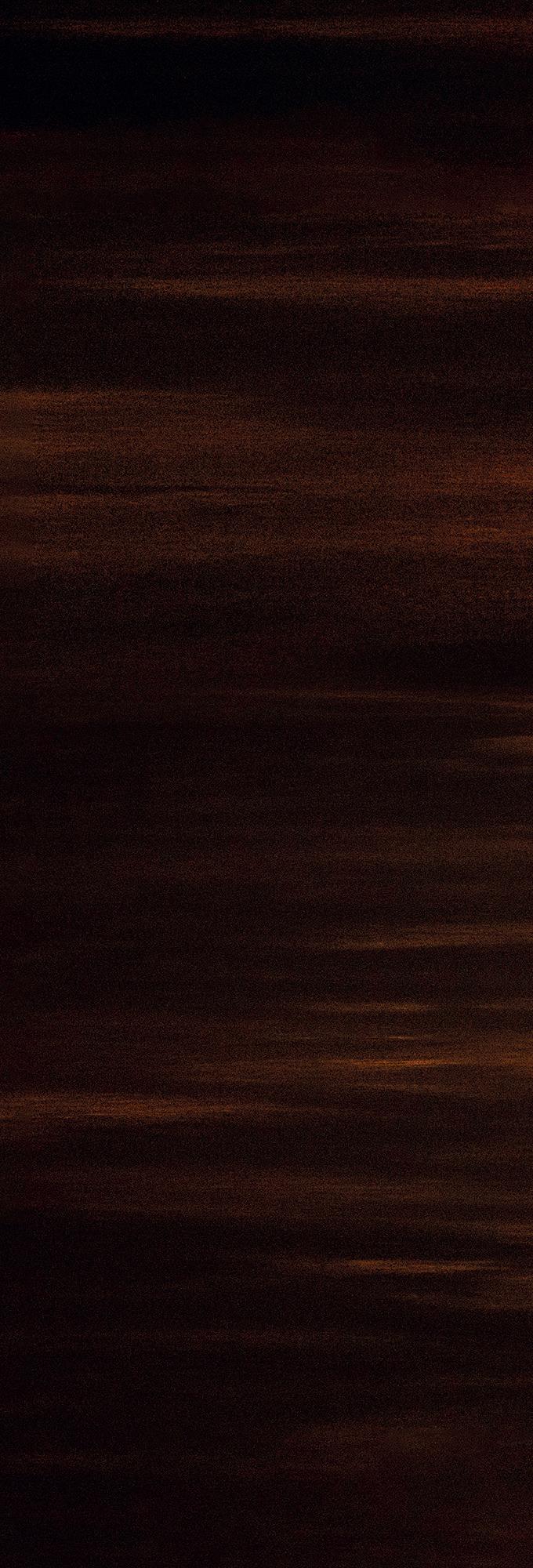
In the fine February mist, the wintry frost and drowsy air, the boats fade away on the water. In the silence disturbed only by the peaceful purring of the engines, the slow movement on the surface provides the ideal conditions for the poetic wanderings of lovers and entraps the mind. From the centre of the lake, as if drawn by film scenes of a sublime simplicity seemingly extending infinitely, it is suddenly possible to see the world with your heart. The tension has been released, giving way to the free, hoarse cries of the seagulls. A stunning, inspirational setting, far from the daily cacophony, enjoyed by numerous writers, poets and artists, from JeanJacques Rousseau to Lord Byron and Freddie Mercury to Clara Haskil. ✵
Offer :
50% discount on Sunday cruises for at least two people (transport only, cannot be used in conjunction with other offers).
Song :
La chanson du lac Léman, Milla and Jérémie Kisling (G. Koger / V. Scotto / G. Sellers)
56 À TOUTE VAPEUR / / / FULL STEAM AHEAD / / / MIT VOLLDAMPF VORAUS
02. DEUTSCHER TEXT Seiten 78 - 88
© Matthieu Gafsou
Romantisme
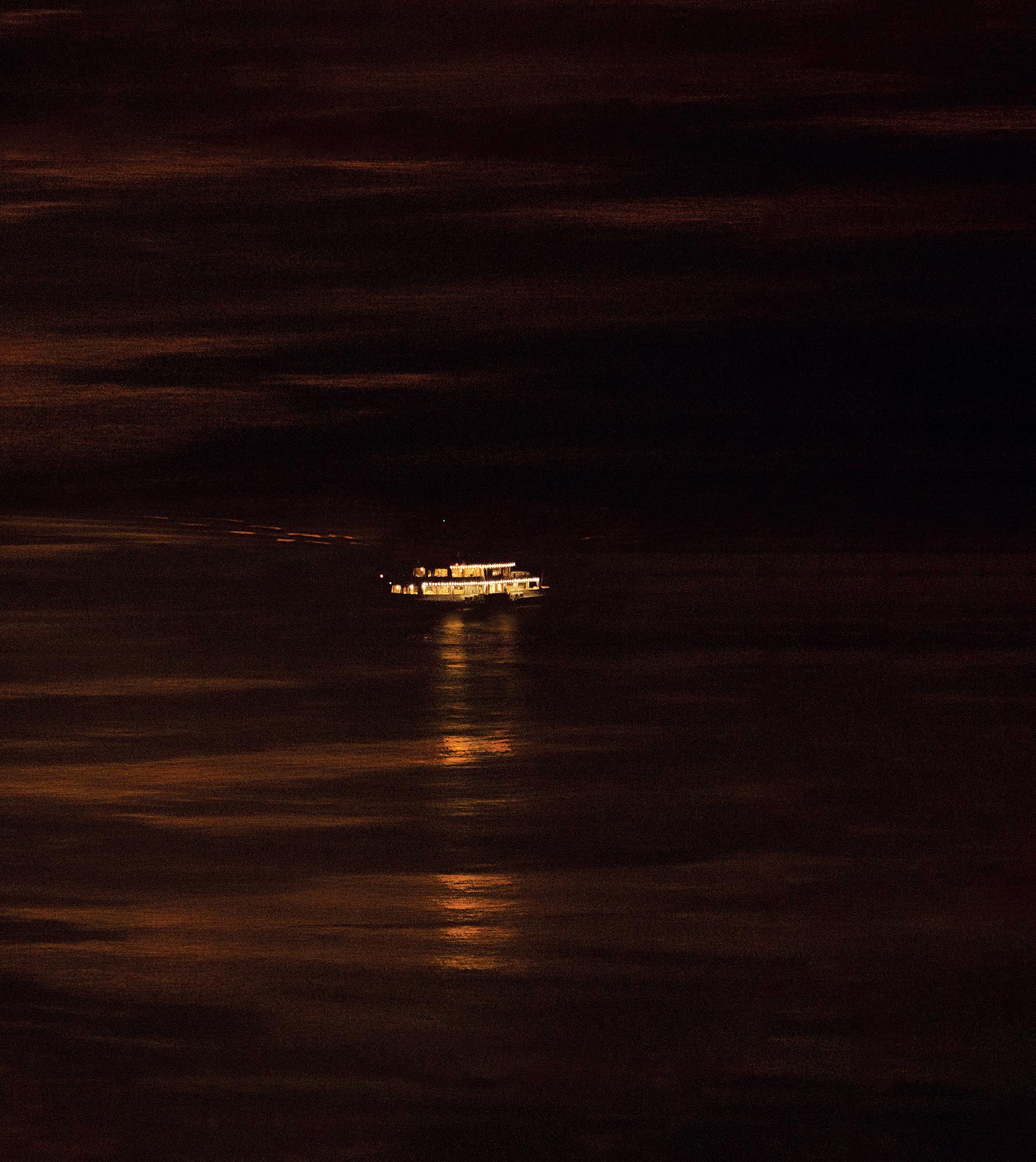
À TOUTE VAPEUR / / / FULL STEAM AHEAD / / / MIT VOLLDAMPF VORAUS 57
Mars
Il y a des terres qui ont le pouvoir d’alléger le cœur, donnent l’envie de suspendre ses pas, de faire demitour. Le chapelet de villes disséminées autour du Léman, qui tutoient le ciel et les reliefs, est de celles-ci. Elles donnent la sensation de vous prendre par la main pour vous faire glisser dans un autre rapport au temps, loin du tourbillon de la vie, pour mieux chasser le vague à l’âme. Sous un ciel immense, le navire longe les villages ensommeillés et les champs en jachère dont on sent le réveil approcher. On quitte Nyon pour accoster, une poignée de minutes plus tard, dans le village médiéval d’Yvoire, où l’air frais s’accroche aux joues tandis qu’un horizon pictural inégalé apaise le regard. Le temps s’est immobilisé un instant, trois fois rien, tout juste le temps d’offrir la sensation d’effleurer la silhouette d’une contrée qui entremêle un patrimoine à son présent. On y apprend la nostalgie des souvenirs, la force du vent capable de dénouer les pensées, l’abandon mélancolique. À travers les parcours élaborés par la CGN, une nouvelle façon de voyager se dessine. Mais elle ne se raconte pas. Elle se vit. ✵
Offre :
Avec la contribution des offices du tourisme qui partagent leurs connaissances du terroir, vous trouverez à bord des guides touristiques consacrés aux croisières Geneva Tour et Lavaux Tour : une mine de bons plans pour découvrir ou redécouvrir les plus beaux villages français et suisses.
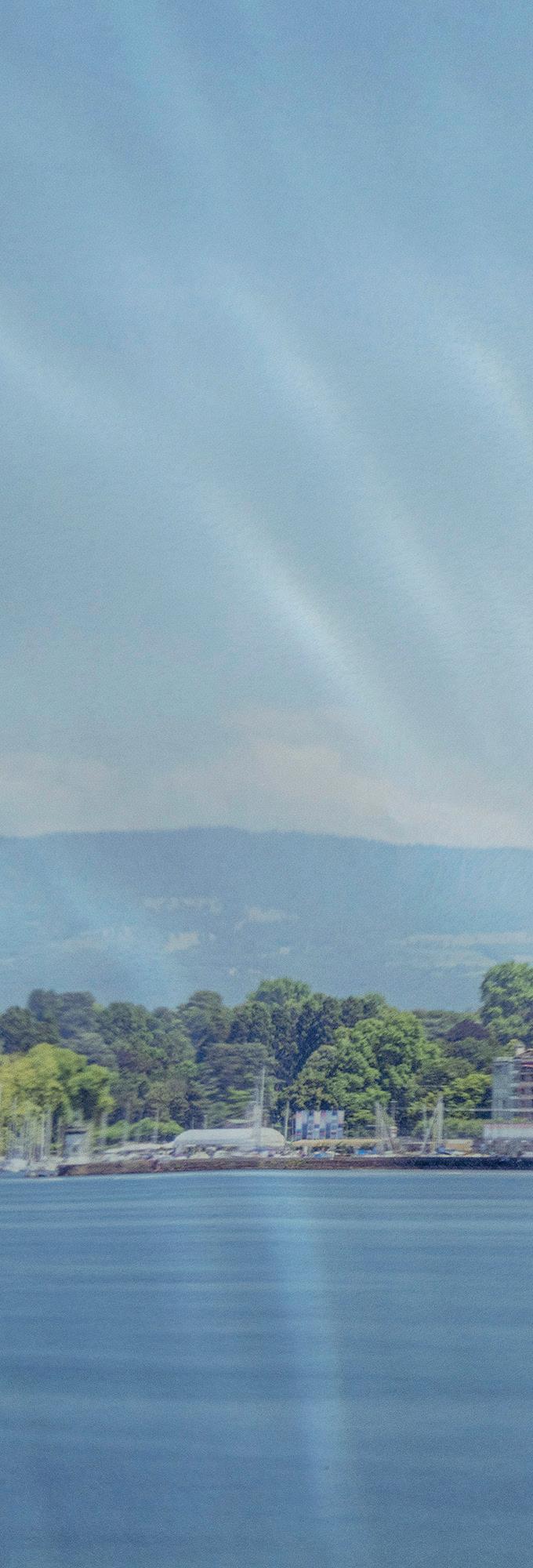
Chanson:
Genève, Marc Aymon (W. Sheller / W. Sheller)
March
There are lands which have the power to lighten the heart, stop walking and turn around. The string or town scattered around Lake Geneva, brushing the sky, is an example of this. It’s as if it takes you by the hand and slips you away to another time, far from the rush of everyday life, to chase away the restlessness. Under a vast sky, the boat slips by sleepy villages and fallow fields which will soon awaken. We leave Nyon to arrive, just a few minutes, later, in the medieval village of Yvoire, where the fresh air sticks to your cheeks and an unrivalled pictorial skyline soothes the eyes. Time stands still for an instant, a blink of the eye –just enough time to give you the feeling of brushing against the outlines of a land where heritage meets the present. We discover the nostalgia of memories, the strength of the wind capable of unravelling thoughts leaving melancholic solitude. Along the routes developed by the CGN, a new way of travelling emerges. But it’s not something that can be explained. You have to experience it. ✵
Offer :
With the contribution of the tourist offices which share their local knowledge, you will find tourist guides on-board devoted to the Geneva Tour and Lavaux Tour cruises: a whole host of great ideas for discovering or rediscovering the most beautiful French and Swiss villages.
Song:
Genève, Marc Aymon
(W. Sheller / W. Sheller
58 À TOUTE VAPEUR / / / FULL STEAM AHEAD / / / MIT VOLLDAMPF VORAUS
03. DEUTSCHER TEXT Seiten 78 - 88
© Matthieu Gafsou
Villes
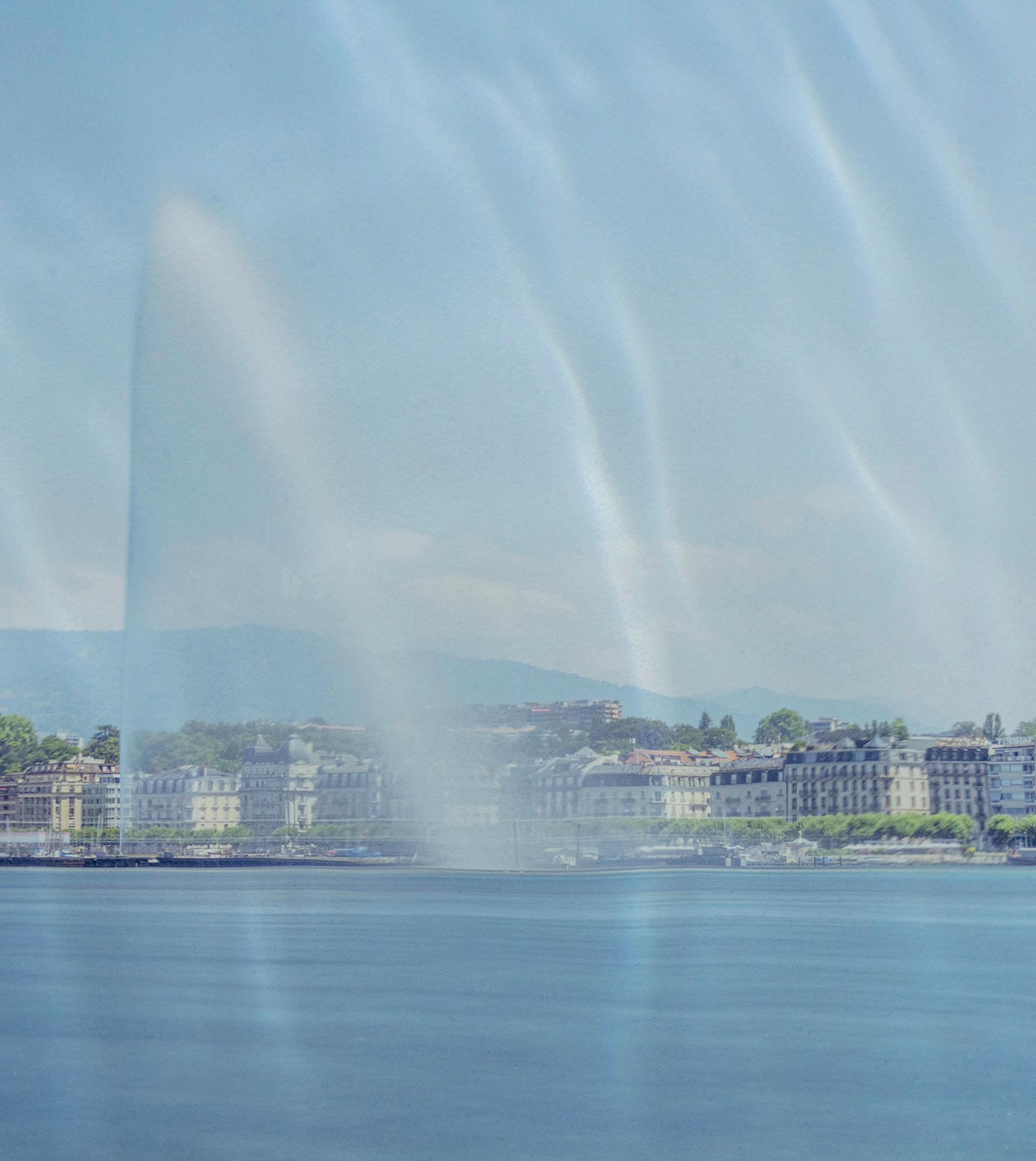
À TOUTE VAPEUR / / / FULL STEAM AHEAD / / / MIT VOLLDAMPF VORAUS 59
Ports
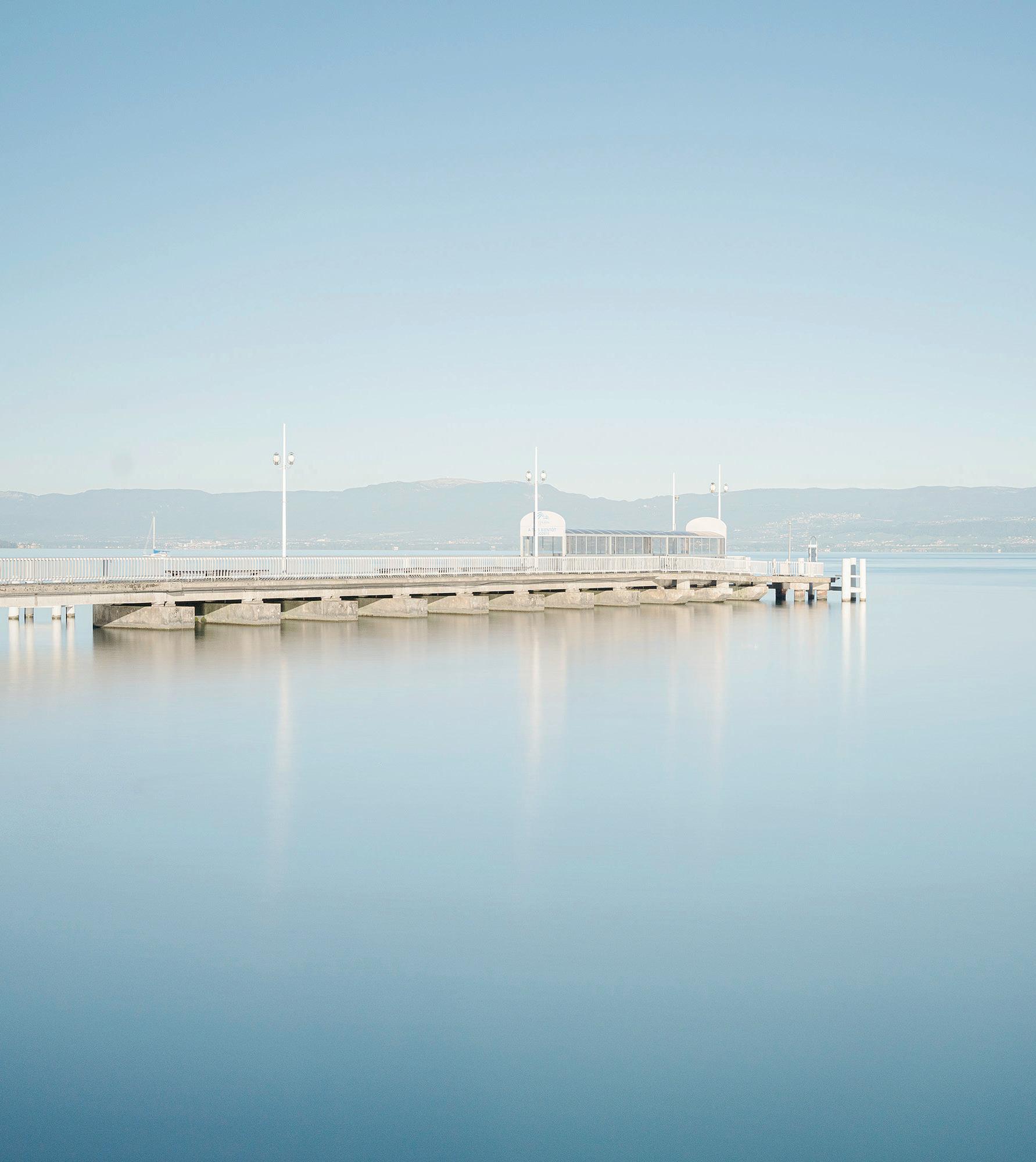
60 À TOUTE VAPEUR / / / FULL STEAM AHEAD / / / MIT VOLLDAMPF VORAUS
© Matthieu Gafsou
Tels des songes posés sur le rivage, les ports sont le point de départ et d’arrivée d’un voyage d’une sublime limpidité. Naviguer sur le lac nous donne une amusante leçon, celle de réinitialiser notre curiosité, histoire de réinventer une nouvelle façon de se déplacer. On croirait même que les heures se déclinent différemment, dénuées de soubresauts. C’est aussi renouer avec la candeur, une séduisante cadence, un peu comme si c’était dimanche tous les jours. Le lac réveille en nous un imaginaire neuf, une envie d’explorer par les eaux veloutées qui ravit les épicuriens avant de débarquer sur la terre ferme et d’entendre le chant de ses habitants qui s’échappe des fenêtres. En descendant du bateau, on touche des yeux une nature préservée, des roseaux, des horizons brossés au gros pinceau, des jaillissements de lumière en contre-jour, des bateaux en partance, tandis que les nettes rousses du Léman tournoient dans les airs. ✵
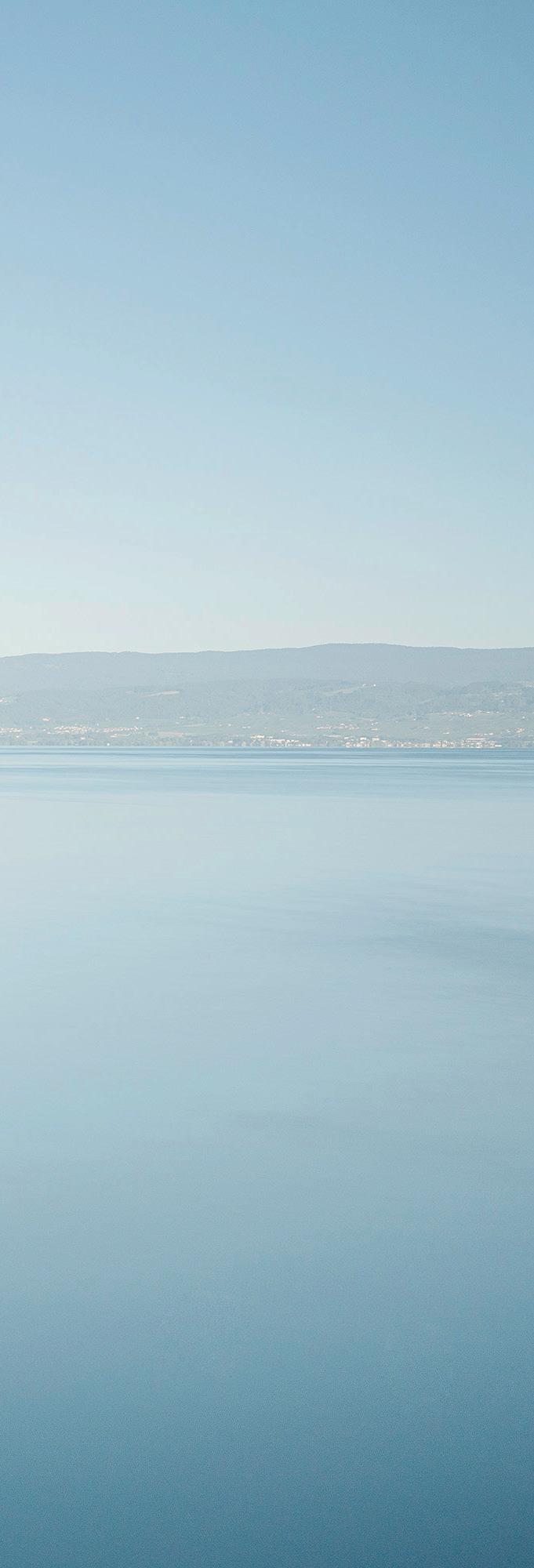
Événement :
Week-end portes ouvertes du chantier naval de la CGN à Ouchy les 15 et 16 avril. Des stands et des ateliers permettront de découvrir les différents corps de métier des acteurs du lac, tels que les pêcheurs, sauveteurs, menuisiers, etc.
Chanson : Une Louise dans chaque port, Michel Bühler (J. V. Gilles / J. V. Gilles)
April
Like dreams dropped on the lake shore, the ports are the points of departure and arrival of a journey offering sublime clarity. Navigating on the lake gives us an amusing lesson, resetting our curiosity in order to reinvent a new means of travel. We even have the feeling that time moves differently, with no sudden movements. It is also a chance to rediscover innocence, an appealing pace as if it were Sunday every day. The lake awakens a new imagination in us, a desire to roam on the silky waters to the delight of epicureans before stepping onto solid ground and hearing the sings of the inhabitants floating through the windows. Getting off the boat, our eyes discover a preserved nature, reeds, horizons painted with a large brush, light springing forth, boats departing as the red crested pochards of Lake Geneva wheel and swoop in the air. ✵
Event:
Open day weekend at the CGN boatyard in Ouchy on 15 and 16 April. Stands and workshops will provide an opportunity to discover the different trades of the people around the lake, such as fishermen, lifeguards, carpenters, etc.
Song:
Une Louise dans chaque port, Michel Bühler (J. V. Gilles / J. V. Gilles)
À TOUTE VAPEUR / / / FULL STEAM AHEAD / / / MIT VOLLDAMPF VORAUS 61
04. DEUTSCHER TEXT Seiten 78 - 88
Avril
Belle Époque

62 À TOUTE VAPEUR / / / FULL STEAM AHEAD / / / MIT VOLLDAMPF VORAUS
© Matthieu Gafsou
La Parade navale de la CGN, c’est un de ces rendez-vous que l’on ne manque pas. Rassemblant sur les flots les fleurons de la flotte Belle Époque – l’édition 2023 réunira le Montreux (1904), le Vevey (1907), l’Italie (1908), La Suisse (1910), le Savoie (1914), le Simplon (1920) ainsi que le Rhône (1927) fraîchement restauré –, elle attire chaque année un public nombreux sur les rives du Léman. Les aficionados se plaisent à admirer les spécificités de chacun de ces navires, comparables à des bijoux : des mythiques figures de proue sculptées dans le bois et entièrement recouvertes de feuilles d’or aux machines à vapeur d’origine en passant par la fine marqueterie lustrée et les boiseries en essences précieuses des intérieurs, chaque détail éveille la sensation de plonger dans un temps passé. En embrassant d’un regard les navires qui transportèrent jadis la haute aristocratie européenne lors de l’avènement du tourisme de luxe en Suisse, on ne peut qu’être sensible à la beauté environnante qui se découpe au travers des fenêtres, rappelant les toiles de Ferdinand Hodler. Mais ce qui rend la flotte Belle Époque aussi émouvante, c’est sans doute la sensation de frôler le galbe de bateaux associant préservation de l’excellence d’un patrimoine et technologie de pointe, qui relie le passé au présent et offre une expérience d’immersion accessible à tous. ✵
Événement :
Parade navale à Morges, le 14 mai 2023. Journée ponctuée d’animations.
Chanson :
Le Vieux Léman, Aliose (E. Rambert / J. Bovet)
May
The CGN naval parade is one of those events you simply don’t want to miss. Bringing together the jewels of the Belle Époque fleet –the 2023 edition will include the Montreux (1904), the Vevey (1907), the Italie (1908), La Suisse (1910), the Savoie (1914), the Simplon (1920) and the newly renovated Rhône (1927) – it attracts numerous visitors to the shores of Lake Geneva every year. Aficionados enjoy admiring the particularities of each of these wonderful boats: from the mythical figureheads sculpted in wood and entirely covered in gold-leaf through the fine polished marquetry and the interior wood panelling made from precious species to the original steam engines, every detail gives you the feeling of plunging into the past. Looking at the vessels which used to carry European aristocracy as they discovered luxury tourism in Switzerland, we cannot help but admire the surrounding beauty through the windows, reminiscent of the paintings of Ferdinand Hodler. But what also makes the Belle Époque fleet so moving is doubtless the feeling of brushing against the contours of the vessels, which combine the excellence of heritage preserved and cutting-edge technology, linking past to present and offering an immersive experience open to all. ✵
Event:
Naval parade in Morges, 14 may 2023. Various activities throughout the day.

Song:
Le Vieux Léman, Aliose (E. Rambert / J. Bovet)
À TOUTE VAPEUR / / / FULL STEAM AHEAD / / / MIT VOLLDAMPF VORAUS 63
05. DEUTSCHER TEXT Seiten 78 - 88
Mai
Faune
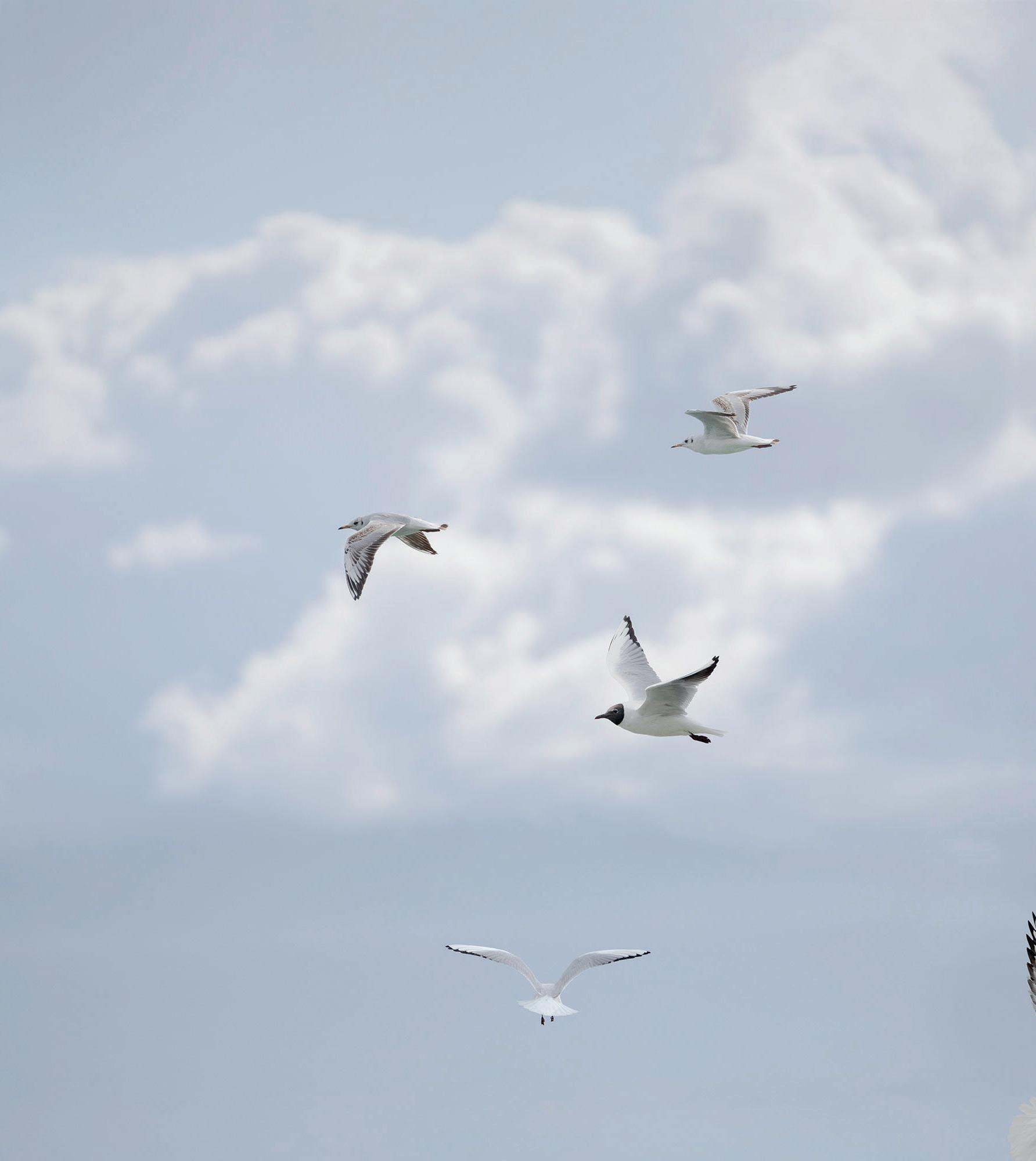
64 À TOUTE VAPEUR / / / FULL STEAM AHEAD / / / MIT VOLLDAMPF VORAUS
© Matthieu Gafsou
Autour du bateau amarré, les teintes se sont diluées et rappellent les volutes provoquées par la pointe d’un pinceau plongée dans un verre d’eau. Si la lumière devenue cotonneuse ne permet plus de distinguer le ciel du lac, on y devine néanmoins un ailleurs bienveillant et intemporel peuplé de rousserolles turdoïdes, de grèbes huppés, de canards colverts et de pêcheurs dans leurs barques, coiffés d’une casquette bleu marine.

Les animaux peuplant les rives du lac Léman sont nombreux. Il y a les canards et les cygnes, les oiseaux migrateurs, bien sûr, mais aussi de nombreux mammifères, comme le castor et le loir. La réserve naturelle des Grangettes, à Villeneuve, est un site humide de grande valeur où la faune peut bénéficier d’un lieu de repos. Une balade sur les sentiers qui sillonnent cette zone naturelle exceptionnelle s’impose, par exemple en la traversant jusqu’au Bouveret, avant de grimper dans un bateau pour revenir à Villeneuve. Afin de maintenir la biodiversité spécifique et rare du lieu, en évitant que la forêt n’envahisse les marais ou que les étangs ne se comblent de végétaux, il est nécessaire de les entretenir. La Fondation des Grangettes s’y emploie afin de permettre la pérennisation de ce patrimoine exceptionnel. Dans cette zone de refuge pour les oiseaux, tout invite à la contemplation ✵
Offre : 30% de rabais les mercredis sur les croisières Riviera Tour (transport uniquement, non cumulable avec d’autres offres).
Chanson : Bec dans l’eau, Milla (J. Kisling / J. Kisling)
June
Around the docked boat, the colours are diluted, recalling the swirls caused by the tip of a brush dipped in a glass of water.While the woolly light makes it impossible to distinguish the sky from the lake, we nevertheless imagine a benevolent and timeless elsewhere populated by great reed warblers, great crested grebes, mallards and fishermen in the boats wearing a navy blue cap. There are numerous animals living along the shores of Lake Geneva. There are ducks and swans, migratory birds of course, and a number of mammals, such as beavers and dormice. Les Grangettes nature reserve in Villeneuve is a valuable wetland site that wildlife can use as a place of rest. A walk along the paths criss-crossing this outstanding natural area is an absolute must, for example walking to Le Bouveret before hopping on a boat to return to Villeneuve. To maintain the specific and rare biodiversity of the site while avoiding the forest invading the marshlands or the ponds filling up with plants, it is necessary to look after them. The Fondation des Grangettes has taken up this task to ensure that this exceptional heritage remains. Everything about this refuge for birds makes it an ideal place of contemplation. ✵
Offer :
30% discount on Wednesdays on Riviera Tour cruises (transport only, not combinable with other offers).
Song:
Bec dans l’eau, Milla (J. Kisling / J. Kisling)
À TOUTE VAPEUR / / / FULL STEAM AHEAD / / / MIT VOLLDAMPF VORAUS 65
06. DEUTSCHER TEXT Seiten 78 - 88
Juin
Juillet
Patrimoine classé à l’Unesco, la région viticole de Lavaux, face au lac Léman, offre quelle que soit la saison une formidable dimension sensorielle. Les superlatifs pleuvent à chaque évocation. Et le meilleur endroit pour contempler ce territoire unique, c’est depuis le lac, confortablement accoudé à la rambarde d’un bateau. Si certains villages séculaires sont nichés dans un repli du terrain, d’autres s’étirent largement sur les coteaux. Ils semblent avoir été déposés çà et là au milieu de la parure verte des vignes en feuilles par une bonne fée. Les géraniums aux pétales vifs illuminent les rebords des fenêtres, les placettes sont séduisantes sous l’ombre des marronniers centenaires. Tout y est ravissant et se prête au fléchissement onctueux. Les terrasses abruptes, fleuron du patrimoine naturel mondial, ont été sculptées par les moines cisterciens établis jadis en l’abbaye de Haut-Crêt, près d’Oron, à la demande de l’évêque de Lausanne au XIIe siècle. La silhouette du vignoble du Dézaley fut forgée grâce à un effort inlassable pendant 200 ans. Largement influencé par le lac, qui modère les écarts de température, le climat ici ne connaît pas de sécheresse excessive durant la saison estivale. Parfois rude en hiver, il alterne entre froid et périodes de dégel. Ces particularités forment l’âme de cette terre exceptionnelle au bonheur grave. ✵
Offre : 30% de rabais (transport uniquement, non cumulable avec d’autres offres) sur les croisières Lavaux Tour.
Chanson :
À Saint-Saph, Michel Bühler et Marc Aymon (M. Aymon / M. Aymon)
July

AUNESCO World Heritage site, the winemaking region of Lavaux overlooking Lake Geneva offers a stunning sensory aspect, whatever the season. The superlatives rain down every time it is mentioned. And the best place to contemplate this unique territory is from the lake, leaning comfortably on the guardrail of a boat. While certain ancient villages nestle in a gentle fold in the land, others stretch out along the hillsides. They appear to have been dropped here and there by a good fairy in the middle of the green vines in full leaf. The brightly coloured geraniums illuminate the window frames, and the little squares under the shade of the hundred-year-old chestnut trees are beautifully seductive. Everything is delightful and is ideal for taking life slow. The steep terraces which are an essential element of the world natural heritage, were sculpted by the Cistercian monks who once lived in the Abbey of Haut-Crêt, near Oron, at the request of the Bishop of Lausanne in the 12th century. The outline of the Dézaley vineyard was forged by tireless efforts lasting some 200 years. Largely influenced by the lake, which moderates the temperature differences, the climate here is not subject to excessive drought during the summer. Sometimes harsh in winter, it alternates between cold and periods of thawing. These particularities form the very soul of this exceptional land that is seriously joyous. ✵
Offer:
30% discount (transport only, cannot be used in conjunction with other offers) on the Lavaux Tour cruises.
Song:
À Saint-Saph, Michel Bühler and Marc Aymon (M. Aymon / M. Aymon)
66 À TOUTE VAPEUR / / / FULL STEAM AHEAD / / / MIT VOLLDAMPF VORAUS
07. DEUTSCHER TEXT Seiten 78 - 88
© Matthieu Gafsou
Patrimoine naturel
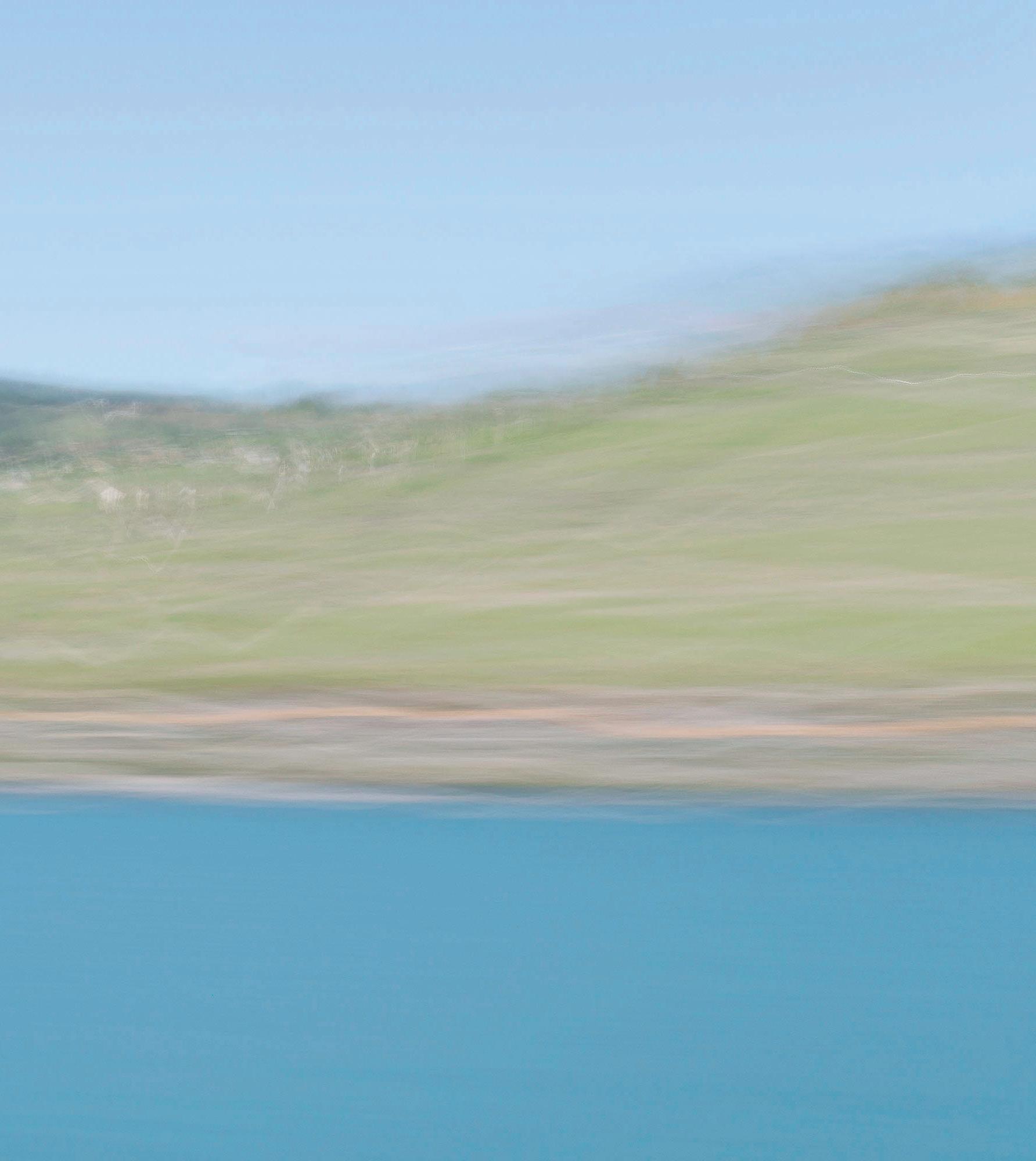
À TOUTE VAPEUR / / / FULL STEAM AHEAD / / / MIT VOLLDAMPF VORAUS 67
Août
Il y en a de grands et de modestes, ceux qui sont ouverts au public et ceux que l’on aperçoit derrière une grille, ceux qui sont aménagés sur l’eau même, donnant à un îlot un air de minuscule forêt vierge, et ceux qui descendent vers elle, couvrant le rivage d’un camaïeu de verts. Lorsque vous croisez près des côtes du Léman, vous portez un regard privilégié sur mille jardins. De Genève, avec le Pré Byron ou la Perle du Lac, à Évian et ses Jardins de l’eau en passant par l’île de la Harpe, au large de Rolle, ils attirent irrésistiblement le regard.
Et puis il y a le jardin des Cinq Sens, situé au cœur de la cité médiévale d’Yvoire, qui nous plonge dans un poème végétal et exquis. D’avril à fin septembre, les 2500 m2 de ce domaine sont un pur enchantement. Une mosaïque de 1500 essences composée d’une prairie alpine faisant écho aux Alpes environnantes, un sous-bois orné de plantes d’ombre, un tissage d’inspiration Renaissance et un cloître en charmille se prêtent volontiers à la méditation. L’intégralité des jardins sont consacrés à la vue, au toucher, au goût et à l’odorat, tandis que l’ouïe est comblée par le murmure de l’eau et les gazouillis des oiseaux.✵
Offre :
30% de rabais les lundis sur la carte journalière CGN.
Chanson : Le Jardin anglais, François Vé (P. Katerine / P. Katerine)
August
They are big and small, open to the public or visible through a fence, some that are on the water, giving an islet the look of a minuscule rainforest, and those that slope down to the water’s edge, covering the shore with shades of green. When you’re on a cruise close to the hillsides overlooking the lake, you enjoy a privileged view of a thousand gardens. From Geneva, with the Pré Byron or the Perle du Lac, via the île de la Harpe opposite Rolle to Évian and its water gardens, they irresistibly draw the eye. And then there is the Jardin des Cinq Sens, located at the heart of the medieval town of Yvoire, which plunges us into an exquisite poem of plants. From April to the end of September, the 2,500 m2 of this park are nothing less than pure enchantment. A mosaic of 1,500 species comprising an Alpine prairie echoing the surrounding Alps, an undergrowth scattered with plants that thrive in the shade, a tapestry inspired by the Renaissance and a cloister are the ideal place to meditate. All the gardens are devoted to the senses of sight, touch, taste and smell, while the ear can enjoy the murmuring of the water and the chirping of the birds. ✵

Offer:
30% discount on Mondays on the CGN day pass.
Song:
Le Jardin anglais, François Vé (P. Katerine / P. Katerine)
68 À TOUTE VAPEUR / / / FULL STEAM AHEAD / / / MIT VOLLDAMPF VORAUS
08. DEUTSCHER TEXT
78 - 88
Seiten
© Matthieu Gafsou
Jardins

À TOUTE VAPEUR / / / FULL STEAM AHEAD / / / MIT VOLLDAMPF VORAUS 69
Innovation
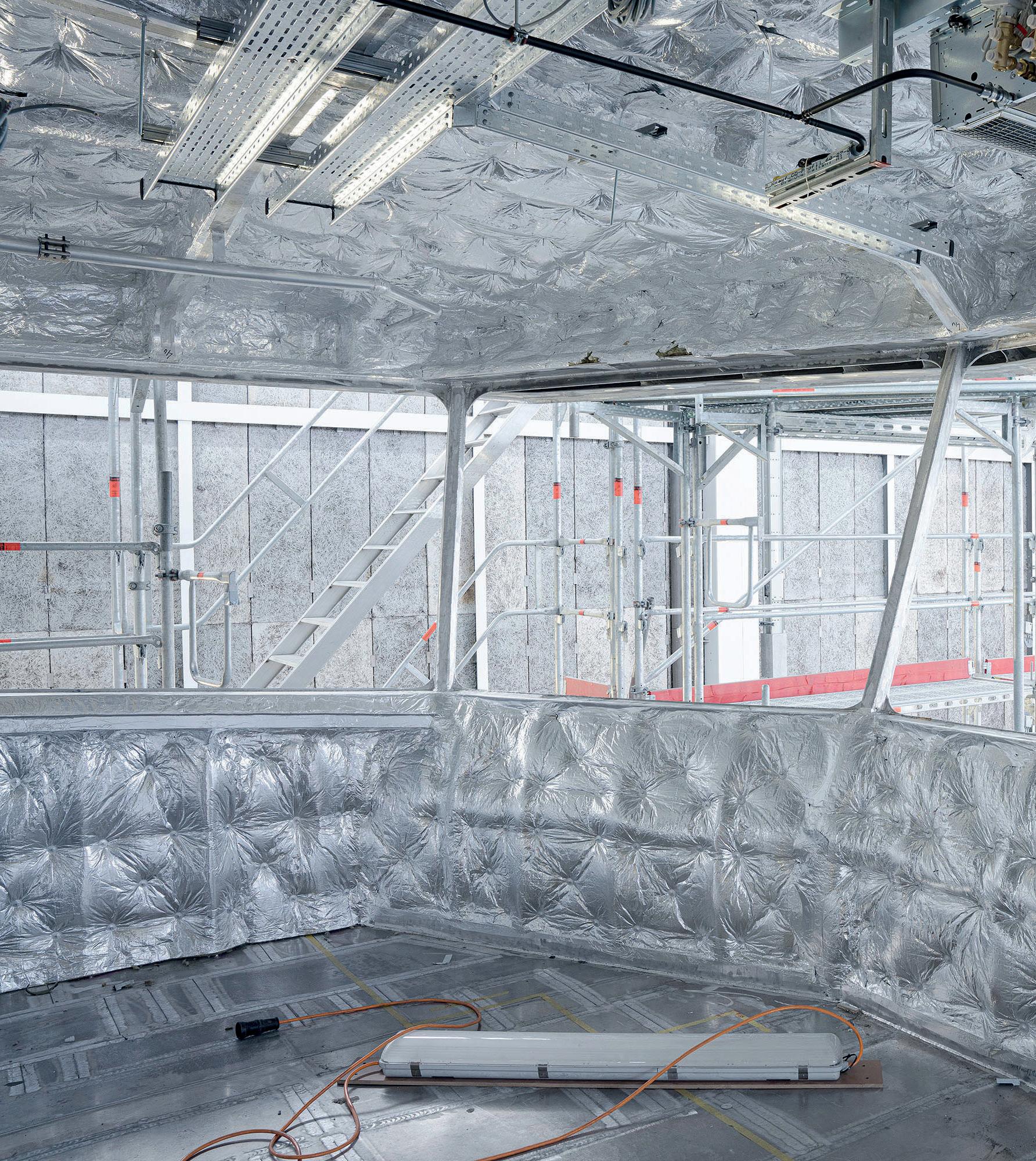
70 À TOUTE VAPEUR / / / FULL STEAM AHEAD / / / MIT VOLLDAMPF VORAUS
© Matthieu Gafsou
Septembre
La CGN s’est donné des défis ambitieux à relever : intégrer au sein de ses priorités l’innovation, le patrimoine et la mobilité, pour poursuivre sa mission en tant qu’acteur de la durabilité dans le bassin lémanique. Baptisé Évian-les-Bains, le premier des bateaux NAVIEXPRESS, navire à technologie hybride destiné au transport public d’une capacité de 600 places assises, est un nouveau fleuron de la flotte de la Compagnie. Performant et durable, il incite les pendulaires à choisir la voie aquatique pour la traversée entre Évian et Ouchy.
Avec sa coque en aluminium et ses hélices innovantes, le NAVIEXPRESS est à la pointe de ce que l’industrie navale est capable de produire. Grâce à l’utilisation de panneaux photovoltaïques sur le toit et à un revêtement fait de matériaux composites extrêmement légers, les trajets en NAVIEXPRESS produiront entre la France et la Suisse 30 fois moins d’émissions de CO 2 que ce ne serait le cas en voiture. L’objectif est d’avoir un standard de transport qui se rapproche de ce que le train sait faire de mieux: confort, stabilité et horaire cadencé. ✵
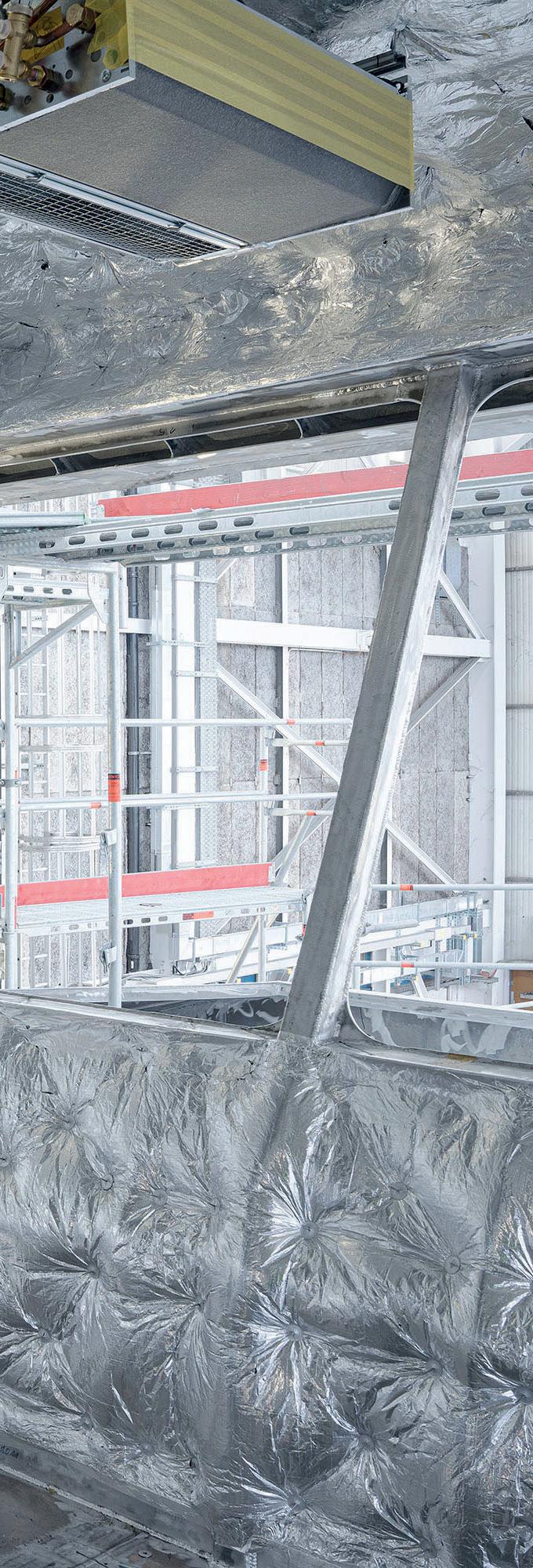
Offre : Croisières découvertes du NAVIEXPRESS
Chanson : Droit devant, Aliose (A. Oswald –X. Michel / E. Franzén –R. Descampe)
September
The CGN has set itself a number of ambitious challenges: to include innovation, heritage and mobility in its priorities in order to pursue its mission as a stakeholder of sustainability in the Lake Geneva basin. Christened «Evian-les-Bains», the first of the hybrid-technology NAVIEXPRESS boats intended for use in public transport has a capacity of 600 seats and is a new flagship of the company’s fleet. Efficient and sustainable, it encourages commuters to choose the water route between Évian and Ouchy. With its aluminium hull and innovative propellers, the NAVIEXPRESS is at the very cutting edge of what the shipbuilding industry is capable of making. By using solar panels on the roof and a coating made of extremely light composite materials, the journeys of the NAVIEXPRESS between France and Switzerland will produce 30 times less CO2 emissions than would be the case by car. The aim is to have a transport standard close to what the train does best: comfort, stability and a regular timetable. ✵
Offer:
NAVIEXPRESS discovery cruises
Song:
Droit devant, Aliose (A. Oswald –X. Michel / E. Franzén –R. Descampe)
À TOUTE VAPEUR / / / FULL STEAM AHEAD / / / MIT VOLLDAMPF VORAUS 71
09. DEUTSCHER TEXT Seiten 78 - 88
Vins

72 À TOUTE VAPEUR / / / FULL STEAM AHEAD / / / MIT VOLLDAMPF VORAUS
© Matthieu Gafsou
Grâce au doux climat qui règne dans la région et au travail de générations de vigneronnes et vignerons soucieux de l’harmonie avec la nature qui les entoure et les nourrit, des cépages de belle allure s’épanouissent. Parmi les terrasses superposées et les murets de pierres de Lavaux, sur les reliefs doux des coteaux genevois ou les pentes verdoyantes de La Côte, la vigne est ici chez elle. Les nuages sont anthracite, bas et gorgés de pluie. Il faut emprunter à pied les petites routes mangées par les feuillages couleur or et les vignes fleuries pour s’immerger dans ce paysage. La chaleur lourde et l’air chargé des effluves poivrées du pétrichor, cette odeur si particulière de la terre après la pluie, rendent le panorama plus intense encore. Comme si, d’un instant à l’autre, tout allait se décoiffer, que le ciel grondant allait se froisser et que les gouttes de pluie n’attendaient qu’un signe pour éclabousser le paysage à grande eau. Le respect de la biodiversité, l’humilité et l’attachement à la terre sont les clés de voûte de l’harmonie de ce coin de pays. Sur les hauteurs du lac, les vigneronnes et vignerons y pensent nuit et jour, car c’est à la vigne que l’on prépare les grandes cuvées. ✵
Offre :
Croisière dégustation à bord des navires de la CGN. Une manière de faire se rencontrer la terre et l’eau, l’esprit des lieux et du corps au cœur de l’immensité du panorama.
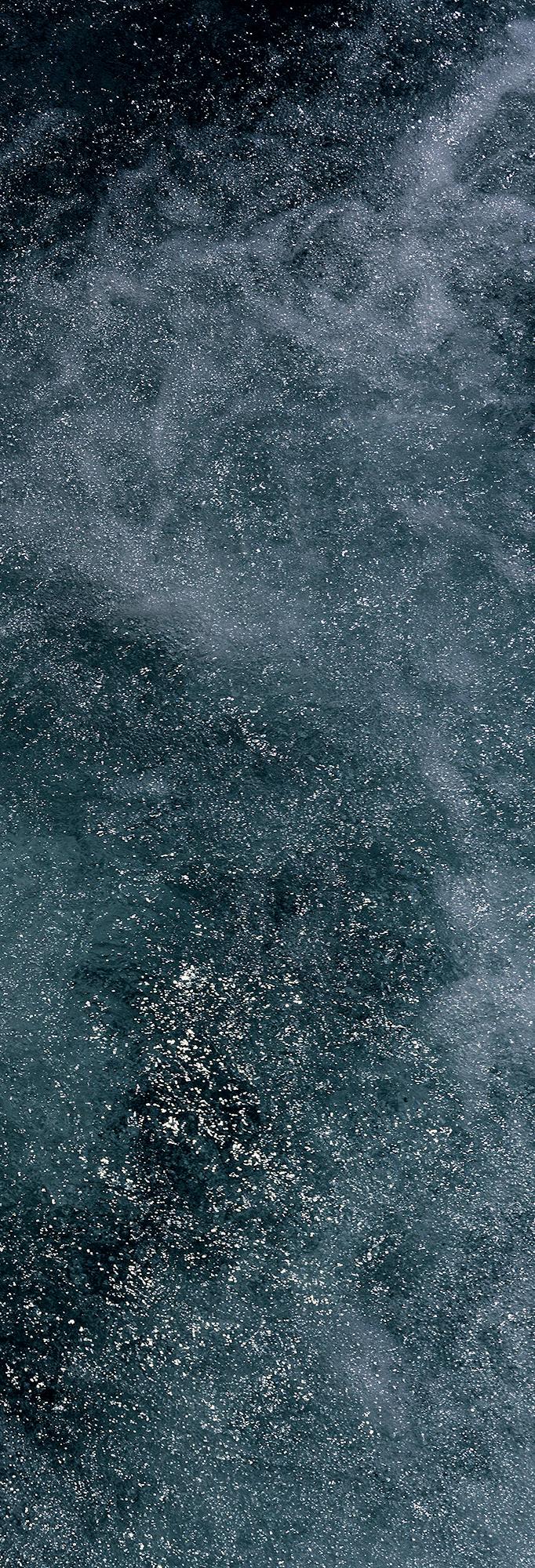
Chanson : Vigne, François Vé (F. Vé / F. Vé)
October
Thanks to the region’s predominantly mild climate and the work of generations of winemakers keen to live in harmony with the nature that surrounds and nourishes them, delicious vintages flourish here. Among the stepped terraces and the stones walls of Lavaux, on the gentle heights of the Geneva hillsides and the lush slopes of La Côte, vines are truly at home here. The clouds are anthracite-coloured, low-lying and full of rain. You have to walk along the little roads, surrounded by golden leaves and flowering vines to really immerse yourself in this countryside. The sultry heat and the air filled with the peppery scents of petrichor, that unique smell rising from the earth after it has rained, make the vista even more intense. As if, from one instant to another, the whole world was going to become tousled, the rumbling sky was going to take umbrage and the raindrops were merely waiting for a sign to stream down over the countryside. Respect for biodiversity, humility and an attachment to the land are the cornerstones of the harmony that exists in this little corner of the country. Above the lake, the winemakers think about it night and day, because the vines produce the great vintages. ✵
Offer :
Tasting cruise on the boats of the CGN. A means of bringing together land and water, the spirit of the region and the body at the heart of this immense panorama.
Song :
Vigne, François Vé (F. Vé / F. Vé)
À TOUTE VAPEUR / / / FULL STEAM AHEAD / / / MIT VOLLDAMPF VORAUS 73
DEUTSCHER TEXT Seiten 78 - 88
Octobre 10.
Novembre
La Compagnie Générale de Navigation, c’est 150 ans de grande histoire et de petites histoires, de technicités uniques, de passion nourrie par les embruns du Léman. C’est aussi le bon esprit de l’intégralité d’une équipe qui s’évertue à faire perdurer l’authenticité et les traditions, la solidarité et l’engagement conduisant à un objectif commun. C’est tout cela qui, mis bout à bout, établit l’identité de la CGN afin d’offrir la meilleure expérience à ses passagers et de transmettre l’art de vivre des voyages au fil de l’eau.
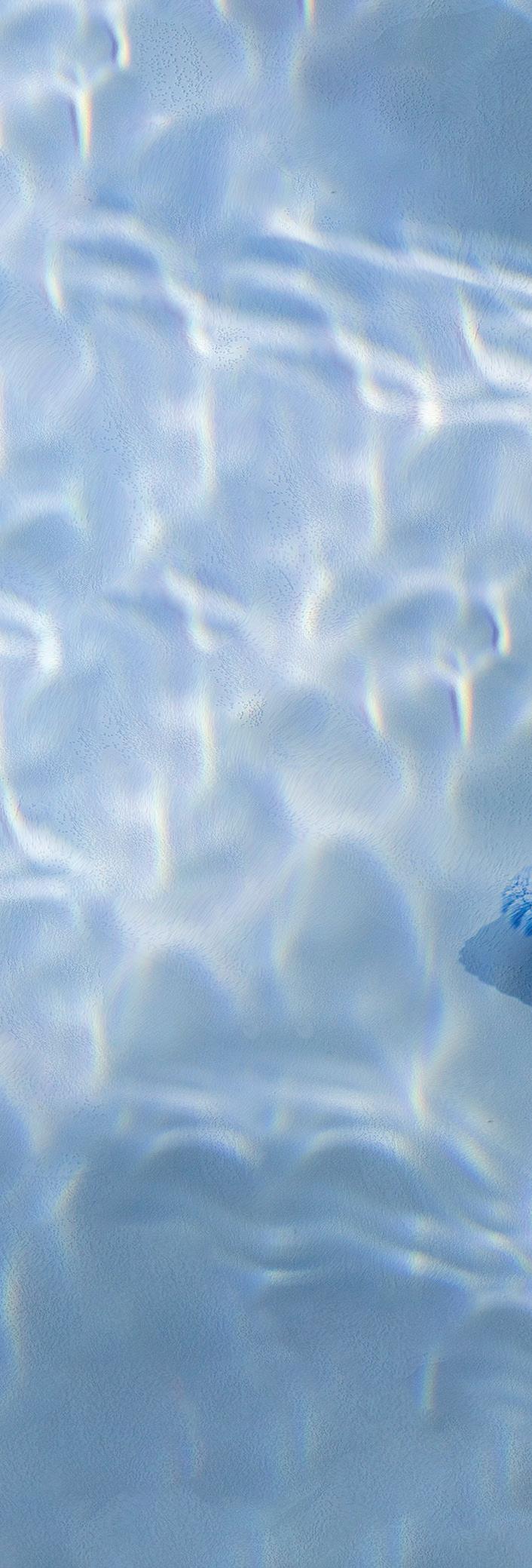
Du capitaine aux matelots, timoniers, peintres, artisans, ébénistes, menuisiers, mécaniciens ou ingénieurs en passant par les métiers de la caisse ou de l’administration, tous partagent le même amour du métier. Un dévouement de puristes qui se ressent sitôt que l’on pose un pied sur le ponton. Une expérience particulièrement émouvante qui permet aussi de s’approcher des femmes et des hommes qui s’évertuent, jour après jour, à perpétuer un patrimoine culturel niché au creux d’une région d’histoire et d’émotions, bercée par les cloches des églises qui résonnent avec une régularité de métronome. ✵
Événement :
Présence de la CGN au Swiss Boat Show, du 11 au 12 novembre 2023, à Palexpo.
Présence au salon des Métiers à Lausanne du 21 au 26 novembre 2023.
Chanson : Gentille Batelière, Jérémie Kisling (auteurs et compositeurs inconnus)
November
The Compagnie Générale de Navigation stands for 150 years of key historical moments and small stories, unique technical feats and passion fed by the spray from Lake Geneva. It is also the good attitude of the entire crew that endeavours to maintain the authenticity and traditions, the solidarity and the commitment leading to a common goal. All of this, placed end-to-end, forms the identity of the CGN in order to offer its passengers the best possible experience and transmit the way of life travelling on the water.
From captain to deckhand, helmsman, painter, craftsman, cabinetmaker, carpenter, mechanic or engineer, not to mention the ticket sellers and administrative staff, everyone shares the same love of the trade. A devotion of purists which can be felt as soon as you step onto the pontoon. A particularly moving experience that brings men and women together who, day after day, make every effort to maintain a cultural heritage nestling in a region full of history and emotions and lulled by the church bells that ring out as regularly as a metronome. ✵
Event:
Presence of the CGN at the Swiss Boat Show, from 11 to 12 November 2023 at Palexpo, in Geneva.
Presence at the Salon des Métiers in Lausanne from 21 to 26 November 2023.
Song:
Gentille Batelière, Jérémie Kisling (auteurs et compositeurs inconnus)
74 À TOUTE VAPEUR / / / FULL STEAM AHEAD / / / MIT VOLLDAMPF VORAUS
11. DEUTSCHER TEXT Seiten 78 - 88 ©
Matthieu Gafsou
Navigants
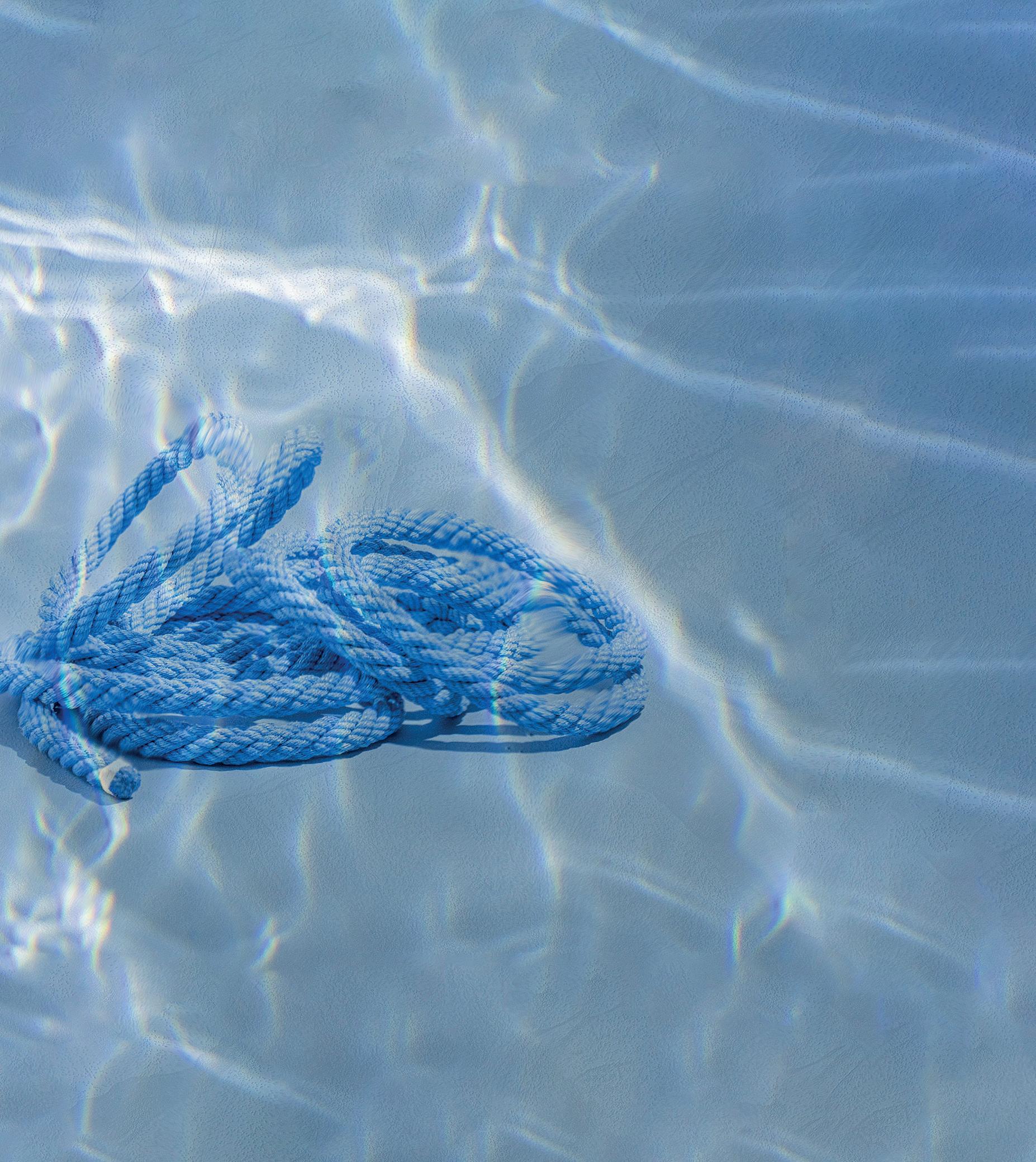
À TOUTE VAPEUR / / / FULL STEAM AHEAD / / / MIT VOLLDAMPF VORAUS 75
Décembre
Dans les premiers jours de décembre, les matinées sont noires et assourdies. Le fond de l’air s’est refroidi sous la brise de façon incisive, c’est comme si l’étendue lacustre s’absentait parfois, jouant à cache-cache avec la brume qui emporte avec elle nos points de repère. On frissonne sous son manteau au moment où le son des cloches semble démultiplié. En attendant que l’on ouvre les volets sur des jours remplis de soleil et que l’on reprenne de l’élan, la CGN s’associera en fin d’année avec des associations caritatives afin de venir en aide aux personnes en situation d’insécurité alimentaire. Une soirée de soutien sera organisée, ainsi qu’une distribution de repas réconfortants à bord d’un bateau. Le projet s’articulera autour de la mise en valeur de la création d’un lien social et d’entraide où entrera beaucoup de prévenance. On fera de la place aux égards des uns envers les autres, dans un moment où l’on s’étourdira de sourires et de pensées douces. Un clin d’œil à la vie, à l’instant et à la paix. Dans l’air encore endormi, on sentira alors l’approche d’un formidable réveil. ✵
Événement : Soirée caritative : informations à venir sur www.cgn.ch/150ans
Chanson : Suis-je bien arrivé ?, Marc Aymon (J. Kisling / M. Aymon)
December
During the first days of December, mornings are dark and muffled. The air has cooled down due to the chilling breeze that cuts you to the bone; it’s sometimes as if the water isn’t event there, playing hide and seek with the mist that hides all familiar landmarks.You shiver under your coat as the sound of the bells seems to multiply. As you wait to open your shutters to be greeted by sunny days and filled with a little more enthusiasm, the CGN will join forces with charitable associations at the end of the year to help those people suffering food insecurity. A support evening will be organised as well as a distribution of warm meals on board one of the boats. The project will focus on the creation of social ties and solidarity involving great thoughtfulness. We will encourage people to respect one another and will be amazed by smiles and kind thoughts. A tip of the hat to life, peace and the hear-and-now. In the sleepy air, we will feel the arrival of a stunning awakening. ✵
Event:
Charity evening: Information coming soon at www.cgn.ch/150ans
Song:
Suis-je bien arrivé ?, Marc Aymon
(J. Kisling / M. Aymon)
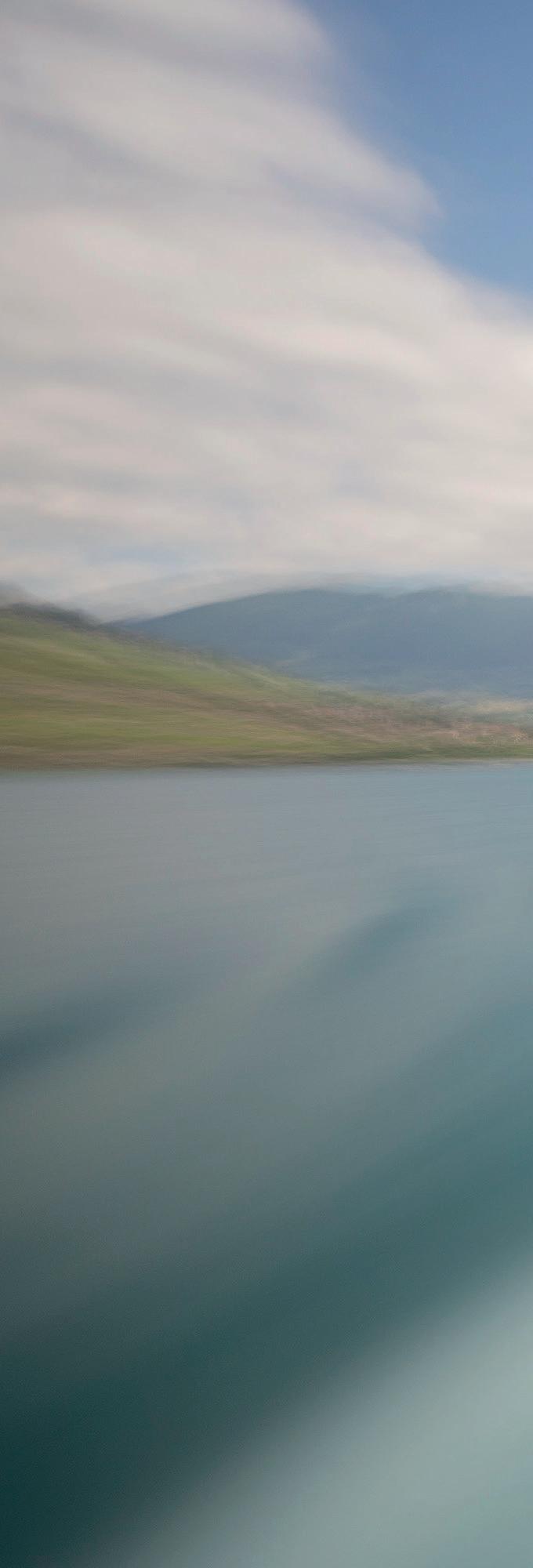
76 À TOUTE VAPEUR / / / FULL STEAM AHEAD / / / MIT VOLLDAMPF VORAUS
12.
DEUTSCHER TEXT Seiten 78 - 88
© Matthieu Gafsou
Solidarité
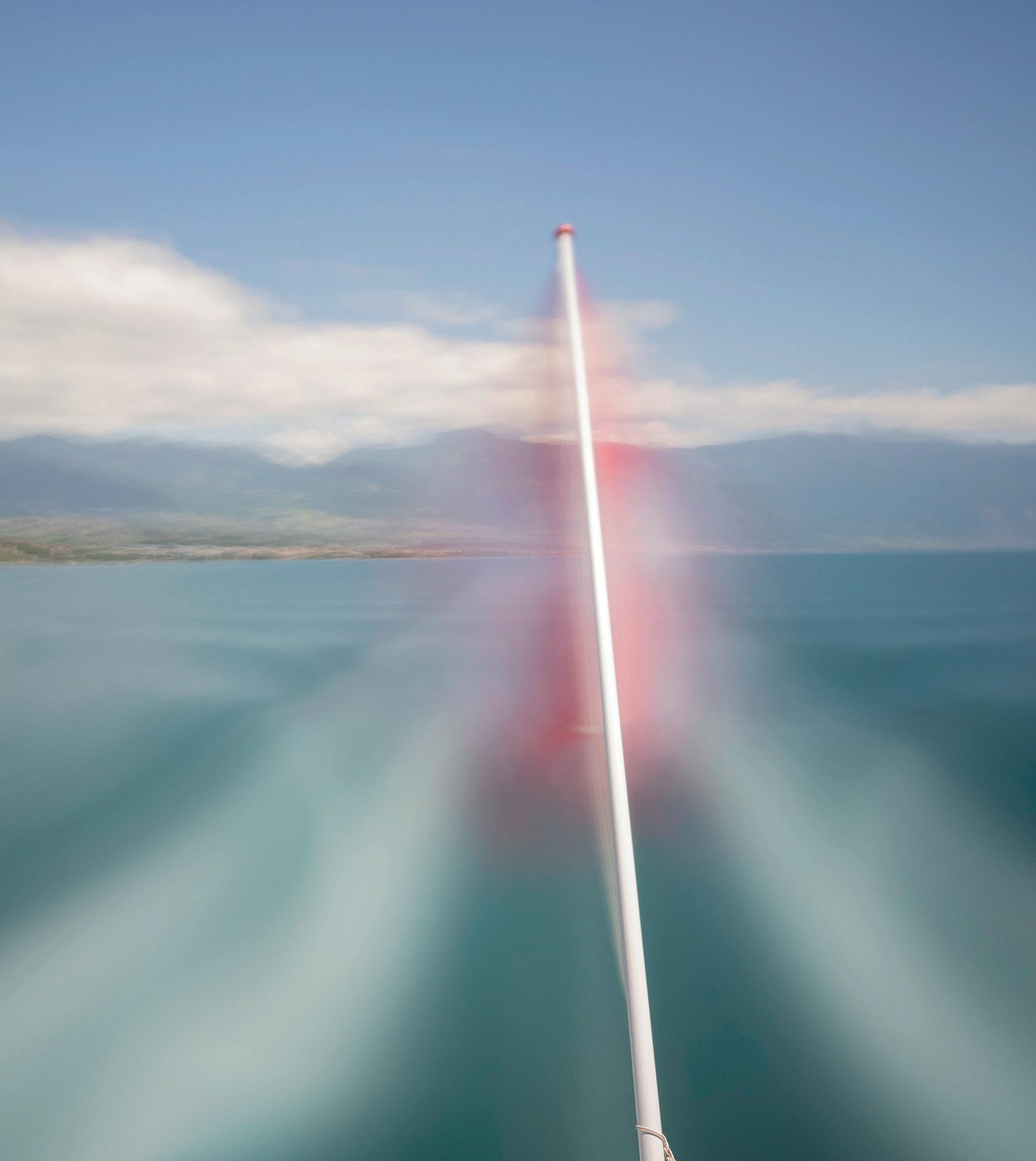
À TOUTE VAPEUR / / / FULL STEAM AHEAD / / / MIT VOLLDAMPF VORAUS 77




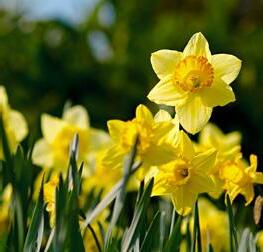





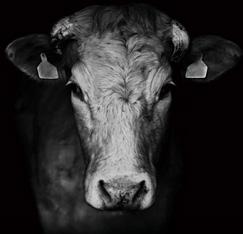











78 À TOUTE VAPEUR / / / FULL STEAM AHEAD / / / MIT VOLLDAMPF VORAUS Chemin des Artisans 7 1263 Crassier Tél : +41 22 367 15 10 www.odelet.ch Rejoignez l’aventure Retrouvez-nous sur terrenature.ch Abonnez-vous recevez chaque jeudi l’hebdo de la vie au vert Terroir – Agriculture – Nature – Jardin – Animaux – Balades – Loisirs WWW.TERRENATURE.CH FORT D’Yverdon Cap-Nord kayak Romandsconciliant défi Rencontre large. Escapade au fil la Singine découverte pont vestiges chapelle Lenousprintemps fait une fleur des beaux les premières jonquilles bientôt suivies Notre où admirer floraisons. OFFRE SPÉCIALE ALIMENTS Rabais de CHF originale Les néophytes, néfastesRuminants surécrangrand un documentaire consacré d’Hérens est premier rôle. WWW.TERRENATURE.CH Les papillons l’ombre lépidoptères d’identifier Des nouvelles et plus durables accueille différents maladies. DE TEMPSREVENU, ANNÉE, CUEILLETTE GÉNÉREUSE. BALADE du bisse hameau permet fraîcheur Parmi Le colza en état de grâce De plus demandé par les consommateurs que de variétés permettent cuisson à haute température, cet en plein essor campagnes. Éclairage l’approche récoltes. CH-2501 132
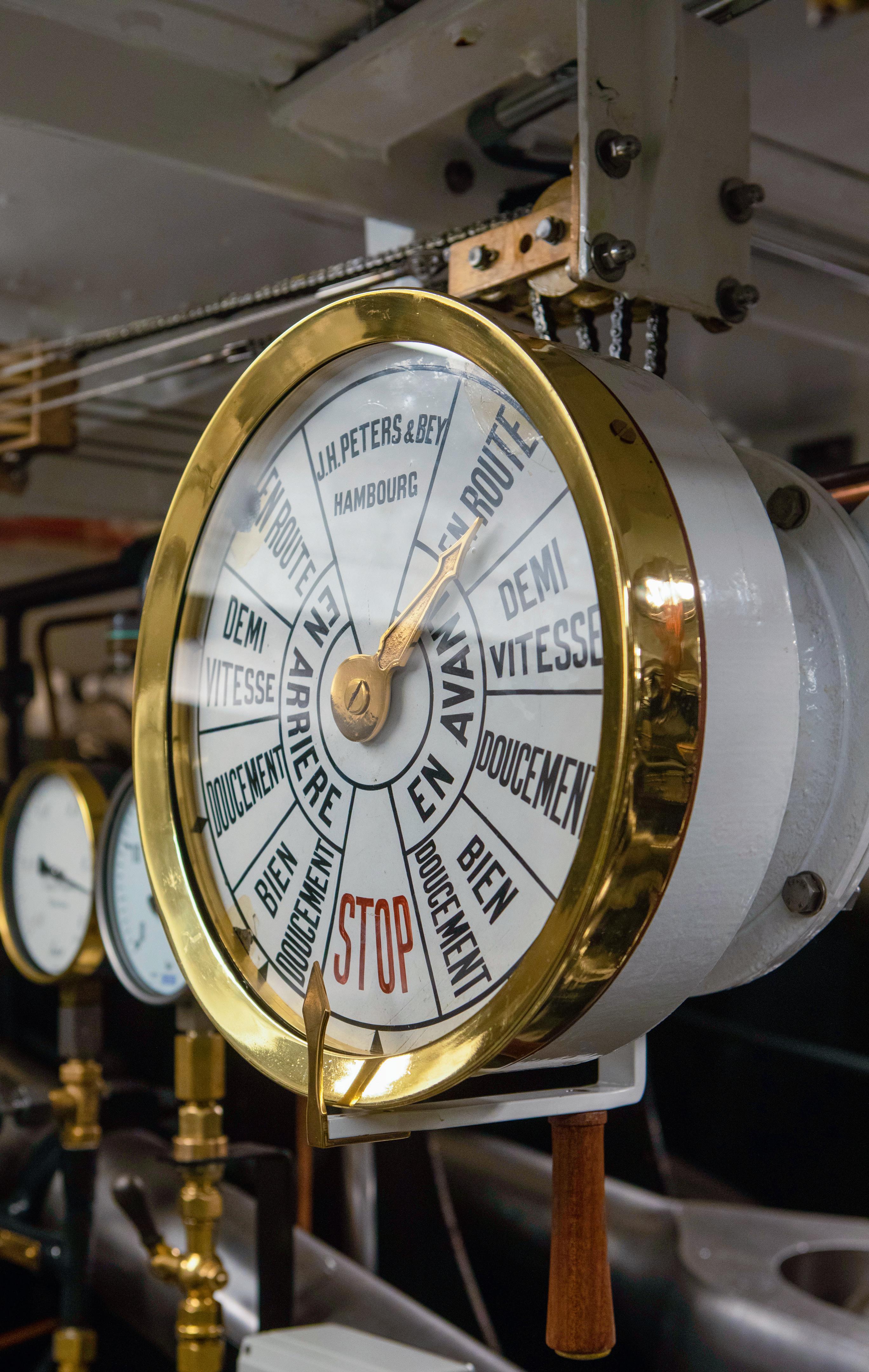
À TOUTE VAPEUR / / / FULL STEAM AHEAD / / / MIT VOLLDAMPF VORAUS 79 © CGN
Lieber Leser, aus Platzgründen konnten wir unser Magazin nicht in voller Länge dreisprachig publizieren. Auf den nächsten Seiten finden Sie einen Auszug der Texte.
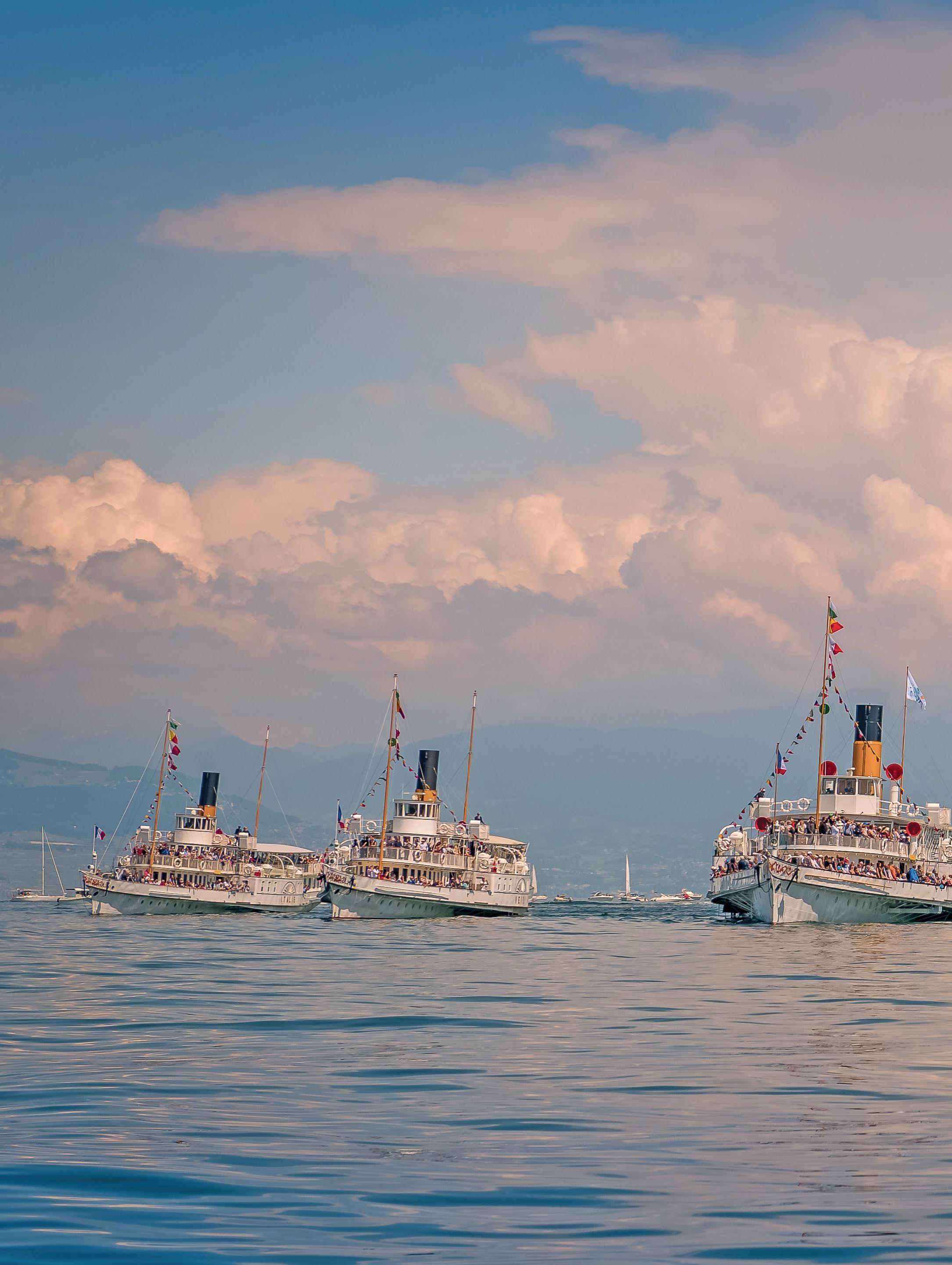
80 À TOUTE VAPEUR / / / FULL STEAM AHEAD / / / MIT VOLLDAMPF VORAUS
© Jacques Straesslé

À TOUTE VAPEUR / / / FULL STEAM AHEAD / / / MIT VOLLDAMPF VORAUS 81 Deutsch
ASSOCIATION DES AMIS DES BATEAUX À VAPEUR DU LÉMAN (ABVL)
HAUPTPARTNER DER CGN FÜR DIE ERHALTUNG DER BELLE ÉPOQUE-FLOTTE SEIT ÜBER 20 JAHREN
Die Association des amis des bateaux à vapeur du Léman (ABVL) wurde im Juni 2002 von einer Gruppe begeisterter Dampferfans ins Leben gerufen, um das Überleben dieser Flotte zu sichern, die aus finanziellen Gründen plötzlich gefährdet war. Der Verein zählt heute rund 20’000 Gönner und etwa 4000 aktive Mitglieder.
Die Hauptaufgabe besteht in der Beschaffung von Finanzmitteln, damit die acht Belle Époque-Schiffe der CGN erhalten bleiben und weiter ihren Liniendienst wahrnehmen können. Dank der von der ABVL seit 20 Jahren gesammelten Spenden konnten die acht Schiffe teilweise oder vollständig instandgesetzt werden. Bis dato hat die ABVL insgesamt nahezu 40 Millionen Franken zusammengetragen. Der Beitrag dieser Vereinigung entspricht rund einem Drittel des Gesamtbetrags, der in die Instandsetzungen dieser Flotte investiert wurde.
VON DER ABVL FINANZIERTE INSTANDSETZUNGEN UND ARBEITEN
D/S Simplon (1920)
Zwei partielle Instandsetzungen zwischen 2003 und 2005 sowie zwischen 2010 und 2011, in deren Rahmen der Rumpf abgestrahlt, die Original-Dampfmaschine generalüberholt, die Salons der 1. und 2. Klasse des Hauptdecks wiederhergestellt und Bugstrahlruder eingebaut wurden. Im Winter 2016-2017 wurden die Rohre der beiden Dampfkessel aus dem Jahre 1966 ausgetauscht. 2021 gewährte die ABVL der CGN eine Finanzgarantie, die ein Sandstrahlen des Rumpfes ausserhalb des Budgets sowie den Austausch der Original-Schaufelradwellen ermöglichte, deren Notwendigkeit sich im Laufe der Arbeiten herauskristallisiert hatte. 2021 finanziert die ABVL den Austausch der Leuchtkörper (Deckenleuchten) des gesamten Schiffes.
Im Winter 2022-2023 finanziert die ABVL die Modernisierung der Bordküchen und Büros.
D/S La Suisse (1910)
Finanzierung von mehr als 80% der gesamten Instandsetzung, mit einem Budget von 15 Millionen Franken zwischen 2007 und 2009. Finanzierung der Rattanstühle des Oberdecks und der neuen Deckenleuchten im Jahr 2021; Auswechslung der Original-Schaufelradwellen im Jahr 2022.
D/S Montreux (1904)
Entwicklung des neuen Dampfmaschinen-Prototyps und partielle Instandsetzung des Salons der 1. Klasse im Winter 2014-2015. 2016 Auswechslung des Überhitzers des Dampfkessels.
Im Winter 2022-2023 finanziert die ABVL den Austausch der Leuchten und ein neues Mobiliar auf dem Oberdeck.
D/S Rhône (1927)
2011 Verschönerung des Salons der 1. Klasse. Ersetzung der Metallverkleidungen der Dampfmaschine, die zum automatischen Schmiersystem gehören und die Sicht verdeckten, durch transparente Plexiglas-Verkleidungen. Von 2019 bis 2021 beteiligt sich die ABVL mit 3 Millionen Franken an der Generalüberholung des Schiffs mit einem Budget von 15’843’000 Franken, die hauptsächlich von den drei Anrainerkantonen des Genfersees aufgebracht werden.
Helvétie (1926)
Erste partielle Instandsetzung 2011-2012 mit Anbringen einer Schutzverkleidung, dem Abstrahlen des Rumpfes und der Schaufelräder sowie einer begrenzten Instandsetzung der Deckaufbauten.
D/S Savoie (1914)
2011 bis 2012 Finanzierung der Überholung der Original-Dampfmaschine und 2021 Austausch der Rattanstühle des Oberdecks.
M/S Vevey (1907)
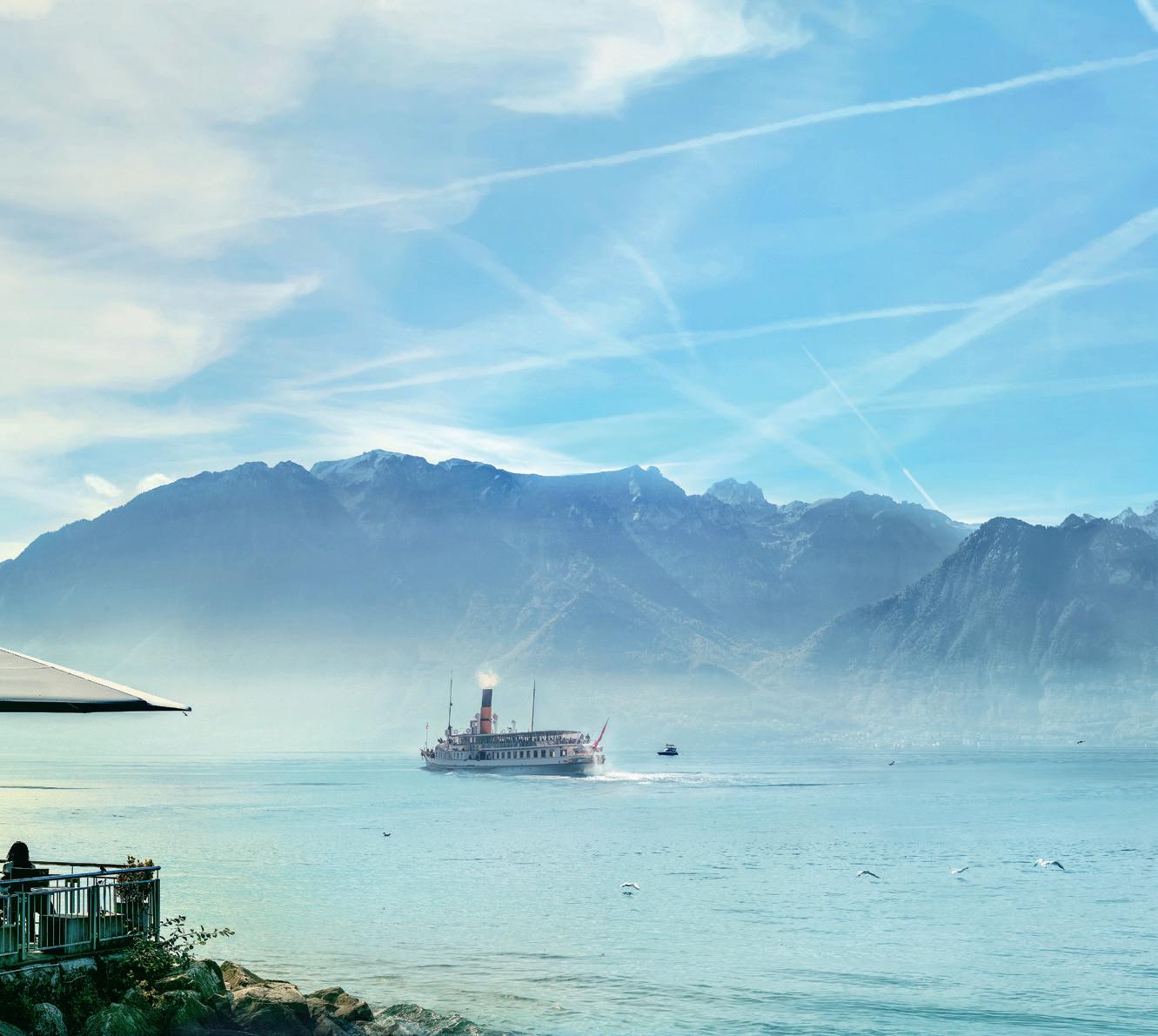
Im Rahmen der Generalüberholung 20122013 Finanzierung der Belle Époque-Leuchten im Salon der 1. Klasse.
M/S Italie (1908)
Von den 13.8 Millionen Franken, die für die zwischen Mai 2015 und Oktober 2016 durchgeführte vollständige Instandsetzung benötigt wurden, stellte die ABVL 9.6 Millionen bereit.
DIE PRO VAPORE-STIFTUNG
2006 gründete die ABVL zusätzlich eine in Genf beheimatete Stiftung, die den gleichen statutarischen Zweck verfolgt wie die ABVL und den Grossteil der gesammelten Spenden verwaltet. Pro Vapore, die als Stiftung von einem Aufsichtsorgan überwacht wird, gewährleistet die ordnungsgemässe Verwaltung der ihr von dem Verein anvertrauten Gelder. Beide Einrichtungen sind im Handelsregister eingetragen.
D/S = Dampfschiff
M/S=Motorschiff (Motorschiff, mit dieselelektrischem Antrieb der Radschiffe)
Scannen Sie den QR-Code, um mehr über die ABVL zu erfahren!
82 À TOUTE VAPEUR / / / FULL STEAM AHEAD / / / MIT VOLLDAMPF VORAUS
TRAGEN SIE ZUR ERHALTUNG EINER WELTWEIT EINZIGARTIGEN FLOTTE BEI!
Die Association des amis des bateaux à vapeur du Léman (ABVL) setzt sich seit mehr als 20 Jahren dafür ein, dass die acht Belle Époque-Schiffe der CGN eines Tages wieder vollzählig über den Genfersee schippern. Auch wenn diese Flotte seit 2011 den Status eines «Denkmals von nationaler Bedeutung» geniesst und damit vor der Verschrottung bewahrt wurde, ist eine umfangreiche finanzielle Investition erforderlich, um sie wieder in den bestmöglichen Betriebszustand zu versetzen. Ein wesentlicher Teil dieser Mittel muss von privater Hand kommen. Von den acht Schiffen der historischen Flotte der CGN sind gegenwärtig sieben fahrtüchtig: La Suisse, die Rhône, die Montreux, die Savoie, die Vevey und die Italie wurden vollständig instandgesetzt. Die Simplon durchlief bereits drei Teilrestaurierungen, wartet jedoch weiter auf eine umfassende Instandsetzung. Aktuell ist nur die Helvétie stillgelegt. Das 2002 ausser Betrieb genommene Schiff benötigt eine vollständige Restaurierung. Unser Verein hat zugesagt, die Vorprojekte zur Instandsetzung der Helvétie und der Simplon zu finanzieren. Wir sind zuversichtlich, dass die Arbeiten in einigen Jahren beginnen
können, voraussichtlich ab 2025-2026. In dieser Hinsicht wollen wir dazu beitragen, dass die vollständig restaurierten acht Belle Époque-Schiffe der CGN bis 2030 wieder auf dem See verkehren. Um dieses ehrgeizige Ziel zu erreichen, brauchen wir Sie!
Jede Spende zählt! Ohne das unermüdliche Engagement der ABVL seit mehr als 20 Jah-
IN DER SCHWEIZ
Die Post – PCK 17-197675-0
IBAN : CH61 0900 0000 1719 7675 0
ren für die Belle Époque-Flotte der CGN wären heute vermutlich nur noch ein oder zwei Schaufelraddampfer im Einsatz, wie die La Suisse und die Savoie
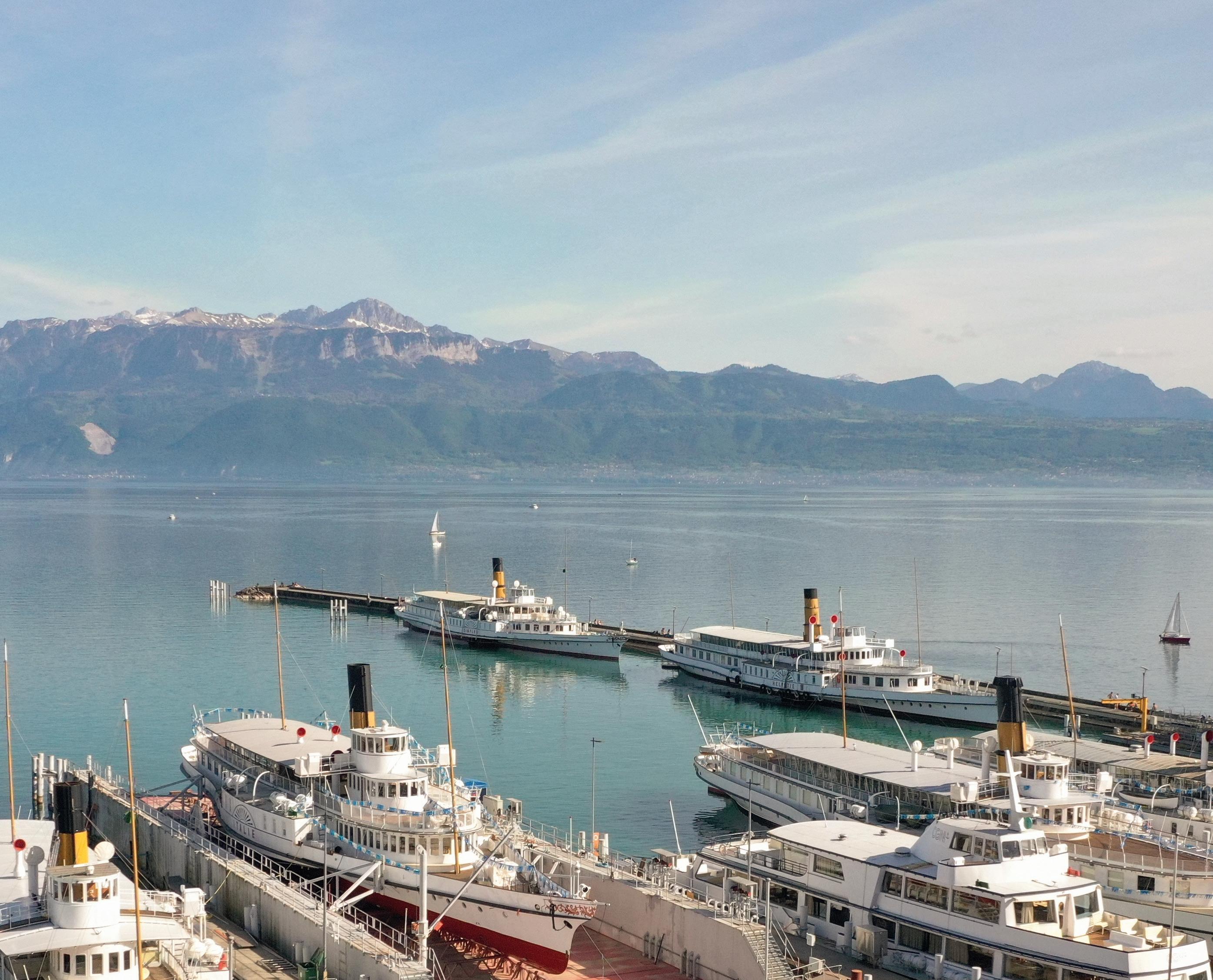
Unterstützen Sie uns mit Ihrer Spende und überweisen Sie :
IN DER SCHWEIZ ODER AUS DEM AUSLAND MITTELS BANKÜBERWEISUNG
In Schweizer Franken: UBS-Konto «ABVL» IBAN : CH 62 0024 3243 4589 5701 H
In Euro: UBS-Konto «ABVL» IBAN : CH 68 0024 3243 4589 5761 K
IN FRANKREICH
La Lyonnaise de Banque (Euro-Konto)
Konto 00032572501
IBAN : FR76 1009 6182 2900 0325 7250 178
– BIC CMCIFRPP
Alle Fragen in Bezug auf Spenden beantworten wir telefonisch unter 021 614 62 88 oder per E-Mail an info@abvl.ch.
À TOUTE VAPEUR / / / FULL STEAM AHEAD / / / MIT VOLLDAMPF VORAUS 83 Deutsch
Die «Simplon» (1920) und die «Helvétie» (1926) sind die letzten beiden Schiffe, die umfassende oder allgemeine Instandsetzungsarbeiten benötigen, damit die gesamte Flotte der acht Belle Époque-Schiffe der CGN endlich wieder vereint ist.
Online-Spenden
Geschichte
1930-1950 Krise (1930er-Jahre, Zweiter Weltkrieg)
1823-1870
Die ersten Dampfschiffe des Genfersees
Die Ära der Dampfschifffahrt auf dem Genfersee beginnt im Jahr 1823. 20 Jahre nach dem Stapellauf der ersten Schiffe mit dieser neuen Technologie sind in Europa bereits mehr als 300 dieser Wasserfahrzeuge unterwegs, davon gut die Hälfte in England. Die am 18. Juni 1823 in Betrieb genommene Guillaume Tell, die für den täglichen Pendelverkehr zwischen Genf und Lausanne ausgelegt ist, kann 200 Passagiere befördern. Während Reisen zumeist noch zu Pferd oder mit der Kutsche über holprige Strassen erfolgen, bietet der Seeweg Reisenden ein angenehmes Beförderungserlebnis. Der Erfolg stellt sich rasant ein, denn schon ab 1824 entsteht eine Werft nach der anderen, und die Beförderungskapazität steigt. Nach der Winkelried und der Léman im Jahre 1826 und der Aigle im Jahre 1836 läutet die «Compagnie de l’Helvétie» 1841 auf dem See die Ära der Riesendampfer mit 1000 Passagieren ein. Im Laufe der Jahre verschärfte sich der Wettbewerb immer weiter – auf dem Wasser durch die Vielzahl der Gesellschaften und zu Lande durch die Entwicklung des Eisenbahnnetzes, das die Beförderung rund um den See schneller und bequemer machte. Um mit dieser Entwicklung Schritt zu halten, schliessen sich im Jahre 1857 drei Gesellschaften unter dem Namen «Communauté Helvétie-Aigle-Léman» zusammen.

1870-1880
Gründung der CGN (1873)
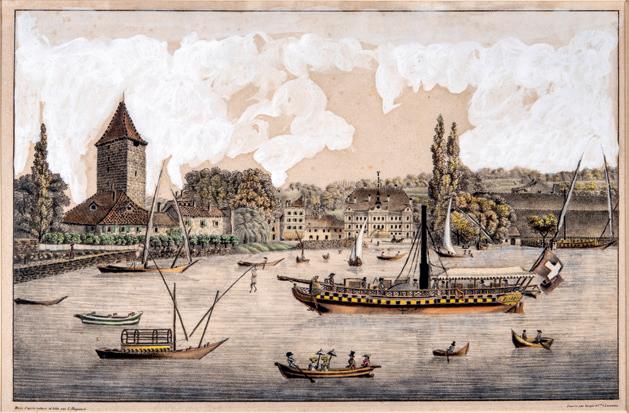
Die aus der Verschmelzung der Compagnie de l’Aigle, der Compagnie de l’Helvétie und der Compagnie du Léman entstandene neue «Compagnie Générale de Navigation sur le lac Léman» – die sich rasch unter ihrem Kürzel CGN einen Namen macht – wird offiziell 1873 aus der Taufe gehoben. Bei der Gründung besteht ihre Flotte aus acht Schiffen, die Winkelried mit ihren zwei grossen, charakteristischen Schornsteinen (1100 Passagiere), die Bonivard und die Helvétie (900 Passagiere), die Léman (800 Passagiere), die Aigle (700 Passagiere), die Chillon (450 Passagiere), die Guillaume Tell (400 Passagiere) und die Rhône (300 Passagiere). Durch einen geschickten strategischen Schachzug baut die CGN ihre Vormachtstellung auf dem Genfersee aus, indem sie alle dort verkehrenden Dampfschiffe aufkauft und die stillgelegten verschrottet bzw. in Pontons umwandelt. So verdrängt sie die rund 20 kleinen Gesellschaften, die sich einen harten Wettbewerb
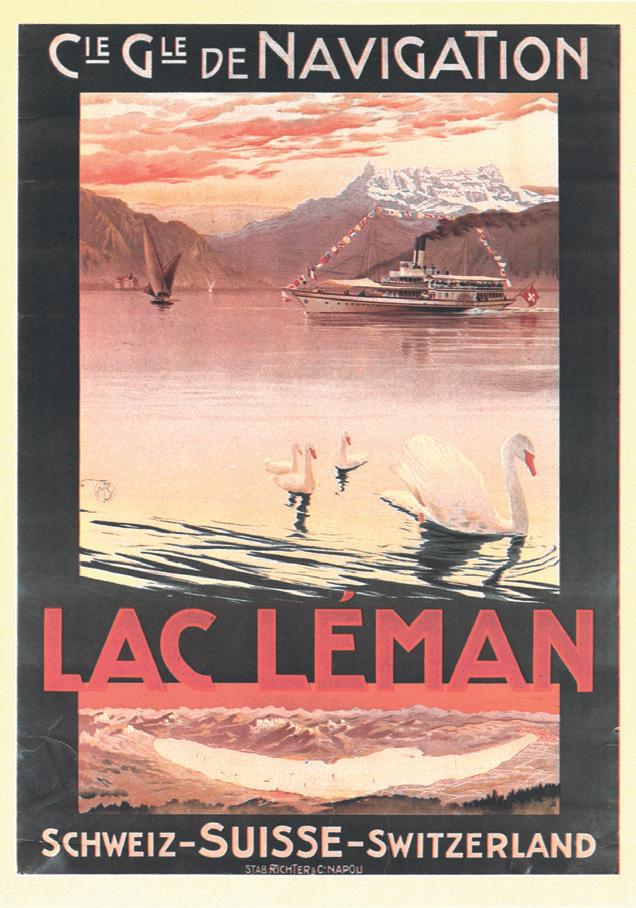
lieferten, häufig nur ein einziges Schiff besassen und zumeist am Rande der Insolvenz standen. Abgesehen von Kurzstrecken und Fracht behauptet sie ihr Monopol in der gewerblichen Schifffahrt bis heute.
1880-1930
Luxus auf dem Wasser (erste Salonschiffe)

Die Vollendung des regionalen Schienennetzes und die rasante Entwicklung des Tourismus stellen die CGN vor neue Herausforderungen. Um wettbewerbsfähig zu bleiben, beschliesst die Gesellschaft, die Attraktivität ihrer Leistungen zu erhöhen und Komfort, Platzangebot, Zuverlässigkeit und Regelmäs-
Obwohl in den 1920er-Jahren kurz Interesse an einem Neuanfang bestand und Hoffnung auf eine neue Belle Époque aufkam, verdunkelt sich nach und nach der Himmel für die Binnenschifffahrt. Die Folgen der Wirtschaftskrise, die 1929 mit dem Crash an der Wall Street beginnt, machen sich im Jahr danach auch in der Schweiz bemerkbar und halten praktisch bis zum Ende des Zweiten Weltkriegs an. Hinzu kommt ein neuer Konkurrent: das Auto. Zum ersten Mal in ihrer langen Geschichte sieht sich die CGN gezwungen, einen Sparplan umzusetzen, zumal ihre Flotte fortan nicht für die Zahl der Fahrgäste ausgelegt ist, die sie befördern will. Das defizitäre Frachtgeschäft wird 1931 eingestellt. Auch die Kosten für Antrieb, Brennstoff und Personal müssen gesenkt werden. So werden zwei Schiffe von einem Dampfantrieb auf ein dieselelektrisches System für Schaufelräder umgestellt – eine Weltpremiere. Mit dem
sigkeit ihrer Schiffe drastisch zu verbessern. Zwischen 1874 und 1885 finanziert sie mit eigenen Mitteln die ersten Salonschiffe mit zwei Decks, die als Vorläufer der Belle Époque-Schiffe gelten. Von 1896 bis zum Ausbruch des Ersten Weltkriegs laufen zehn grosse Salonschiffe vom Stapel, d.h. durchschnittlich ein Luxusdampfschiff alle zwei Jahre. So verkehrt fortan eine der grössten europäischen Schaufelraddampferflotten –zweifelsohne die homogenste – auf dem Genfersee. Die Geschäfte florieren. 1913 legen die Schiffe der Gesellschaft 625’000 km zurück und befördern mehr als 2 Millionen Passagiere – eine Zahl, die erst wieder 2012 und damit fast ein Jahrhundert später erreicht wird! Diese glorreiche Zeit sollte durch den Ausbruch des Ersten Weltkrieges, der die Finanzen der CGN in eine grosse Schieflage bringt, jäh unterbrochen werden.
Ausbruch des Zweiten Weltkrieges verschlimmert sich die Lage dramatisch. Die angeschlagene Gesellschaft wird mit voller Wucht erwischt. Der einstige Börsenliebling vor dem Ersten Weltkrieg ist im Frühling 1940 insolvent und muss um die Unterstützung der öffentlichen Hand ersuchen.
1950-1965
Schweizerische Landesausstellung
In den 1950er-Jahren werden sämtliche Belle Époque-Schiffe wieder in Dienst gestellt. 1963 und 1964 erwirbt die von der öffentlichen Hand unterstützte CGN zwei Motorschiffe und Zwillingsschrauben – die Henry-Dunant und die Général-Guisan. Zu diesem Zeitpunkt tritt auch ein imposantes Gleitboot, die Albatros, in Erscheinung, die 80 Passagiere mit der atemberaubenden Geschwindigkeit von mehr als 60 km/h befördern kann. Im Rahmen von Umgestaltungen, die für die im selben Jahr stattfindende Landesausstellung geplant sind, errichtet die Ge-
84 À TOUTE VAPEUR / / / FULL STEAM AHEAD / / / MIT VOLLDAMPF VORAUS
sellschaft in Ouchy-Bellerive eine neue Werft. Erstmals seit 1913 weist sie wieder einen Gewinn aus und kann ihren Aktionären eine Dividende ausschütten. Folglich gelingt es der CGN an der Schwelle zu einem Wirtschaftsboom, einen Teil ihrer Schiffe zu modernisieren. Fortan umfasst die Flotte sieben Dampfschiffe (La Suisse, Simplon, Helvétie, Général Dufour, Savoie, Rhône, Major Davel), fünf Schaufelradschiffe mit dieselelektrischem
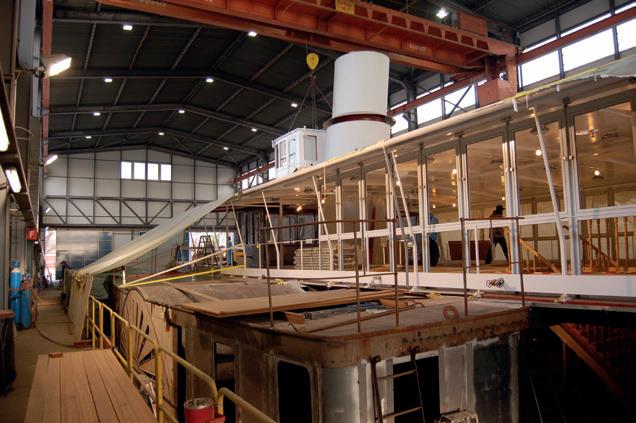
Antrieb (Vevey, Italie, Montreux, Genève, Lausanne), sechs Schrauben-Motorschiffe (die beiden neuen Schiffe Henry-Dunant und Général-Guisan, den Veteran Léman, die drei kleineren Schiffe Col-Vert, Grèbe und Bécassine), sowie das Gleitboot Albatros. Eine Flotte, die sich sehen lassen kann.

1965-1990
Die ersten Pendler
In den 1960er-Jahren läuten die Totenglocken für die Kohlenfeuerung: Einige noch betriebsbereite Schiffe wie die Général Dufour und die Major Davel werden stillgelegt und müssen neuen, innovativeren Schiffen Platz machen. Weil das Geld fehlt und Schweröl billig ist, muss die CGN gleichwohl darauf verzichten, ihre grössten Schaufelraddampfer zu motorisieren. Ende der 1970er-Jahre erwirbt die Gesellschaft zwei neue Schiffe mit Schraubenantrieb, die Chablais III (1974) und die Ville-de-Genève (1978). Die Zeit kommt ihr dabei zu Hilfe, denn die 1980er-Jahre sind geprägt von günstigen Witterungsbedingungen und einer florierenden Wirtschaft. Der Grenzverkehr zwischen Ouchy und Évian steigt stetig an und erfordert den Einsatz zweier Schiffe in den Stoss-
zeiten. Entsprechend gelingt es der Gesellschaft in ihrer Geschichte erneut, ausgeglichene Finanzen zu erreichen. Um mit der stets zunehmenden Passagierzahl Schritt zu halten, erwirbt sie ein geräumiges Pendlerschiff, die Léman V mit einer grossen Zahl an witterungsgeschützten Innen-Sitzplätzen. Es folgt ein echter Gigant, die Lausanne II mit einer Beförderungskapazität von 1500 Passagieren.
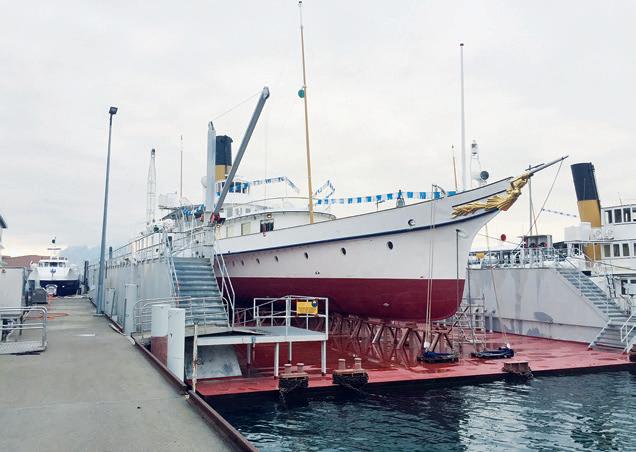
1990-2002
Goldene Schiffe
Trotz zahlreicher Instandsetzungen und Umbauten sowie eines praktisch pausenlosen Einsatzes seit ihrem Stapellauf zeigen die bald 100 Jahre alten acht Schiffe der Belle Époque-Flotte unübersehbare Verschleisserscheinungen. Glücklicherweise wird sich die Öffentlichkeit nach und nach des unschätz-
Instandsetzung der La Suisse 12 Millionen Franken zur Verfügung, während sich die Gesamtkosten für die Instandsetzung auf 15 Millionen Franken belaufen. Die CGN gibt ihre Ziele für 2010 bekannt: Neben der Entwicklung ihrer Leistungen im öffentlichen Verkehr und der Einführung von Spitzentechnologie verpflichtet sie sich, sich dank eines aussergewöhnlichen Fachwissens für die Erhaltung ihres Belle Époque-Erbes einzusetzen. Der Finanzbedarf lässt auch künftig nicht nach. Gleiches gilt für den Erfolg der von der ABVL durchgeführten Kampagnen. Nach einigen Jahren der Stilllegung werden die Italie und die Vevey vollständig instandgesetzt.
2011-2018
Restrukturierung und die Belle Époque-Flotte wird unter Denkmalschutz gestellt
baren Werts der Schiffe bewusst. So werden politische Schritte eingeleitet, um die Schiffe als historische Denkmäler einzustufen. Die CGN, die um den einzigartigen Reiz des Dampfantriebs weiss, kündigt an, ihre vier Schaufelraddampfer mit dieselelektrischem Antrieb wieder mit Dampf zu betreiben. Hierzu sollen die Schiffe so umgebaut werden, dass kein Mechaniker permanent im Maschinenraum erforderlich ist. Ausserdem wird der Wirkungsgrad der Maschinen durch einen thermodynamischen Zyklus mit Hochdruck und Hochtemperatur gesteigert – eine weitere Weltpremiere. Aufgrund fehlender Finanzmittel kann die CGN diese gewagte Instandsetzung jedoch nur für die Montreux durchführen. Darauf schliessen sich einige Liebhaber der historischen Flotte zusammen und gründen 2002 die Association des amis des bateaux à vapeur du Léman (ABVL). Die Spenden der Mitglieder verstehen sich als wertvolle Unterstützung für eine Gesellschaft, die in eine finanzielle Schieflage geraten ist, und sichern die Erhaltung der verbleibenden Belle Époque-Schiffe.
2002-2011
Die grossen Herausforderungen und Erfolge
Da immer mehr Schiffe gebaut werden, sind auch immer mehr Gelder erforderlich. 2003 lanciert die ABVL ihre erste Kampagne mit dem Slogan «Ensemble, redonnons à La Suisse sa silhouette d’origine». Es folgt die Aktion «Sauvons le Simplon», mit der das Schiff nach einer Dieselgasexplosion in den Rauchrohren einer ihrer beiden Kessel wieder flottgemacht werden soll. Das Ergebnis übertrifft alle Erwartungen: Dank kollektiver Bemühungen wird das Schiff gerettet. Aufgrund zahlreicher Privatspenden stellt die Vereinigung der Gesellschaft anschliessend für die

Die finanzielle Unterstützung für die CGN und die Belle Époque-Flotte nimmt zu. Nach dem Kanton Waadt Ende 2010 sind nunmehr die Staatsräte der Kantone Genf und Wallis aufgerufen, ihren jeweiligen Grossen Räten die Investitionskredite zur Unterstützung der CGN vorzulegen. Der Gesamtbetrag beläuft sich auf 24,8 Millionen Franken. Davon entfallen je nach Länge der Uferseite der einzelnen Kantone 67% auf den Kanton Waadt, 26% auf den Kanton Genf und 7% auf den Kanton Wallis. Die Kredite setzen die Umwandlung der CGN in eine Holdinggesellschaft, die Groupe CGN SA, mit zwei Tochtergesellschaften voraus, an denen die CGN sämtliche Anteile hält: CGN SA ist Eigentümerin der modernen Schiffe und des Immobilienbestands der Gesellschaft und für deren operative Verwaltung, einschliesslich der Humanressourcen, zuständig. Dagegen ist CGN Belle Époque SA, eine Aktiengesellschaft ohne Erwerbszweck, Eigentümerin der acht gleichnamigen Schiffe der Flotte. Fortan besitzen die drei Kantone die Mehrheit am Aktienkapital der Gruppe und spielen eine tragende Rolle in ihrem Verwaltungsrat. Die Annahme dieser Massnahmen, die für die Zukunft der CGN entscheidend sind, liegt in den Händen der privaten Mehrheit unter ihren Aktionären, darunter auch die ABVL. Das geschieht im Mai 2012. Bereits 2011 wurden die acht Schiffe der Belle Époque-Flotte unter Denkmalschutz gestellt. Eine Entscheidung, die die unablässigen Bemühungen der ABVL krönte.
2018-2023 Mobilität auf dem See
Im August 2018 unterzeichnen die Behörden des Kantons Waadt und Frankreichs einen Vertrag über eine Zusammenarbeit zwischen beiden Seeseiten, während der Pendelverkehr auf dem Genfersee weiter ansteigt. Im
À TOUTE VAPEUR / / / FULL STEAM AHEAD / / / MIT VOLLDAMPF VORAUS 85 Deutsch
Zuge der wachsenden Bedeutung des Umweltschutzes wird die Beförderung auf dem See zu einer unverzichtbaren öffentlichen Alternative zum Individualverkehr mit dem Pkw, der die Grenzregion verstopft. Nach einer internationalen öffentlichen Ausschreibung wird für Sommer 2023 ein erster NAVIEXPRESS in Auftrag gegeben, der einem steigenden Bedarf an nachhaltigkeitskonformer Mobilität gerecht wird. Dieses erste Hybridschiff auf dem Genfersee soll Fahrten für Passagiere – wie beim schweizerischen Eisenbahnsystem – komfortabler machen. Um den ökologischen Fussabdruck der Beförderung auf dem See zu verringern, ist es mit 150 m2 an Solarpaneelen und einer treibstoffsparenden Rumpfform aus Metall ausgestattet. Schlussendlich will die CGN, die stets gewillt ist, sich den Herausforderungen ihrer Zeit zu stellen, emissionsfreie Schiffe bauen, sobald die entsprechende Technologie vorhanden ist.
Kultur
Aushängeschilder des Sees
Eine historische Flotte das ganze Jahr über wetterunabhängig zu betreiben ist nicht nur ein technisches Kunststück. Vielmehr geht es auch darum, diese Schiffe im kollektiven Gedächtnis zu verankern. Die hervorstechenden weissen Umrisse der Belle Époque-Schiffe sind heute aus dem Panorama am Genfersee nicht mehr wegzudenken. Inzwischen sind die Schiffe Wahrzeichen wie die Alpengipfel, lokale Denkmäler oder der Jet d’eau in Genf. Ausserdem sind sie auf Gemälden und Illustrationen verewigt, dienen als Hintergrund von Postkarten, Plakaten und Erinnerungsfotos und kommen bisweilen sogar zu filmischen Ehren. So wurde das russische Melodram Sonnenstich, das während des Roten Terrors im russischen Reich spielt, im Oktober 2012 unter anderem an der Anlegestelle Bouveret gedreht. Die Handlung spielt grösstenteils an Bord der vorübergehend zu einem Flussdampfer umgebauten Rhône sowie an Bord der La Suisse und der Montreux Zehn Jahre nach Gründung der ABVL wurden der Verein und die CGN für die vorbildliche Erhaltung der Belle Époque-Flotte mit dem Preis der Europäischen Union für das Kulturerbe (Europa Nostra-Wettbewerb) ausgezeichnet. Diese echten Wahrzeichen des Sees und stolzen Zeugen der Vergangenheit haben bis heute nichts von ihrer Faszination verloren.
Von 1873-2023: 150 Jahre
Schifffahrt auf dem Genfersee
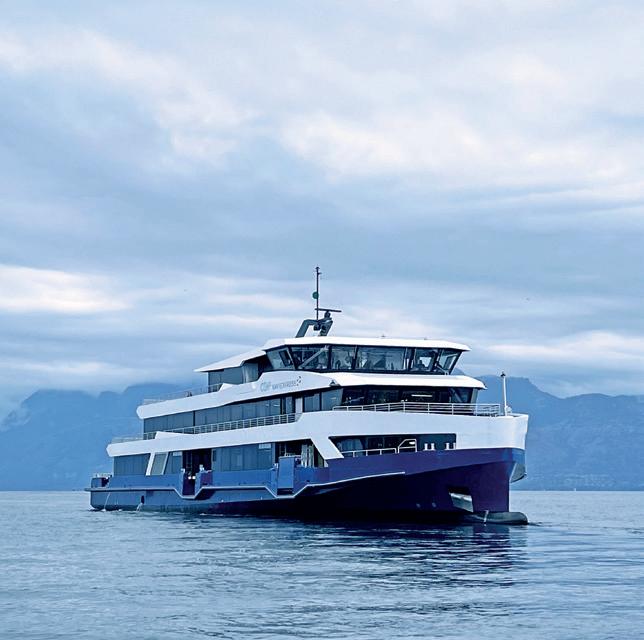
Anlässlich ihres 150-jährigen Bestehens wird die Compagnie générale de navigation (CGN) alle Beteiligten ehren. Dies schliesst all jene ein, die seit 1873 zu ihrer Entwicklung beigetragen haben, aber auch die vielen Mitarbeitenden, die tagtäglich auf dem wunderschönen Genfersee im Einsatz sind. Die am 16. Januar 2023 begonnenen Feierlichkeiten werden das ganze Jahr über mit einem bunten Programm fortgesetzt.
Von Januar bis Dezember 2023 stehen zwölf Themen im Mittelpunkt, die Monat für Monat bei Veranstaltungen, Wettbewerben und attraktiven Angeboten für bestimmte Ausflugsfahrten, darunter die Lavaux Tour-Fahrten, die Tageskarten und die Entdeckungsfahrten mit der NAVIEXPRESS, zum Ausdruck kommen. Beim Tag der offenen Tür in der Werft Ouchy, der am 15. und 16. April 2023 stattfinden soll, wird die CGN ein «Seedorf» einrichten, in dem mehrere Akteure des Genfersees wie die Association des amis des bateaux à vapeur du Léman (ABVL) oder die Société Internationale de Sauvetage du Léman Besucher begrüssen werden. Am 14. Mai und damit im Vorfeld der warmen Jahreszeit wird in Morges die berühmte Parade-Navale für grosse und kleine Schiffsfans über die Bühne gehen. Gleichzeitig werden Wunder der Technik, das Know-how vergangener Zeiten, die Belle Époque-Schiffe als einmalige Zeitzeugen und ihre Fahrgäste auf originelle Weise ins Rampenlicht gerückt. Und in puncto Gastronomie gibt es in den Herbstmonaten regionale Weine zu entdecken.
Vielseitiges Kunstprojekt
Die 150-Jahr-Feier wird auch musikalisch untermalt werden. So wird das Musicalprojekt «Ici le lac ressemble à la mer» des Schweizer Liedermachers Marc Aymon für den musikalischen Rahmen sorgen. Der aus Icogne im Wallis stammende Musiker hat hierfür eine Reihe talentierter Kolleginnen und Kollegen verpflichtet. Die CGN hat sich in Zusammenarbeit mit dem Musée du Léman, in dem sich ihre Archive befinden, für dieses Kunstprojekt eingesetzt und ein Potpourri mit zwölf Liedern über den See zusammengestellt. Auch wenn das Werk ursprünglich nur elf Songs umfasste, haben Marc Aymon und Jérémie Kisling speziell für die 150-Jahr-Feier das Stück Tanguer geschrieben und an Bord eines Schiffes aufgenommen – mit dem eigens zusammengestellten CGN-Chor. Die Highlights der Performance wurden von dem renommierten Lausanner Fotografen Matthieu Gafsou, dessen Arbeiten in diesem Magazin enthalten sind, im Bild festgehalten.
Zeitlose Flotte
Im Rahmen ihres Auftrags für die Erhaltung eines einzigartigen Erbes betreibt die CGN seit mehr als 100 Jahren die weltweit berühmteste Flotte aus Belle Époque-Schaufel-
raddampfern. Entsprechend ist sie bestrebt, diesen Schiffsverband in enger Zusammenarbeit mit der ABVL instandzusetzen, zu erhalten und in einem möglichst originalgetreuen Zustand zu belassen. Alle Belle Époque-Schiffe der CGN wurden vom Kanton Waadt 2011 als historische Denkmäler eingestuft.
Am Puls der Zeit
Um die Einzigartigkeit der CGN – die Ende des 19. Jahrhunderts durch die Fusion dreier Schifffahrtsgesellschaften entstand – besser zu verstehen, ist ein historischer Rückblick erforderlich. Dass die Gesellschaft nunmehr ein zeitgemässes Erbe pflegt, ist ihrer fortwährenden Fähigkeit zur Anpassung an die wichtigsten Ereignisse in der Schweiz zu verdanken, darunter die Weltkriege, die Folgen der Konjunkturschwankungen, die Krise von 1930, aber auch die Entstehung eines einzigartigen Luxustourismus parallel zur Entwicklung des Schienenverkehrs und der Ansiedlung von Nobelresidenzen rund um den Genfersee. Dabei hält sie stets nach möglichen Verbesserungen Ausschau und ist gegenwärtig aufgrund des Klimawandels mit neuen ökologischen Herausforderungen konfrontiert, die die aktive Suche nach neuen nachhaltigen Lösungen in ihrer Branche erforderlich machen. Zwei Jahrhunderte zu überstehen und sich gleichzeitig eine identitätsstiftende Eleganz zu bewahren ist ihr gelungen, weil sie stets den richtigen Riecher hatte, ihrem Umfeld Rechnung trug und über kühne technologische Entwicklungen Risiken einging.
Die CGN will das ganze Jahr über all jene wertschätzen und ehren, die ihr beigestanden und dazu beigetragen haben, sie zu dem zu machen, was sie heute ist.
Weitere Informationen zu den Feierlichkeiten der CGN im Jahresverlauf finden Sie unter: www.cgn.ch/150ans
Musée du Léman
Die Ausstellung «Ici le lac ressemble à la mer» ist bis zum 18. Januar 2024 zu sehen.
www.museeduleman.ch
86 À TOUTE VAPEUR / / / FULL STEAM AHEAD / / / MIT VOLLDAMPF VORAUS
Marc Aymon
ein emotionaler Künstler
einen echten Sinn.» Ein fundamentaler roter Faden für einen Künstler, der sich seine Sensibilität bewahrt hat.
Ein an Bord aufgenommenes Stück
Um das eigens für die CGN komponierte Stück Tanguer aufzunehmen, wurde im Salon des Belle Époque-Dampfschiffes Rhône aus dem Jahre 1927 ein Aufnahmestudio eingerichtet. «Mit dem Produzenten Frédéric Jaillard, dem Gitarristen Jérémie Kisling und dem für diesen Anlass zusammengestellten CGN-Chor produzierten wir die Aufnahme in einem Raum mit violettem Teppichboden und Seesicht», erzählt der Sänger. Die Atmosphäre hat uns ermöglicht, in die Vergangenheit einzutauchen. Die Intarsien, das leichte Schaukeln der Wellen und diese romantischen Orte haben uns stark geprägt.»
Der Schweizer Sänger hat am Genfersee mit seiner zeitlosen Schönheit und Inspiration einen Zwischenstopp eingelegt und anlässlich des 150-jährigen Bestehens der CGN ein musikalisches Potpourri mit dem Titel «Ici le lac ressemble à la mer» aufgenommen. Für À toute vapeur schildert er, was es damit auf sich hat.

«Im kollektiven Schweizer Gedächtnis sind zahlreiche Bilder der über den Genfersee schippernden Belle Époque-Schiffe verankert. Folglich habe ich keine Sekunde gezögert, als mir Andreas Bergmann (früherer Generaldirektor der CGN), einen Freibrief für ein künstlerisches Projekt gab.» 2021 – nach einem Konzert des Walliser Liedermachers. Marc Aymon betrachtet dieses Projekt als Ergänzung zu einem anderen Werk, an dem er gegenwärtig für das Musée du Léman arbeitet – der Suche und Neuinterpretation von Liedern über den See für die Ausstellung Ici le lac ressemble à la mer. «Die Herangehensweise war sehr intuitiv und ausgewogen. Man gab mir vollständige Freiheit, und das Team war unglaublich hilfsbereit. Dass mein Schaffensprozess von jeglichen Vorgaben losgelöst war, war sehr inspirierend.»
Ein kollektives Werk
Für die Durchführung des Projekts war ein ganzes Jahr nötig: zwölf wohlklingende Lieder, d.h. eines pro Monat, die jeweils von mehreren Facetten der Landschaft rund um den See handeln. Einige Lieder bestanden bereits, während vier Titel eigens komponiert wurden. Hierzu hat der Künstler und Folkliebhaber talentierte Sänger und Musiker um sich geschart, darunter Jérémie Kisling, Milla,
François Vé und Aliose sowie ursprünglich auch den inzwischen verstorbenen Michel Bühler. Die Fotografien zur Untermalung der Kompositionen stammen von seinem langjährigen Freund, dem Lausanner Künstler Matthieu Gafsou, dessen sensibles und humanistisches Werk er bewundert.
«Dass so unterschiedliche Persönlichkeiten bei einem gemeinsamen Projekt zusammengearbeitet haben, zählt zu den Besonderheiten dieses Werks. Folglich konnten wir mit Unterstützung der CGN eine echte Kunstbox mit einer LP, einer CD, einem Fotobuch mit Texten sowie einem Download-Code ausarbeiten. Durch dieses Schmuckstück versprüht die Musik noch mehr Originalität und Eleganz. Übrigens waren wir so sehr um Details bemüht, dass wir sogar eine eigene Schrift entwickelten. Im Laufe des gesamten Prozesses ging es uns darum, mit lokalen Künstlern, Grafikern und Druckern zusammenzuarbeiten – und das bis zur Fadenheftung. Genau das will ich in meinen Projekten machen», stellt der Liedermacher klar. Sein entschiedenes Eintreten für ethische Werte und sein Interesse an einem sinnstiftenden Schaffen sind in seinen Äusserungen nicht zu überhören.
Aus Marc Aymon quillt reine Begeisterung, unterlegt mit einer harmonischen Mischung aus Demut und Dankbarkeit. Spontan lobt er Grossmütigkeit und Entgegenkommen der Mitarbeitenden der CGN. Hier ist ein ideenreicher Geist und eine nicht enden wollende Kreativität zu spüren. «Die Verbindungen, die Erinnerungen und die gegenseitige Inspiration, die wir über die Musik zu schaffen wussten, berühren mich und geben dem Projekt
In der Einleitung des Stücks hat Marc Aymon sogar das Zischen der Maschinen in den Laderäumen verarbeitet, das in den ersten Takten nicht zu überhören ist und in eine andere Welt entführt. Es folgt der gemeinsam gesungene und eingehende Refrain, der vom Chor der CGN intoniert wird und auf das Klischee des Seefahrerlebens anspielt. «Für mich, der mit den Abenteuern Arthur Gordon Pyms aufgewachsen ist und immer so ein bisschen von Seefahrerromantik geträumt hat, war das eine aussergewöhnliche Erfahrung – so als wäre ein Kindheitstraum in Erfüllung gegangen», so der Künstler abschliessend.
Wer sich diese grossartigen Aufnahmen anhört, braucht nicht viele Takte, um die Irrungen und Wirrungen des hektischen Stadtlebens hinter sich zu lassen. Die lebendigen Emotionen, die das reine Leben, die Freiheit des Wortes und die Schönheit der Welt verkörpern, nehmen das eigene Gemüt rasch in Besitz. Ein Ergebnis, das die Öffentlichkeit im Laufe der nächsten Monate bewundern kann und als Highlight exklusive Konzerte – selbstverständlich auf Schiffen – beinhaltet.
Mireille Jaccard
hören Sie alle Lieder hier :
À TOUTE VAPEUR / / / FULL STEAM AHEAD / / / MIT VOLLDAMPF VORAUS 87 Deutsch
Januar : Beginn der Feierlichkeiten der CGN
Tag für Tag skizzierten und zeichneten Schiffskonstrukteure, besserten nach und liessen ihrer Fantasie freien Lauf. In den geheimnisumwobenen Werkstätten von Escher Wyss und später den Gebrüdern Sulzer befanden sich vor 150 Jahren auf Schreibtischen – vermutlich aus Mahagoni mit braunem und von der Zeit gezeichnetem Lederüberzug – ganze Berge aus bekritzelten Papierseiten. Die CGN wollte ihren Fahrgästen seit ihren Anfängen stets hochmoderne Schiffe bieten, die ein angenehmes Reisen und zuverlässige Anbindungen ermöglichten, um den Aufschwung des Tourismussektors in der Schweiz zu unterstützen.
Anlässlich des 150-jährigen Bestehens der CGN ist das Jahr vollgepackt mit Sonderangeboten. Die perfekte Gelegenheit, saisonunabhängig die nach wie vor faszinierenden Landschaften zu geniessen und vergleichbar mit einer Zeitmaschine in den Glanz vergangener Epochen einzutauchen, wenn das Zischen der warmlaufenden Maschinen einsetzt. Eine Reise inmitten einer Reise, um die Einzigartigkeit dieses Sees zu erleben.
Lied: Tanguer, Jérémie Kisling (M. Aymon / J. Kisling)
mit dem Herzen sehen lässt. Alles bleibt still, bis das ungestüme und laute Krächzen der Möwen ertönt. Eine märchenhafte, inspirierende und niemals unharmonische Atmosphäre, wie zahlreiche Schriftsteller, Dichter und Künstler immer wieder bestätigt haben – von Jean-Jacques Rousseau, Clara Haskil, Lord Byron bis hin zu Freddie Mercury.
Angebot: 50% Ermässigung für alle sonntäglichen Fahrten ab zwei Personen (nur Beförderung, nicht mit anderen Angeboten kumulierbar).
Lied: La chanson du lac Léman, Milla et Jérémie Kisling (G. Koger / V. Scotto / G. Sellers)

April : Die Anlegestellen
Romantik im Februar
Der winterliche Raureif und die kühle Luft durchziehen den feinen Februar-Nebel, und der Schiffsverkehr kommt nach und nach zum Erliegen. In dieser nur vom leisen Surren der Motoren unterbrochenen Stille inspiriert das sanft plätschernde Wasser zu Liebesgedichten und vereinnahmt den Geist. Mitten auf dem See erscheint eine fast filmische Wirklichkeit sublimer Einfachheit, die scheinbar nicht enden will und die Welt plötzlich
März
: Die Städte am Genfersee
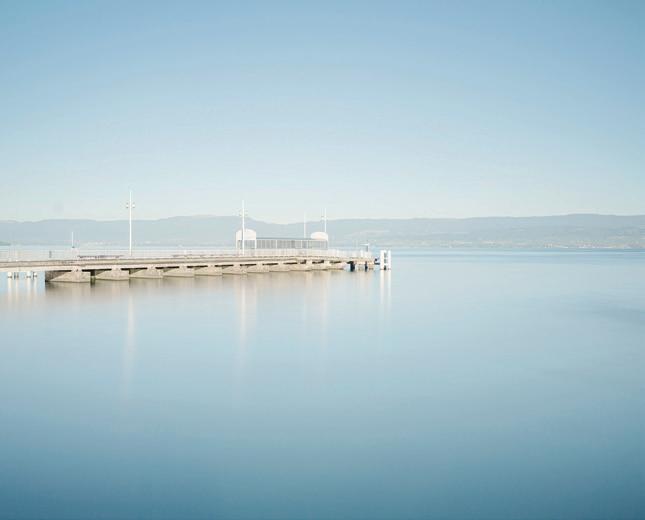
Es gibt Gegenden, die zur Leichtigkeit des Seins, zum Innehalten und zur Rückkehr inspirieren. Die Städte rings um den Genfersee, die mit Himmel und Bergen verschmelzen, gehören hierzu. Sie geben das Gefühl, an der Hand geführt zu werden und ein anderes Verhältnis zur Zeit – weit weg von den Strudeln des Lebens – zu entwickeln und die Seele baumeln zu lassen. Überragt von einem allgegenwärtigen Himmel gleitet das Schiff an verschlafenen Dörfern und an brachliegenden Feldern vorbei, deren baldiges Erwachen aus dem Winterschlaf fühlbar ist. Von Nyon sind es nur wenige Minuten mit dem Schiff bis zum mittelalterlichen Dorf Yvoire, wo ein frischer Wind entgegenbläst und ein malerischer, seinesgleichen suchender Horizont alle Sorgen zerstreut. Die Zeit bleibt für einen kurzen Augenblick stehen und lässt die Umrisse einer Landschaft durchscheinen, in der ein altes Erbe mit seiner Gegenwart verschmilzt. Erinnerungen kommen auf, und die Kraft des Windes zerstreut Sorgen und Traurigkeit. Die von der CGN zusammengestellten Routen bieten ein neues Reiseerlebnis, das sich nicht in Worte kleiden lässt. Man muss es am eigenen Leib erfahren.
Angebot: Dank der Mitwirkung der örtlichen Tourismusbüros, die ihr Wissen über die Region weitergeben, finden Sie an Bord Informationsmaterial zu den beiden Ausflügen Geneva Tour und Lavaux Tour. Diese enthalten zahlreiche Anregungen, um die schönsten französischen und Schweizer Dörfer zu entdecken oder wiederzuentdecken.
Lied: Genève, Marc Aymon (W. Sheller / W. Sheller)
Die idyllisch am Ufer gelegenen Häfen sind Ausgangs- und Endpunkt einer erlesenen Reise. Eine Fahrt auf dem See verspricht eine unterhaltsame und die Neugier weckende Erfahrung, um eine neue Art der Fortbewegung wiederzuerleben. Es entsteht der Eindruck, als ob die Zeit anders und ohne Irrungen und Wirrungen vergeht. Zeit, eine neue Unbeschwertheit zu geniessen und einen Gang zurückzuschalten – so als wäre jeder Tag ein Sonntag. Der See weckt neue Fantasien und die Lust, über samtweiches, kristallklares Wasser zu gleiten, bevor es zurückgeht an Land und die Stimmen der Zivilisation wieder hörbar sind. Nach Verlassen des Schiffes schweift der Blick auf eine gut erhaltene Natur, Schilfflächen, malerische Horizonte, plötzlich aufblitzende blendende Lichter und abfahrende Schiffe, während sich im Hintergrund die unübersehbaren Gebirgsmassive des Genfersees abzeichnen.
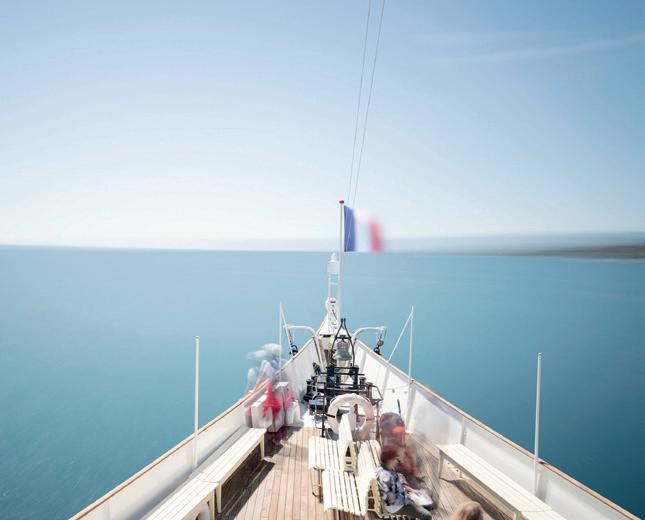
Event: Wochenende mit Tag der offenen Tür der CGN-Werft in Ouchy am 15. und 16. April. Stände und Workshops ermöglichen, die verschiedenen Berufe der Gewerbetreibenden am See zu entdecken, wie Fischer, Rettungskräfte, Schreiner usw.
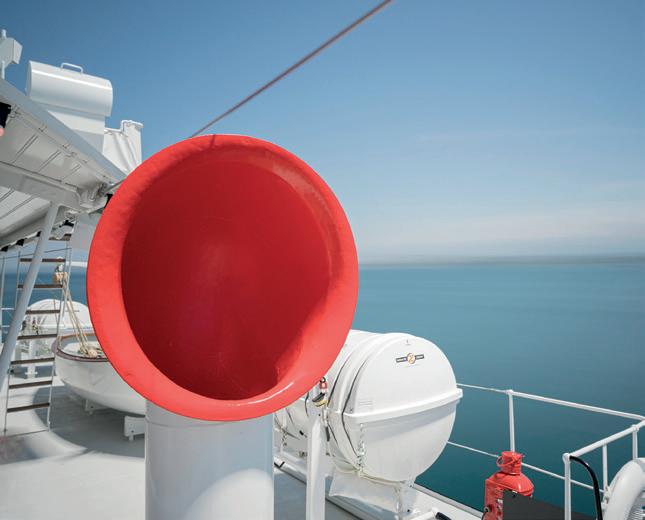
Lied: Une Louise dans chaque port, Michel Bühler (J. V. Gilles / J. V. Gilles)
Mai : Die Belle Époque-Flotte
Die Parade-Navale der CGN zählt zu den Pflichtterminen am Genfersee. Dieses Event ist ein Stelldichein der Schiffe der Belle Époque-Flotte und zieht Jahr für Jahr viele Besucher zu den Ufern des Genfersees. 2023 werden die Montreux (1904), die Vevey (1907), die Italie (1908), die La Suisse (1910), die Savoie (1914), die Simplon (1920) sowie die frisch restaurierte Rhône (1927) mit von der Partie sein. Die Merkmale dieser

88 À TOUTE VAPEUR / / / FULL STEAM AHEAD / / / MIT VOLLDAMPF VORAUS
Schmuckstücke sind ein Leckerbissen für Fans: Ob aus Holz geschnitzte, mit Goldfolie überzogene mythische Bugfiguren, die Original-Dampfmaschinen, fein glänzende Intarsien und innere Holzverkleidungen aus hochwertigen Materialien – jedes noch so kleine Detail vermittelt den Eindruck, in eine vergangene Zeit einzutauchen. Wer sich diese Schiffe, die einst den hohen europäischen Adel beförderten, als in der Schweiz ein Luxustourismus entstand, genauer ansieht, kann sich dem Reiz der Umgebung, der sich bei einem Blick durch die Fenster offenbart und an die Gemälde Ferdinand Hodlers erinnert, kaum entziehen. Nicht zuletzt fasziniert die Belle Époque-Flotte aber auch deswegen, weil sie die Möglichkeit bietet, die wohlgerundete Form der Schiffe zu erleben, bei denen die Erhaltung eines herausragenden Erbes mit hochmoderner Technologie verschmilzt, wodurch Vergangenheit und Gegenwart zusammenwachsen. Eine Erfahrung, die allen offensteht.
Event: Parade-Navale am 14. Mai 2023 in Morges. Tag mit zahlreichen Animationen.
Lied: Le Vieux Léman, Aliose (E. Rambert / J. Bovet)
dieses einmalige Naturerbe zu bewahren. Das Vogelreservat lädt ein zum grenzenlosen Verweilen.
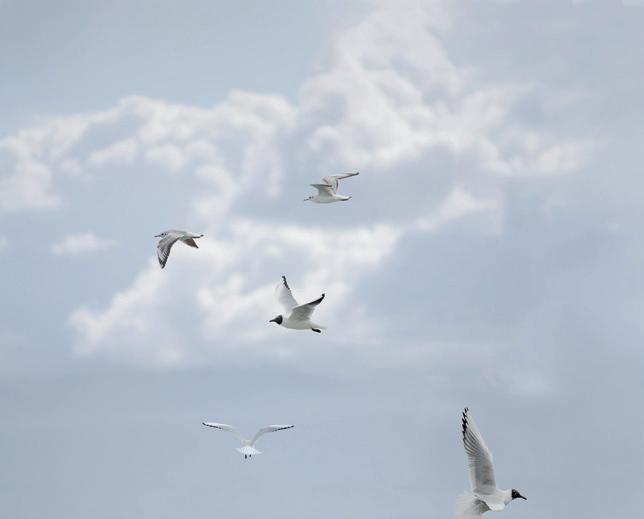
Angebot: Verbilligte Fahrten in die Naturschutzgebiete des Genfersees.
Lied: Bec dans l’eau, Milla (J. Kisling / J. Kisling)
August : Parks und Gärten rund um den Genfer See
Juni : Die Fauna am Genfersee
Rund um ankernde Boote verschwimmen Farben und muten an wie die Wallungen eines in ein Wasserglas eintauchenden Pinsels. Himmel und See sind durch das inzwischen gedämpfte Licht nicht mehr voneinander zu unterscheiden. Und doch befindet sich dort ein wohlgesinntes und zeitloses Umfeld, in dem sich Drosselrohrsänger, Stockenten und Fischer mit ihren Booten und marineblauen Mützen tummeln.
Die Ufer des Genfersees sind ein Paradies für Tiere. Neben Enten, Schwänen und Zugvögeln sind hier zahlreiche Nagetiere wie der Biber und der Siebenschläfer beheimatet. Das Naturschutzgebiet Les Grangettes in Villeneuve ist ein wichtiges Feuchtgebiet und ein Rückzugsort für die Tierwelt. Ein Streifzug über die Pfade dieser aussergewöhnlichen Naturlandschaft ist ein Must – beispielsweise durch eine Wanderung bis Bouveret mit anschliessender Schifffahrt zurück nach Villeneuve. Um die besondere und seltene Artenvielfalt dieses Ortes zu erhalten und zu vermeiden, dass der Wald auf die Sümpfe übergreift oder Pflanzen die Teiche überwuchern, ist eine Pflege unabdingbar. Die Fondation des Grangettes setzt sich dafür ein,

Juli: Das Naturerbe
Die als UNESCO-Weltkulturerbe eingestufte Weinbauregion Lavaux über dem Genfer See bietet saisonunabhängig ein überwältigendes sensorisches Erlebnis. In dieser Region sind Superlative an der Tagesordnung. Die beste Sicht auf dieses einzigartige Gebiet bietet die Reling eines Schiffes. Während sich einige jahrhundertealte Dörfer in entlegenen Winkeln verstecken, erstrecken sich andere unübersehbar über die Hügel. Dabei hat es den Anschein, als hätten sie sich hier wie von Zauberhand inmitten der grünen Rebenpracht angesiedelt. Geranien mit ihren luftigen Blütenblättern schmücken Fenstersimse, und die kleinen Plätzchen unter dem Schatten hundertjähriger Kastanienbäume versprühen einen ganz besonderen Charme. Die Landschaft ist ausnahmslos reizvoll und strahlt besondere Harmonie aus. Die steilen Terrassenhänge, die zu den Highlights des Weltnaturerbes gehören, wurden im 12. Jahrhundert auf Ersuchen des Bischofs von Lausanne von Zisterzienser-Mönchen angelegt, die einst in der Abtei Haut-Crêt nahe Oron lebten. Die Konturen des Weinbaugebiets Dézaley entstanden durch unablässige Arbeit über 200 Jahre. Das lokale Klima wird stark vom See beeinflusst, der die Temperaturschwankungen verringert, und umfasst keine übermässige Trockenheit in den Sommermonaten. Im Winter wechseln sich bei bisweilen rauer Witterung Kälte und Tauwetter ab. Diese Besonderheiten verkörpern die Seele dieser aussergewöhnlichen, von den Göttern verwöhnten Region.
Angebot: 30% Ermässigung (nur Beförderung, nicht mit anderen Angeboten kumulierbar) für alle Fahrten im Rahmen der Lavaux Tour.
Lied: À Saint-Saph, Michel Bühler et Marc Aymon (M. Aymon / M. Aymon)
Parks und Gärten können gross und klein oder öffentlich zugänglich sein, sich aber auch hinter Zäunen verstecken. Andere wiederum sind auf dem Wasser, überziehen kleine Inseln mit unberührten Wäldern oder führen ins Wasser und bedecken das Ufer mit einem grünen Schleier. Bei einer Fahrt entlang der Ufer des Genfersees bietet sich ein einmaliger Blick auf unzählige Gärten und Parks. Von Genf mit seinen beiden Parks Pré Byron oder Perle du Lac über die Île de la Harpe vor der Stadt Rolle bis Évian mit seinen Wassergärten reiht sich Augenweide an Augenweide.
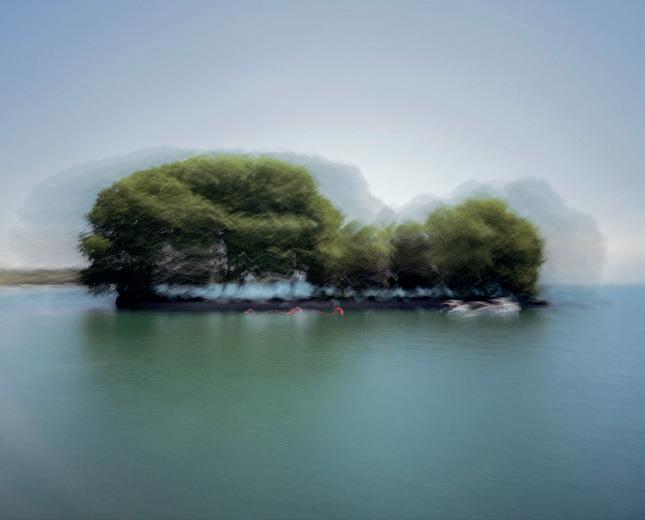
Von dort geht es schliesslich zum Jardin des Cinq Sens inmitten der mittelalterlichen Stadt Yvoire, der zu einem sensorisch ungewöhnlichen Spaziergang einlädt. Dieses 2500 m2 grosse Gelände verspricht von April bis Ende September ein einzigartiges Erlebnis. Ein Potpourri aus 1500 Pflanzenarten mit einer Alpwiese als Anspielung auf die angrenzenden Alpen, ein Unterholz mit Schattenpflanzen, ein renaissanceartiges gewebtes Kunstwerk und ein Kreuzgang in Form eines Laubengangs bieten Zeit und Gelegenheit für Reflexion. Sämtliche Gärten bieten ein sensorisches Erlebnis mit Schauen, Berühren, Schmecken und Riechen. Für besonderen Hörgenuss sorgen das Rauschen des Wassers und das Zwitschern der Vögel. Dieser seit 30 Jahren minutiös gepflegte Ort versprüht Leben und Zeitlosigkeit. Besonders zu empfehlen ist der Besuch an einem Sommernachmittag, wenn die Düfte der Blumen und die exotische Atmosphäre allgegenwärtig sind. Ein sinnlicher Ort ganz nach Manier Baudelaires und ein Pflichttermin für alle, die den Charme der verträumten Seeufer und die Reinheit einer stillen Natur geniessen wollen. Kurz – ein ganz besonderer Treffpunkt.
Angebot: 30% Ermässigung auf die EVASION-Tour entlang der französischen Seite mit Besuch der mittelalterlichen Stadt Yvoire.
Lied: Le Jardin anglais, François Vé (P. Katerine / P. Katerine)
À TOUTE VAPEUR / / / FULL STEAM AHEAD / / / MIT VOLLDAMPF VORAUS 89 Deutsch
September: Innovation
Die CGN hat sich ehrgeizige Ziele gesetzt und will Innovation, Tradition und Mobilität zu Prioritäten machen, um ihren Auftrag als Akteurin für Nachhaltigkeit rund um das Genfersee-Becken weiterzuverfolgen. Namens Evian-les-Bains, das erste der NAVIEXPRESS-Schiffe, ein mit Hybridantrieb und 600 Sitzplätzen ausgestattetes Passagierschiff, ist ein neues Aushängeschild der Flotte der Gesellschaft. Das leistungsfähige und nachhaltige Wasserfahrzeug soll Pendlern schmackhaft machen, die Strecke von Évian nach Ouchy auf dem Wasserweg zurückzulegen.
Durch ihren Aluminiumrumpf und ihre innovativen Schiffsschrauben ist der neueste Stand der Schiffbautechnik in die NAVIEXPRESS eingeflossen. Dank der Nutzung von Fotovoltaikmodulen auf dem Dach und einer Beschichtung aus extrem leichten Verbundwerkstoffen wird bei Fahrten mit der NAVIEXPRESS zwischen Frankreich und der Schweiz 30 Mal weniger CO2 ausgestossen als bei der Fahrt mit dem Pkw. Ziel ist ein Beförderungsstandard, der im Hinblick auf Komfort, Stabilität und Taktfahrplan mit den Möglichkeiten der Eisenbahn vergleichbar ist.
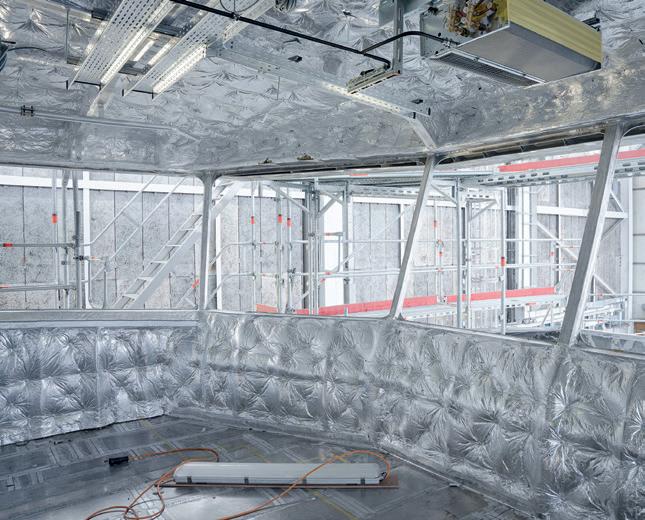
Angebot: Erkundungsfahrten mit der NAVIEXPRESS
Lied: Droit devant, Aliose (A. Oswald – X. Michel / E. Franzén – R. Descampe)
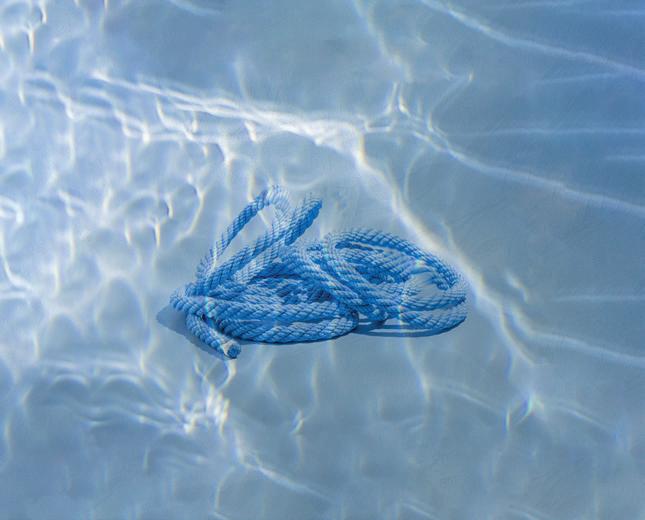
Lavaux, die kleinen Hügel auf den Genfer Anhöhen oder die grünen Abhänge der Weinbauregion La Côte sind das Zuhause der Weinreben.
Die Wolken hängen tief, sind anthrazitfarben und regengetränkt. Diese Landschaft lässt sich am besten zu Fuss über kleine Wege erkunden, die von goldfarbenen Blättern und blühenden Weinreben gesäumt sind. Die drückende Hitze und die von Petrichor durchströmte Luft, die sich immer nach Regen einstellt, machen das Panorama zu einem noch intensiveren Erlebnis. Alles hat den Anschein, als ob im nächsten Augenblick ein grosses Chaos einsetzt, der donnernde Himmel zürnt und die Regentropfen nur auf das letzte Zeichen warten, um die Landschaft mit Wassermassen zu übergiessen. In einiger Entfernung ertönt ein Glockenturm, bevor das Rascheln des Windes, das Brummen der Insekten und das Geräusch des Wasserstrahls überhandnehmen. Die Dorfältesten wissen es längst: Der Ablauf ist immer der gleiche. Der Lebenskosmos hier ist einzigartig und vergleichbar mit einem eigenständigen Organismus. Der Schutz der Artenvielfalt, die Demut und die Verbundenheit mit dieser Region sind die Grundfeste der Harmonie dieser Landschaft. Auf den Anhöhen des Sees sind die Winzer tagtäglich im Einsatz, denn Spitzenweine entstehen in den Reben.
Angebot: Degustationsfahrt an Bord der CGN-Schiffe. Eine Möglichkeit, Land und Wasser, das Gemüt dieser Orte und ihrer Seele inmitten dieses unermesslichen Panoramas zu erleben.
Lied: Vigne, François Vé (F. Vé / F. Vé)
Verwaltung – sie alle verbindet die Liebe zu ihrem Beruf. Eine unverfälschte Hingabe, die beim Betreten des Pontons sofort spürbar ist. Eine besonders ergreifende Erfahrung in Gegenwart jener Frauen und Männer, die tagtäglich um die Erhaltung eines Kulturerbes im Herzen einer geschichts- und emotionsbeladenen Region bemüht sind – umgeben von Glockentürmen, die mit der Präzision eines Schweizer Uhrwerks erklingen.
Event: Kinder können in der Werft die Handwerke in Zusammenhang mit der Schifffahrt kennenlernen.
Die CGN wird auf der Swiss Boat Show vom 11. bis 12. November 2023 im Palexpo in Genf zugegen sein.
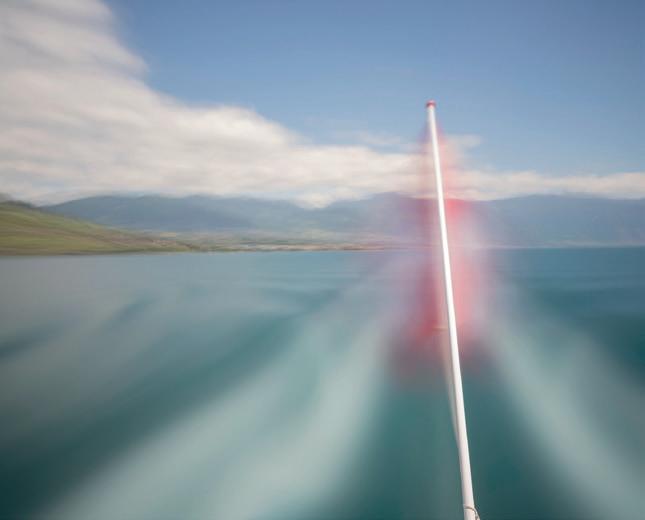
Lied: Gentille Batelière, Jérémie Kisling (auteurs et compositeurs inconnus)
Dezember: Solidarität
Oktober: Weine des Genfersees
Dank des milden Klimas der Region und der generationenumspannenden Bemühungen der Winzer, die eine Harmonie mit der sie umgebenden und ernährenden Natur anstrebten, kommen hier einzigartige Rebsorten voll zur Geltung. Die übereinander liegenden Terrassen und die Steinmauern von
November: Berufe in der Schifffahrt
Die Compagnie Générale de Navigation steht für 150 Jahre grosse und kleine Geschichten, einzigartiges Fachwissen und eine Leidenschaft, die der Gischt des Genfersees in nichts nach steht. Zu nennen sind aber auch der Zusammenhalt eines Teams, das Authentizität und Traditionen erhalten will, sowie die Solidarität und das zu einem gemeinsamen Ziel führende Engagement. Die Synthese dieser Eigenschaften verschmilzt zur Identität der CGN, um den Fahrgästen ein optimales Reiseerlebnis zu bieten und das Gefühl einer Fahrt auf dem See zu vermitteln.

Ob Kapitän, Matrose, Steuermann, Maler, Handwerker, Tischler, Mechaniker oder Ingenieur, Mitarbeitende an der Kasse oder in der
Die Vormittage der ersten Dezember-Tage sind dunkel und bedrückend. Die Luft hat sich durch die Brise jäh abgekühlt – so als lieferte sich der See bisweilen ein Versteckspiel mit dem Nebel, in dem die Orientierung verloren geht. Man fröstelt, wenn sich das intensive Läuten der Glockentürme breitmacht. Bevor sonnendurchflutete Tage die Fenster wieder aufgehen lassen und das Leben an den See zurückkehrt, schliesst sich die CGN am Jahresende mit karitativen Vereinigungen zusammen, um hungernden Menschen zu helfen. In diesem Rahmen findet eine abendliche Benefizveranstaltung statt, und an Bord eines Schiffes werden warme Mahlzeiten verteilt. Mit dem Projekt sollen die Schaffung einer sozialen Bindung und die gegenseitige Hilfe aufgewertet werden – samt umfassender Unterstützung. Ziel ist die gegenseitige Achtung, wenn Gesichter mit Freude erfüllt sind und fröhliche Gesinnungen überhandnehmen. Eine Ode an das Leben, den Augenblick und die Ausgeglichenheit. Noch ist alles beim Alten, aber die wunderbare Veränderung ist bereits spürbar.
Event: Benefizabend: Informationen unter www.cgn.ch/150ans
Lied: Suis-je bien arrivé ?, Marc Aymon (J. Kisling / M. Aymon)
90 À TOUTE VAPEUR / / / FULL STEAM AHEAD / / / MIT VOLLDAMPF VORAUS
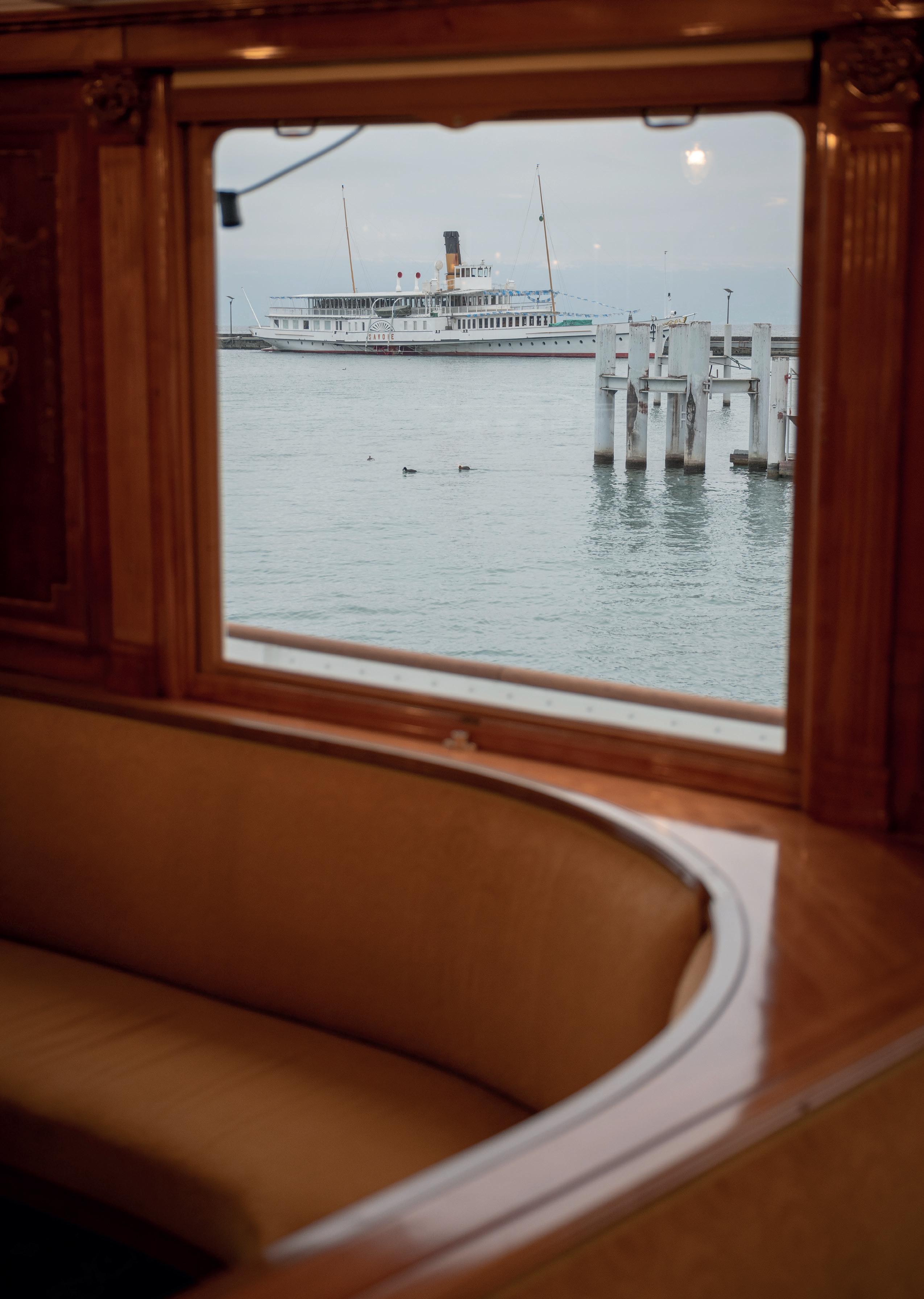
© Clément Grandjean
UNE EXPÉRIENCE INOUBLIABLE
3h15 sans changement
Classe Prestige
Produits du terroir
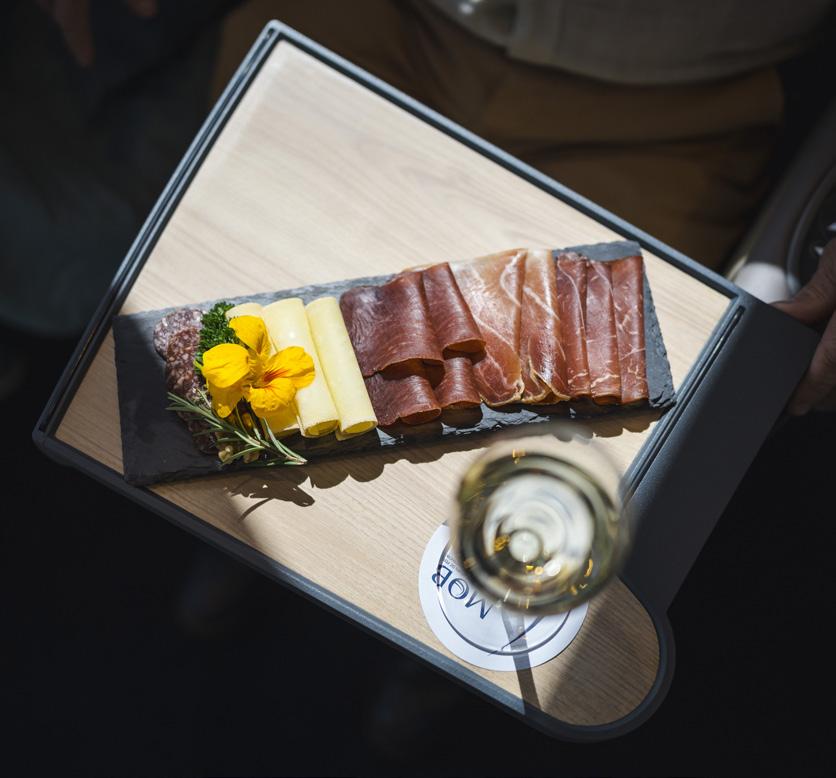
DÈS LE 11 JUIN 2023 : 4 départs quotidiens depuis Montreux et Interlaken
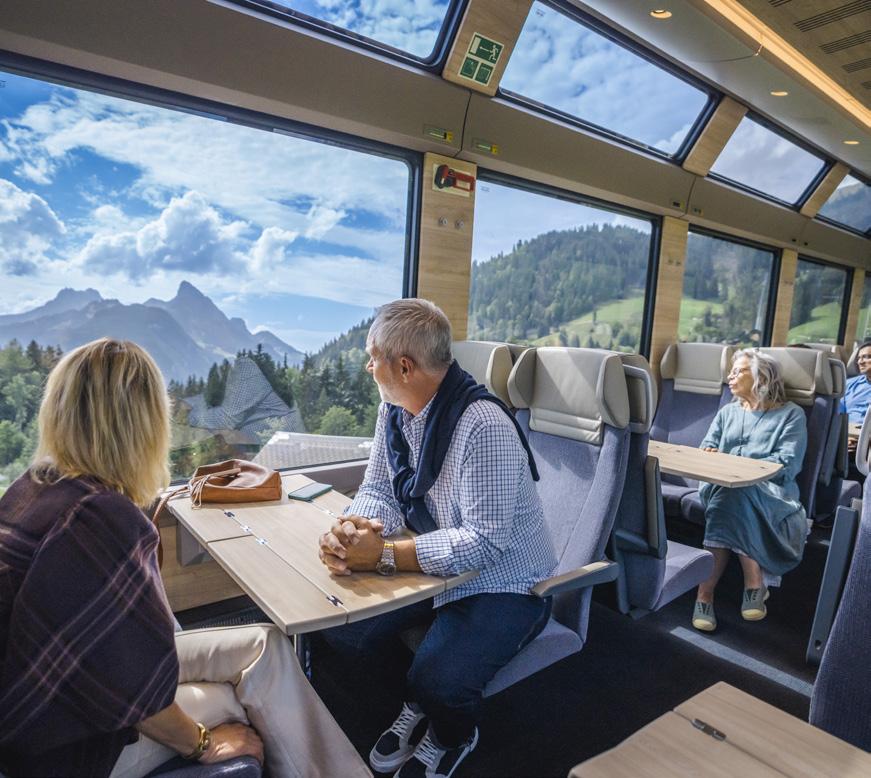
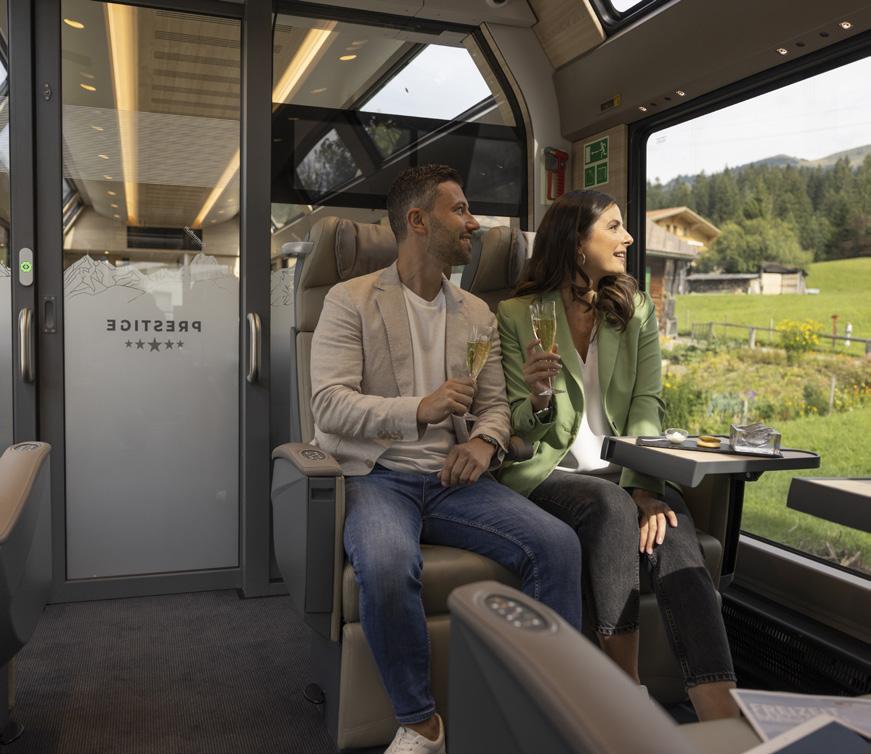

92 À TOUTE VAPEUR / / / FULL STEAM AHEAD / / / MIT VOLLDAMPF VORAUS PREMIUM SWISS TRAVEL EXPERIENCE gpx.swiss
MONTREUX – GSTAAD – INTERLAKEN

 Maison Henri Badoux Henri-badoux.ch
Maison Henri Badoux Henri-badoux.ch































































 © Collection du Musée du Léman
/ Nicolas Lieber (photo)
© Collection du Musée du Léman
/ Nicolas Lieber (photo)





 © Collection du Musée du Léman/Nicolas Lieber (photo)
© Collection du Musée du Léman/Nicolas Lieber (photo)





 © Jacques Straesslé / Clément Grandjean
© Jacques Straesslé / Clément Grandjean



























































































